NHK WORLD > NHK WORLD TV > BENTO The Global Lunchbox Project
-
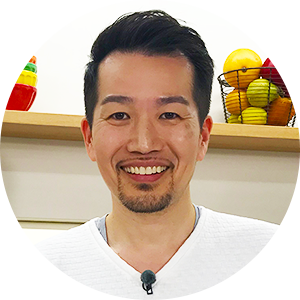
- Marc Matsumoto
-
Marc Matsumoto is a private chef, culinary consultant and TV presenter with a base of clients around the world. Born in Japan, and raised between the US and Australia, Marc developed an early love for travel and a broad palette of global flavors. He believes that by making wholesome delicious food accessible to people of all backgrounds, the world becomes a better place.
-

- Maki Ogawa
-
Maki Ogawa's books have been translated into three languages and are sold around the world. Yum Yum Bento Box is credited with starting the recent bento boom. She also loves to post pictures and recipes on social networks like Facebook and Instagram and she's been featured by news outlets from around the world. Many of her bento ideas come about when she's cooking for her two sons. Fans love her delicious, easy-to-make, kawaii bento ideas!
-
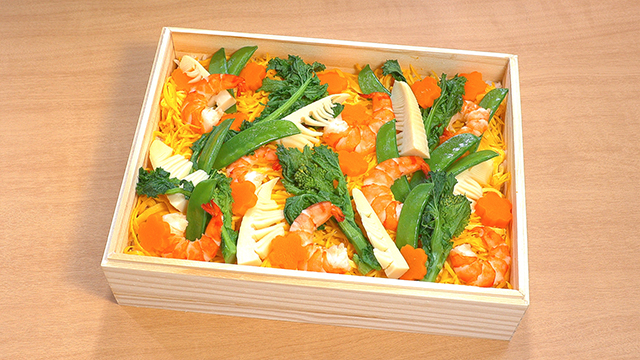
- BENTO RECIPES
- from Episode 20 / Season 8.
- Spring Blossom Chirashi-sushi Bento
- (1578 kcal)
-
 by Marc Matsumoto
by Marc Matsumoto
Makes enough to pack into 1 large bento
Ingredients:
For Sushi Rice
- 2 rice cooker cups rice
- 1 tbsp toasted sesame seeds
- Sushi vinegar (You can replace this with ready-made sushi vinegar)
- 6 tbsp rice vinegar
- 4 1/2 tbsp sugar
- 1 1/2 tsp salt
For Kinshitamago
- 2 large eggs
- Pinch of salt
For toppings
- 710 ml dashi stock (3 US cups)
- 1 1/2 tsp salt
- 1 carrot (sliced about 7 mm thick)
- 80 g canned whole bamboo shoot tips (cut into bite-sized spears)
- 80 g mustard greens
- 25 g small snow peas, trimmed
- 100 g shelled and deveined 21/25 shrimp
Directions:
1. Prepare the rice following your rice cooker's directions, but reduce the amount of water by two tablespoons.
2. While the rice cooks, make the sushi vinegar by whisking the rice vinegar, sugar, and salt until the solids dissolve.
3. When the rice is cooked, transfer it to a large bowl and fluff it with a rice paddle.
4. Drizzle 80 milliliters of the sushi vinegar onto the rice along with the toasted sesame seeds and fold them into the rice. While doing so, have someone else fan the rice to cool it rapidly.
5. When the seasonings are integrated, and the rice is lukewarm, cover it with a damp towel and prepare the toppings.
6. For the Kinshitamago, beat the eggs with a pinch of salt until they are uniform in color.
7. Pass the egg through a tea strainer to remove any clumps.
8. Heat a 10-inch non-stick skillet over medium heat until hot, but not sizzling hot. Then lightly grease it with a paper towel soaked with some vegetable oil.
9. Reduce the heat to low, pour half of the egg mixture into the pan, and then quickly swirl it around the pan to make a thin, even layer.
10. Cook the egg until the edges start to dry out and pull away from the pan.
11. Flip the egg over and cook for a few seconds until the egg is fully set.
12. Transfer the egg to a cutting board and repeat with the remaining egg mixture.
13. When your second egg omelet is done, stack it on top of the first and then roll it up.
14. Use a sharp knife to cut the rolled eggs into thin threads.
15. Cut the carrot slices into flower shapes using a vegetable cutter.
16. Bring the dashi stock and salt to a boil and cook the carrots and bamboo shoots in the dashi until the carrots are tender (about 10-12 minutes). Transfer the vegetables to a tray using a slotted spoon and set aside.
17. Add the snow peas to the dashi and cook until vibrant green (about 30 seconds). Use a slotted spoon to transfer to the tray.
18. Add the mustard greens to the dashi and cook for about 1 minute. Use tongs to transfer them to the tray and set aside.
19. Add the shrimp to the boiling dashi stock, then turn off the heat. Let the shrimp poach for 1-2 minutes or until vibrant orange and no longer translucent.
20. Drain the shrimp. When cool enough to handle, slice each shrimp in half to create two mirrored slices of shrimp.
21. Add the shrimp to the bowl with the remaining sushi vinegar and stir to coat. Let the shrimp marinate in the vinegar until all the toppings have cooled to room temperature.
22. To assemble the Chirashi-sushi, spread the sushi rice along the bottom of a large bento box.
23. Top the rice with an even layer of Kinshitamago.
24. Drain the shrimp, squeeze out any excess liquid from the mustard greens, and arrange them with the snow peas, bamboo shoots, and carrots to create a spring garden.
-
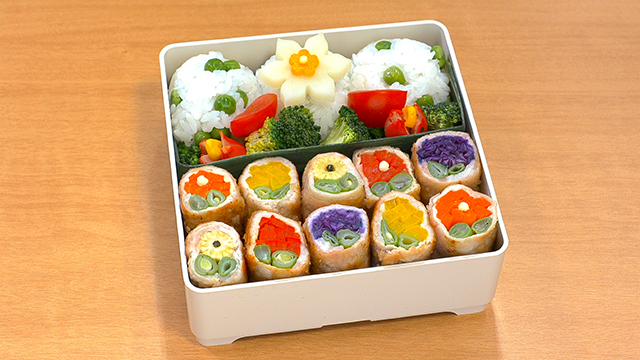
- BENTO RECIPES
- from Episode 20 / Season 8.
- Maki-maki Flower Bento
- (824 kcal)
-
 by Maki Ogawa
by Maki Ogawa
Bento contents:
- Onigiri with Green Peas
- Maki-maki Flowers
- Sausages
- Baby corn
- Broccoli
- Cherry tomatoes
- Daffodil decoration
- Bamboo leaf (for use as a partition)
Ingredients:
For the Maki-maki Flowers(5 rolls)
- 5 slices pork loin (thinly sliced) (150 g)
- 1 baby corn
- 15 g red cabbage
- 1/2 small yellow bell pepper
- 15 g carrot
- 1/2 small red bell pepper
- 10 string beans (approx. 3 g each)
- A little potato starch
- A pinch each of salt and pepper
- 2 tsp vegetable oil
- 1 tbsp soy sauce
For Onigiri with Green Peas (yields 3)
- 150 g cooked rice
- 25 g frozen green peas
- A pinch of salt
For Daffodil decoration
- 10 g potato (4 mm slice)
- A small piece of sliced processed cheese
- A small piece of sliced cheddar cheese
Directions:
For the Maki-maki Flower Rolls
1. Boil the green beans and carrot (3 mm slices) for 2 minutes.
2. Add the bell peppers and boil for one more minute.
3. Drain and cut into thin strips.
4. Cut the red cabbage into long shreds, rub with salt, and squeeze out the excess moisture.
5. Place the bell pepper strips on top of the pork, and cover the bell peppers with two green beans.
6. Press and roll firmly.
7. Repeat the process with the carrots and red cabbage. Make sure the green beans go on top of the veggies.
8. Now make another roll, placing the young corn on top of the green beans.
9. Sprinkle with salt and pepper.
10. Sprinkle a baking tray with potato starch to coat the rolls evenly.
11. Place the rolls seam-side down in an oiled pan, then place the pan over heat.
12. Turn the rolls over and fry for about 2 minutes until evenly browned.
13. Cover and cook through (1-2 minutes).
14. Uncover and drizzle with soy sauce.
15. Cool and cut into pieces to fit the height of your bento box.
16. Decorate the center of the rolls with cheese and nori.
For the Onigiri with Green Peas
1. Place the frozen peas in a bowl and thaw by pouring boiling water over them.
2. Drain the peas and fold into freshly cooked rice with a pinch of salt.
3. Divide into three equal portions to shape into round onigiri.
For the Daffodil decoration
1. Simmer the potato over low heat for 4 minutes until the color changes.
2. Cut out with a daffodil-shaped cookie cutter.
3. Cut out the cheddar cheese with a flower-shaped cookie cutter.
4. Use a thin straw to cut out the processed cheese.
5. Place the cheese flower on top of the potato daffodil, and add the processed cheese in the center.
6. Place on top of the onigiri.
-
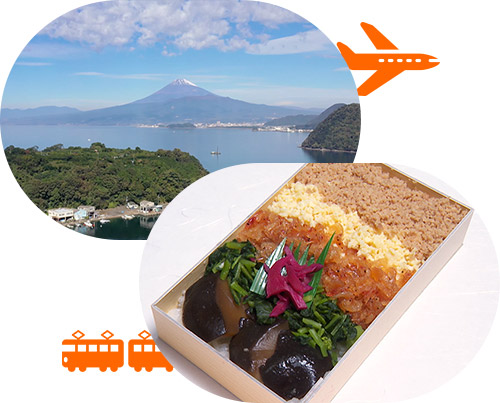
- BENTO TOPICS
- from Episode 20/ Season 8.
- Shizuoka
-
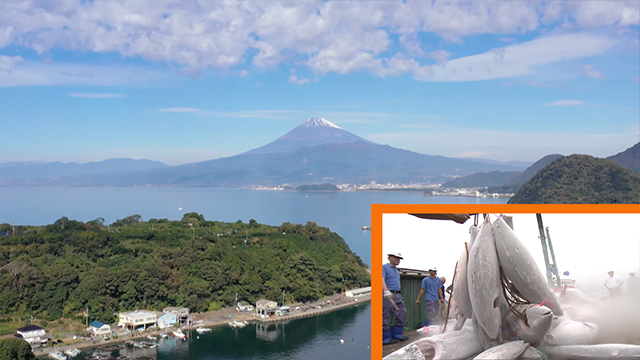
Bento Topics. Today, from Shizuoka Prefecture's stunning and bountiful Izu Peninsula. The area offers great views of Mt. Fuji.
Shizuoka boasts the largest landing of tuna in Japan. Izu is home to a local specialty made with this catch. -
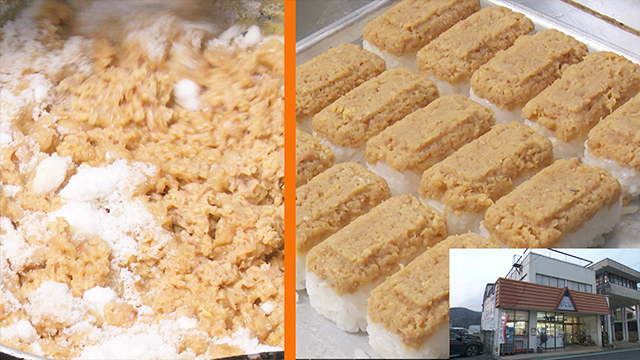
It’s called oboro-sushi. The tuna is flaked and seasoned with sugar and soy sauce to make a sweet rice topping called oboro. This is then packed into a mold with sushi rice to make the local specialty.
Ishii Norie follows her grandmother’s recipe to make the oboro-sushi she sells at her store. -
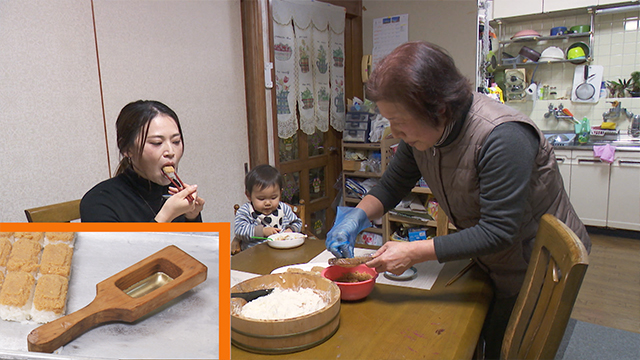
In the past, oboro-sushi was made at home using molds like this one. Today, Ishii has invited her family to join her in making the sushi with these traditional molds. The sushi rice and oboro is packed into the mold. It's then flipped over and tapped to reveal the sushi.
-
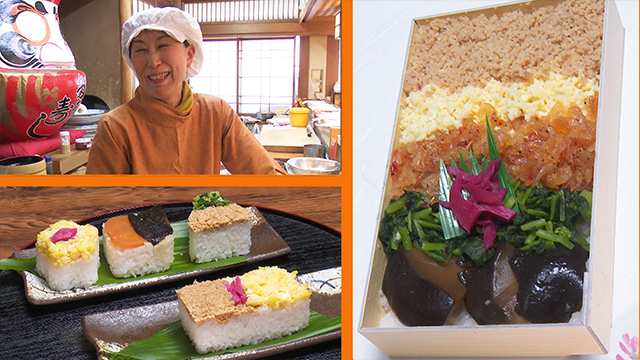
Oboro-sushi has made its way into a popular ekiben created by the owner of a long-established sushi restaurant. She turned the beautiful oboro-sushi that her grandmother used to make into an easy-to-eat bento. It’s packed with the bounties of both sea and land.
-
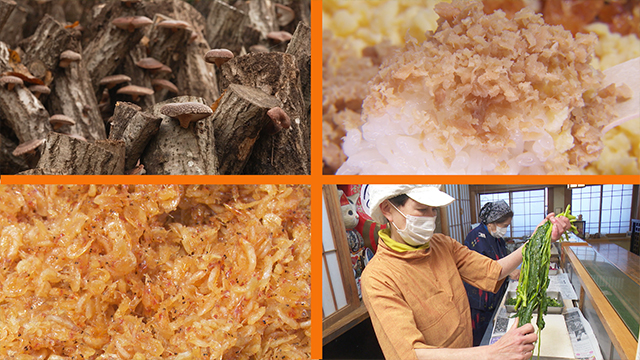
The sweet and savory shiitake mushrooms are a local specialty. They're grown on logs and raised with the utmost care. The bento uses reconstituted dried shiitake soaked in water for two days.
The bento also includes seafood: tuna oboro and deep-fried candied sakura shrimp. The salted mizukakena greens, grown with Mt. Fuji’s groundwater, provide a contrast to the sweet toppings. -
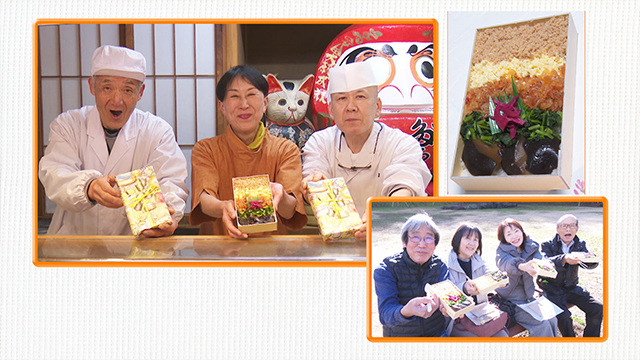
Today, some regular customers have come to pick up bentos for a picnic. Enjoy the bounties of Izu’s land and sea!
-
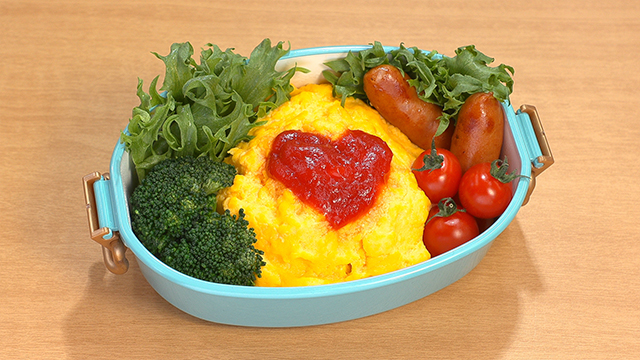
- BENTO RECIPES
- from Episode 19 / Season 8.
- Quick Omurice Bento
- (669 kcal)
-
 by Marc Matsumoto
by Marc Matsumoto
Bento contents:
- Omurice
- Ketchup
- Broccoli
- Lettuce
- Cherry tomatoes
- Whole sausage
Makes enough to pack into 2 bentos
Ingredients:
- 330 g day-old rice, crumbled
- 1 tbsp butter
- 60 g smoked cocktail sausages, sliced
- 40 g onion, minced
- 2 tbsp ketchup
- 1 tsp soy sauce
- 1 tsp potato starch
- 1/8 tsp salt
- 120 ml milk (1/2 US cup)
- 2 eggs, beaten
Directions:
1. Add the butter, sliced sausage, and onions to a frying pan and sauté until the onions are tender and translucent.
2. Add the rice and stir-fry, breaking up any clumps until the rice is warmed through and starting to brown.
3. Add the ketchup and soy sauce and stir-fry to distribute the seasonings evenly.
4. Add the potato starch, salt, and milk in a separate non-stick pan and stir until the starch has been evenly distributed.
5. Put the pan over medium heat and bring the mixture to a full boil while stirring constantly with a spatula.
6. Pour the beaten eggs into the thickened milk mixture and stir rapidly to incorporate, then cook while stirring until the egg is fully cooked.
7. Serve the rice topped with a layer of the egg mixture and garnish with additional ketchup.
-
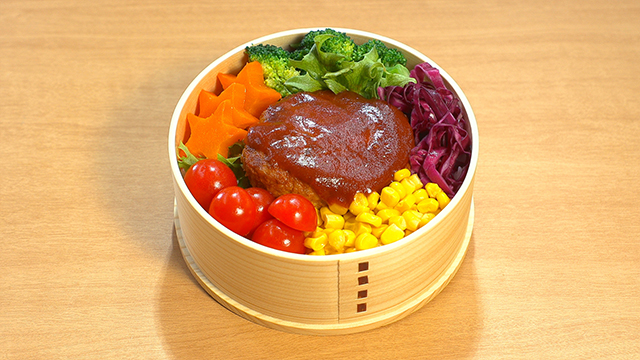
- BENTO RECIPES
- from Episode 19 / Season 8.
- 10-minute Hamburg Bento
- (872 kcal)
-
 by Maki Ogawa
by Maki Ogawa
Bento contents:
- Rice
- Hamburg patties
- Glazed Carrot Stars
- Broccoli
- Sweet pickled red cabbage
- Lettuce
- Buttered corn
- Cherry tomatoes
Ingredients:
For 10-minute Hamburg Patties(yields 3)
- For the patties
- 120 g ground meat (mixed beef and pork)
- 30 g onion (minced)
- 20 g panko
- 1 tbsp milk
- 1 egg, beaten (50 g)
- 1 tbsp (10-12 g) mayonnaise
- A pinch each of salt and pepper
- 1 tbsp vegetable oil
- 50 ml water
- 1 tbsp ketchup
- 1/2 tbsp Worcestershire sauce
For Glazed Carrot Stars
- 3 slices carrot (use a cookie cutter to cut into star shapes)
- 2.5 g butter
- 1 g sugar
- 1/2 tbsp water
- A pinch of salt
Directions:
For 10-minute Hamburg Patties
1. Mix all the ingredients in a plastic bag and knead well.
2. Once the mixture feels sticky, tie the bag and cut off one corner.
3. Add a dash of oil to a cold frying pan and coat using a paper towel.
4. Squeeze the mixture onto the cold frying pan to form 3 patties.
5. Tidy up the shapes and make a well in the center of each patty. Then, place over medium heat.
6. Fry each side for 2 to 2 1/2 minutes until both sides are brown.
7. Add 50 ml of water, cover, and steam-fry.
8. Once 80% of the liquid has evaporated, add the ketchup and Worcestershire sauce and coat the patties.
For Glazed Carrot Stars
1. Use a star-shaped cookie cutter to cut out three carrot stars.
2. Place the stars, butter, sugar, water, and salt in a heat-resistant dish and cover with plastic wrap.
3. Microwave at 500 W for 1 minute. Turn the carrots over and microwave for 1 more minute.
-
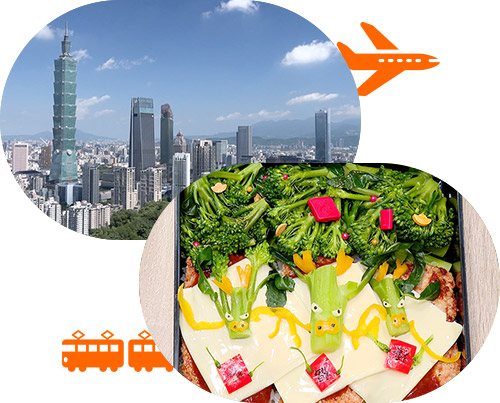
- BENTO TOPICS
- from Episode 19/ Season 8.
- Taiwan
-
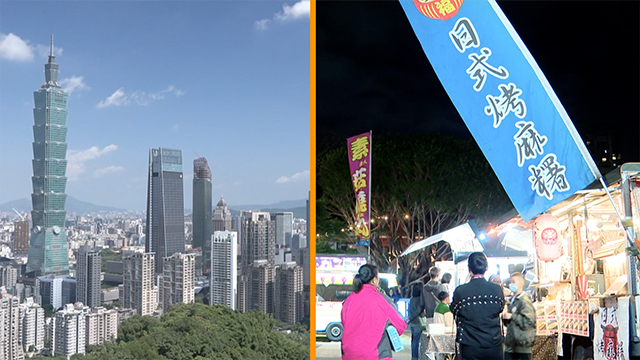
Bento Topics. Today, from Taiwan. Thanks to the large Buddhist population, vegetarian dishes are popular here.
Many people have also become vegetarians for health reasons.
This night market is dedicated to vegetarian street food. -
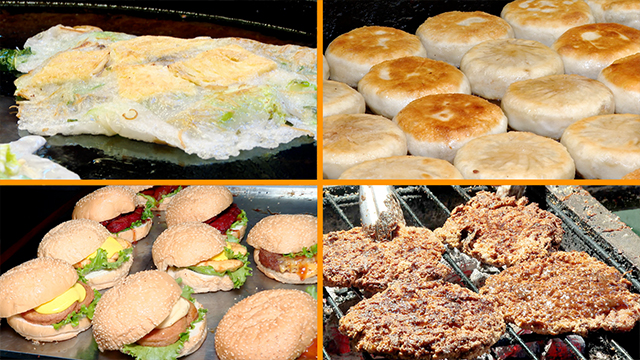
The market is a vegetarian heaven. Here, you can find omelets filled with vegetables and mushrooms, a mushroom-soy meat version of zi pai (super crunchy fried chicken), savory pancakes filled with soy meat, soy meat burgers, and more.
-
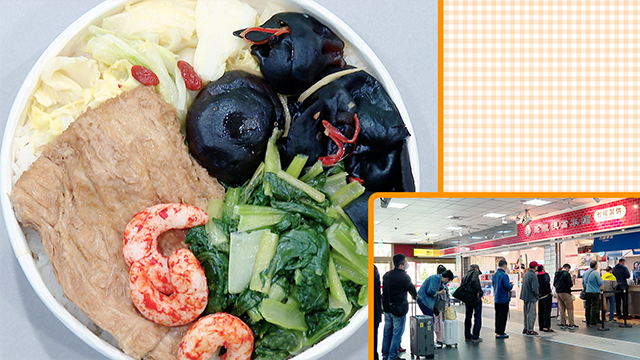
Taipei Station, famous for its ekiben, offers a wide selection of vegetarian bentos. At first glance, this bento appears to contain meat and seafood. But the "shrimp" is actually konnyaku, and the "meat" is made of sweet and savory layered soymilk skin. The bentos are designed to both look and taste good.
-
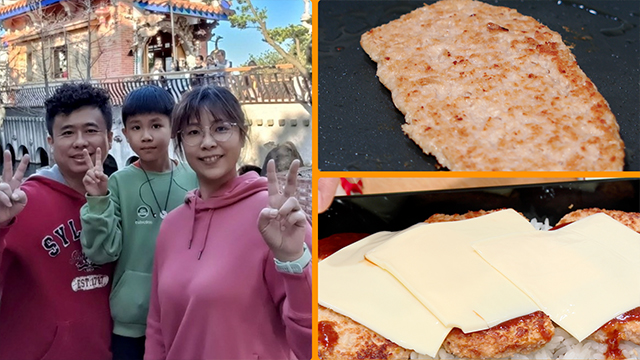
Bento maker Cathy became a vegetarian out of compassion for animals. She makes creative and yummy veggie bentos for her son.
Today, they’re making a bento to celebrate the Year of the Dragon. The main item is a fragrant soy meat "steak" glazed in a barbecue sauce made with doubanjiang, ketchup, ginger, and more. -
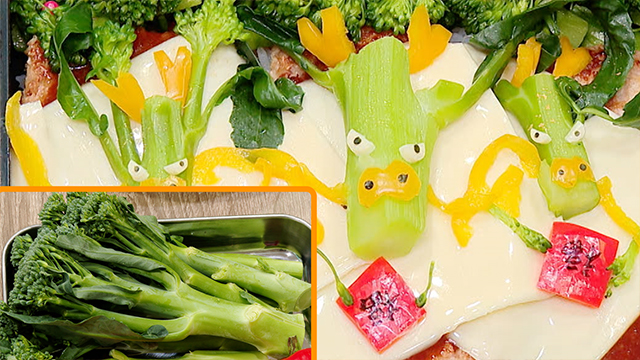
After topping the "steaks" with cheese, she cuts off the florets from broccolini, leaving only the lower stems and leaves. She then makes the dragon decorations with nori, yellow bell pepper, and cheese. She also adds New Year decorations made from red bell pepper and edible ink.
-
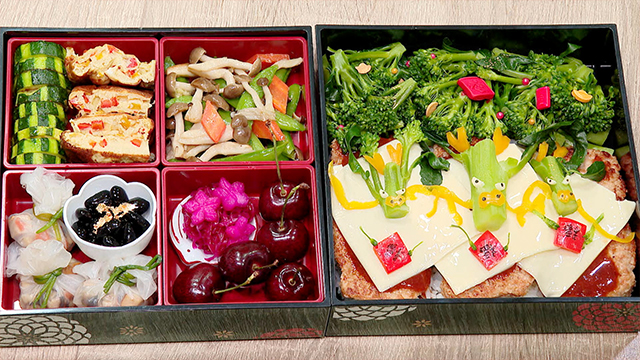
A festive and satisfying bento packed with colorful veggies and fruit, perfect for celebrating the arrival of the Year of the Dragon.
-
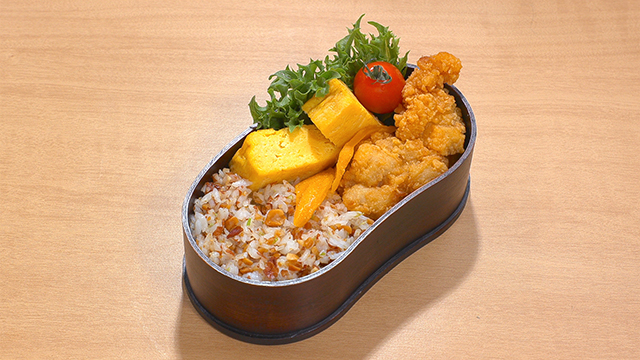
- BENTO RECIPES
- from Episode 18 / Season 8.
- Peanut Fried Rice Bento
- (912 kcal)
-
 by Marc Matsumoto
by Marc Matsumoto
Bento contents:
- Peanut Fried Rice
- Karaage
- Tamagoyaki
- Dried mango
- Broccoli
- Cherry tomato
- Frill lettuce
Makes enough to pack into 3 bentos
Ingredients:
- 1 tbsp toasted sesame oil
- 50 g scallions, minced
- 60 g shelled roasted peanuts with seed coat, roughly chopped
- 1/2 tsp fine sea salt
- 375 g day-old rice, crumbled
- White pepper to taste
Directions:
1. Add the toasted sesame oil and minced scallions to a frying pan and sauté until the scallions start to brown.
2. Add the chopped peanuts and sea salt and sauté until the peanuts are fragrant and brown.
3. Add the rice and stir-fry until the rice is heated through and crumbly.
4. Season with white pepper to taste.
-
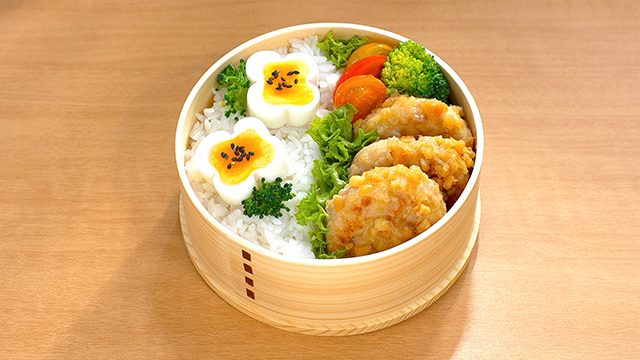
- BENTO RECIPES
- from Episode 18 / Season 8.
- Peanut Tsukune Chicken Bento
- (908 kcal)
-
 by Maki Ogawa
by Maki Ogawa
Bento contents:
- Rice
- Peanut Tsukune Chicken
- Lettuce
- Cherry tomatoes
- Boiled egg flowers
Ingredients:
For Peanut Tsukune Chicken(yields 5 pieces)
- 50 g unsalted roasted peanuts
- 140 g ground chicken thigh
- 10 g potato starch
- 1 tbsp vegetable oil
- 15 g white miso
- 40 g scallions
- 5 g grated ginger
- For the sauce:
- 2 1/2 tbsp sake
- 10 g white miso
- 2 tsp sugar
For the boiled egg flowers
- 1/2 hard-boiled egg
- Broccoli
- Black pepper
Directions:
For Peanut Tsukune Chicken
1. Place the unsalted roasted peanuts in a food storage zipper bag and use a rolling pin to crush finely.
2. Use 30 g for the tsukune and 20 g for the sauce.
3. Chop the white leek.
4. Add the peanuts (30 g), ground chicken, white miso, white leek, and grated ginger to a bowl and knead well.
5. Divide into 5 equal portions and shape into oval patties.
6. Use a tea strainer to sprinkle potato starch on both sides of the patties.
7. Oil the pan and fry the patties.
8. Meanwhile, make the sauce. Mix the white miso, sake, sugar, and crushed peanuts (20 g) in a bowl.
9. Once both sides of the patties are brown, add the sauce and simmer over low heat.
10. Reduce the liquid and glaze.
For the boiled egg flowers
1. Boil the egg for 10 minutes.
2. Plunge in cold water and peel.
3. Wrap in plastic wrap, twisting at both ends.
4. With the egg lying on its side, place bamboo skewers over both the top and bottom of the egg. Secure both ends of the skewers with a rubber band.
5. Place two more bamboo skewers on either side of the egg and secure both ends of the skewers with a rubber band.
6. Set aside for about 10 minutes.
7. Remove the skewers, unwrap, and cut in half.
8. Place on top of the rice and decorate with black sesame seeds and broccoli.
- Chiba Special
- from Episode 18/ Season 8.
-
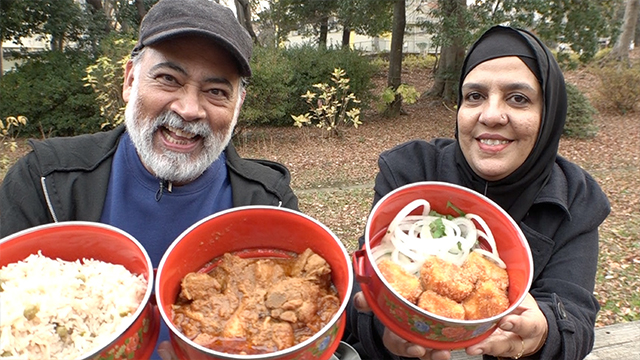
Today, a special episode featuring Chiba Prefecture. A neighbor to Tokyo, Chiba is home to more than 180,000 foreign residents. First, we visit Matsudo, a city popular with commuters. Burney is from Pakistan and has lived in Japan for 37 years. He works as an interpreter and TV personality, and is also involved in international cultural exchange. He hosts international exchange parties and shares his home country’s culture and traditions. Burney gets his energy from the halal bentos his wife Fozi prepares for him. Today, they'll make a bento for a weekend picnic.
-
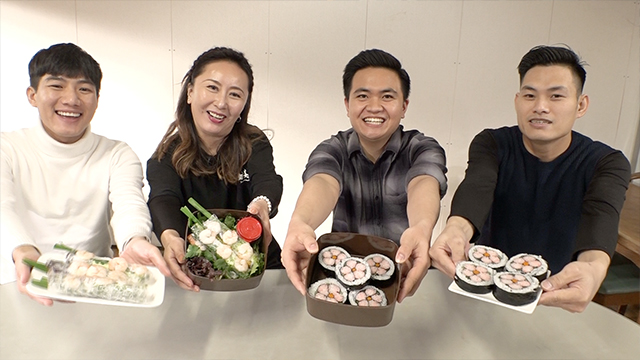
Our next destination is a Japanese language school in Kashiwa with nearly 400 foreign students. Sang, from Vietnam, came to Japan as a student in 2022. He cooks Vietnamese food every day in the hopes of realizing his dream: opening his own restaurant in Japan. Today, he’s learning how to make one of Chiba’s local specialties. Kazari-makizushi is a rolled sushi served on special occasions. When sliced, it reveals a decorative pattern. Today, he and his friends are going to try to create a basic floral pattern. The instructor, Yumi, has taught many local foreign residents.
-
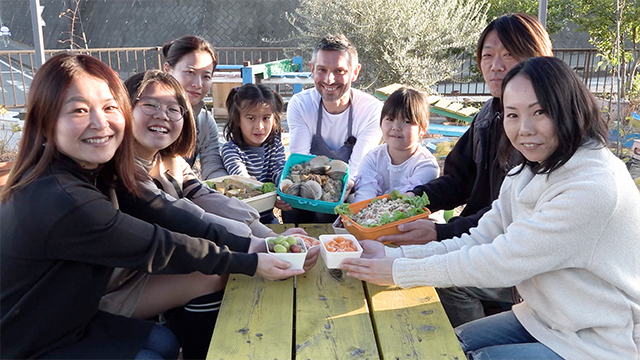
Our final stop is Kisarazu, a port city on the eastern side of Tokyo Bay. Simone is from Italy. His wife Ayumi is originally from Kisarazu. They married ten years ago, and their daughter, Viktoria, is now six. Simone became interested in Japanese culture after watching anime as a child. He's now added bento-making to his interests. He makes bentos every day for his wife and daughter, making the most of Kisarazu’s bountiful seafood.
-
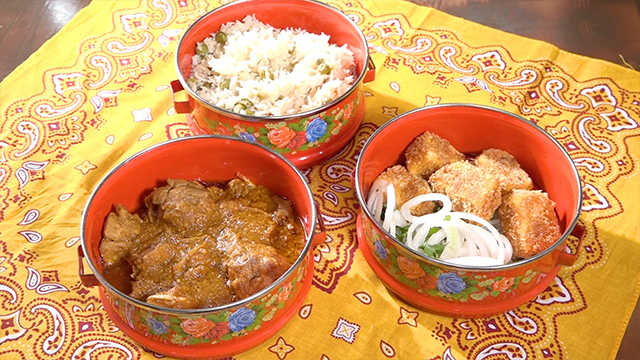
Burney’s favorite dish is Chicken Korma curry, with bone-in chicken braised in yogurt and over 10 different spices. Having lived in Japan for many years, Fozi likes to use Japanese ingredients in her cooking. Today, she’s making a side dish of Pakistani-style tofu fritters. She also steams rice with green peas. A special bento for a weekend picnic, packed with Pakistani flavors.
-
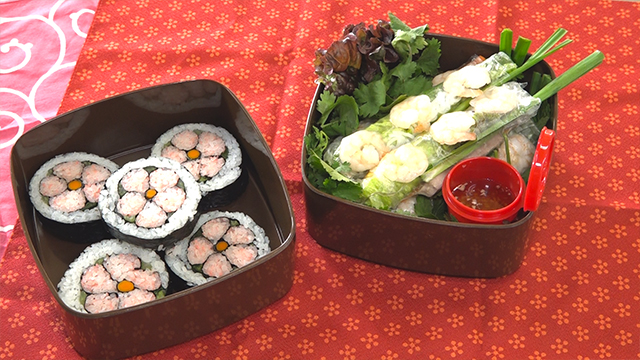
Rice mixed with pink fish flakes is rolled in nori. Several of these thin rolls are then centered around pickled burdock, and are then rolled into another layer of nori and rice. The thick roll reveals a cute decorative pattern when sliced.
Next, Sang teaches Yumi how to make Vietnamese spring rolls. They arrange the shrimp, rolled omelet, and other colorful ingredients on a sheet of rice paper. The key is to make sure everything is visible from the outside when rolled up.
Together, they make a bento packed with rolled food from Chiba and Vietnam. Follow your dreams, Sang! -
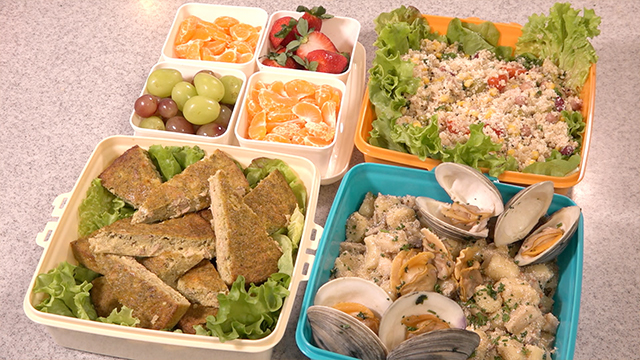
Today, the family will make a bento to share with neighbors. The main dish is gnocchi, an Italian home-style pasta. They mix mashed potatoes with beaten egg and flour. It's a recipe passed down to Simone by his mother. For the sauce, they use seafood and mushrooms, specialties of Chiba. Simone serves the gnocchi with local cherrystone clams steamed in garlic and parsley. They also prepare an Italian baked omelet, a quinoa salad, and some fruit. A bento featuring a fusion of Italy and Chiba, packed with the bounty of the sea.
-
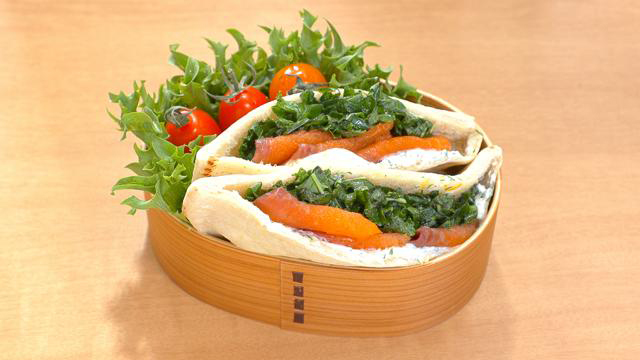
- BENTO RECIPES
- from Episode 17 / Season 8.
- Salmon Pita Bento
- (355 kcal)
-
 by Marc Matsumoto
by Marc Matsumoto
Bento contents:
- Salmon Pita
- Stick lettuce
- Cherry tomatoes
Makes enough to pack into 2 bentos
Ingredients:
For pita
- 2 pieces of pita bread
- 80 g smoked salmon
For yogurt spread
- 60 g plain Greek yogurt
- 30 g cream cheese
- Zest of half of a Meyer lemon
- 5 g dill leaves, roughly chopped
For kale slaw
- 60 g kale leaves
- 1 tbsp olive oil
- 1 tbsp Meyer lemon juice
- 1/4 tsp salt
- Freshly ground black pepper
Directions:
1. For the yogurt spread, mash the Greek yogurt and cream cheese together and use a whisk to mix until smooth. Stir in the Meyer lemon zest and chopped dill.
2. For the kale slaw, cut out the tough center stem and discard. Stack the leaves and shred them. Whisk the olive oil, lemon juice, salt, and black pepper together, then toss with the kale.
3. To assemble the pita, cut the two pieces of pita bread in half and expand the pockets.
4. Spread a quarter of the yogurt spread inside each pita.
5. Add 20 grams of salmon to each pita.
6. Divide the kale salad between the pita sandwiches.
-
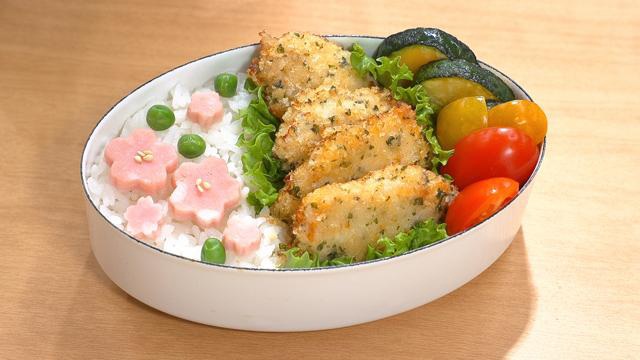
- BENTO RECIPES
- from Episode 17 / Season 8.
- Good Luck Chicken Katsu Bento
- (827 kcal)
-
 by Maki Ogawa
by Maki Ogawa
Bento contents:
- Rice
- Good Luck Chicken Katsu
- Lettuce
- Cherry tomatoes
- Sautéed zucchini
- Cherry blossom decorations
- Green peas
Ingredients:
For Good Luck Chicken Katsu(yields 6 pieces)
- 140 g chicken breast
- 1 tbsp mayonnaise (20 g)
- A pinch (2 g) each of salt and pepper
- Panko, as desired
- Grated cheese, as desired
- Parsley, as desired
- 2 tbsp vegetable oil
For Sautéed Zucchini
- 1/3 zucchini
For the cherry blossom decorations
- Fish sausage
- White sesame seeds
Directions:
For Good Luck Chicken Katsu
1. Trim the excess fat from the chicken and cut into bite-size pieces, cutting against the grain.
2. Sprinkle with salt and pepper.
3. Place in a food storage zipper bag. Add the mayonnaise and massage from outside the bag. Set aside for about half an hour. You can also prep the chicken the night before and refrigerate in the fridge.
4. Chop the parsley.
5. Mix the panko, grated cheese, and parsley in a tray.
6. Bread the chicken by pressing firmly into the seasoned panko.
7. Heat the oil in a pan and shallow fry each side of the chicken for 2 to 3 minutes over low to medium heat.
For the cherry blossom decorations
1. Cut out cherry blossom shapes from the fish sausage using cookie cutters of different sizes.
2. Sauté together with the zucchini.
3. Place on top of the rice and add several white sesame seeds in the center of the larger cherry blossoms.
-
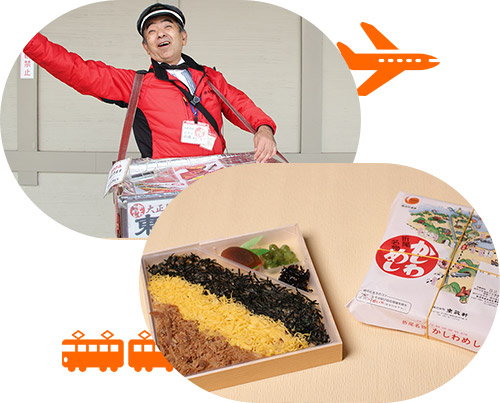
- BENTO TOPICS
- from Episode 17/ Season 8.
- Fukuoka
-

Today, from Orio Station in Kitakyushu, Fukuoka Prefecture.
When Fukuoka was a major coal-mining center, Orio boasted a lot of traffic.
This gave rise to the birth of ekiben sold by roaming vendors, something rarely seen in other parts of Japan. -
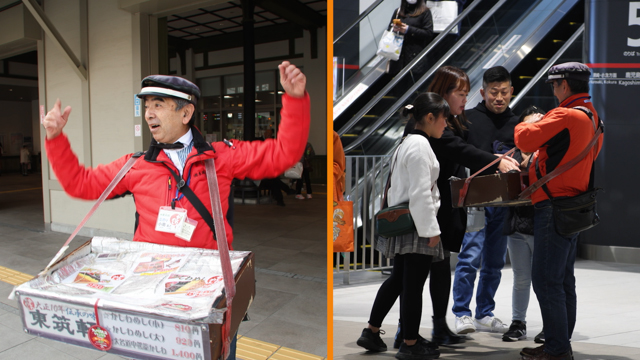
Kominami-san is an ekiben vendor. He walks around the station performing a cheerful song and dance, imitating a chicken.
-
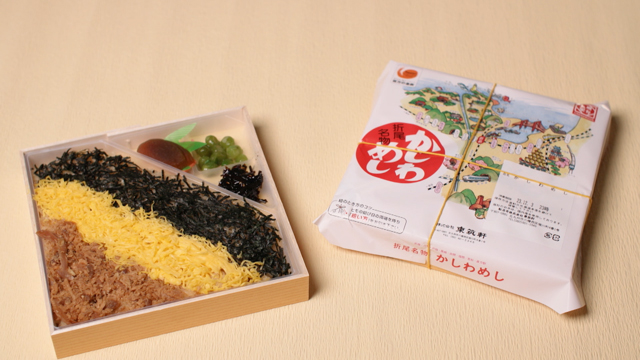
The ekiben he sells is a Kashiwameshi bento. Kashiwameshi is rice cooked with chicken, a specialty of this region. The bento rice is cooked in chicken soup and is topped with savory chicken, shredded egg omelet, and nori.
-
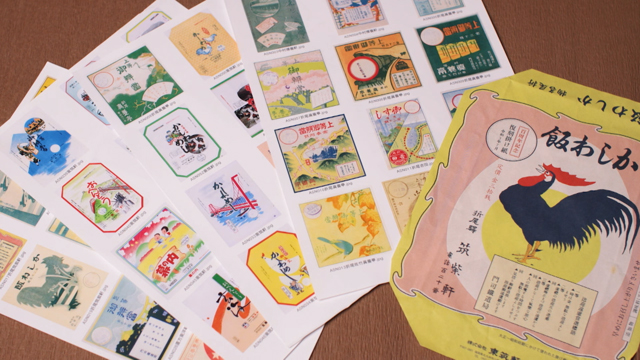
The popular bento developed over a century ago is still prepared the same way today. This is a collection of the paper used to wrap this ekiben. The very first one featured a chicken design. Some train enthusiasts love to collect these ekiben wrapping papers.
-
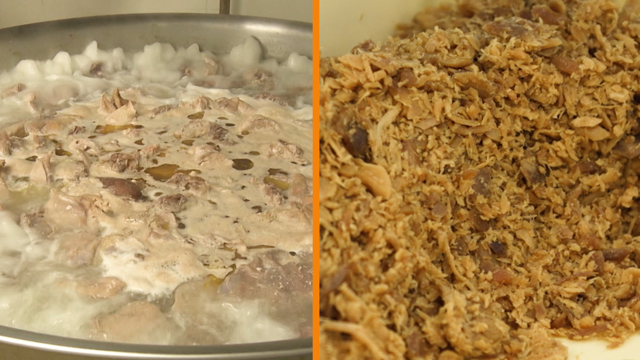
This is the factory that makes the ekiben. A generous amount of meat is simmered for two days to make the chicken soup and pulled chicken. The secret lies in using the meat of egg-laying chickens, which has a chewy texture. The rice cooked in chicken soup and seasoned with a secret recipe is packed with umami.
-
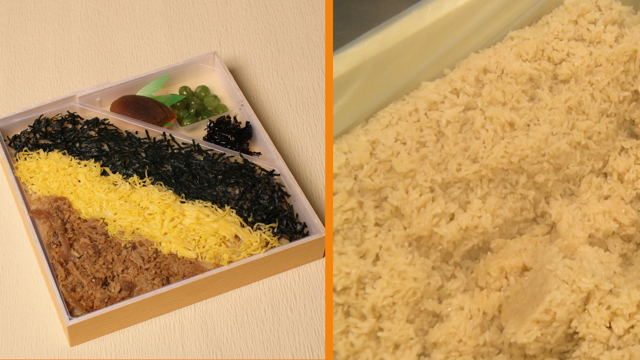
The umami-rich chicken rice is topped with sweet and savory chicken, a shredded omelet, and nori.
A time-honored bento that remains a favorite with the people of Fukuoka.
-
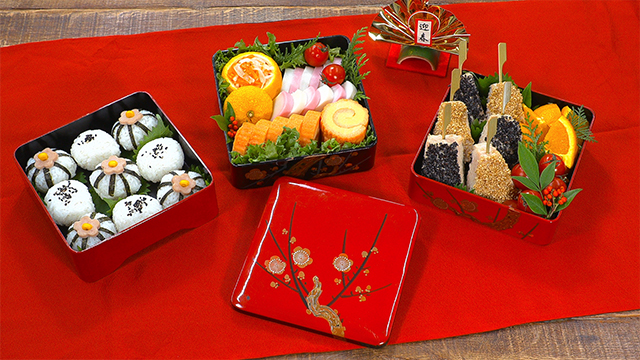
- BENTO RECIPES
- from Episode 16 / Season 8.
- Osechi New Year Bento
- (For sharing)
-
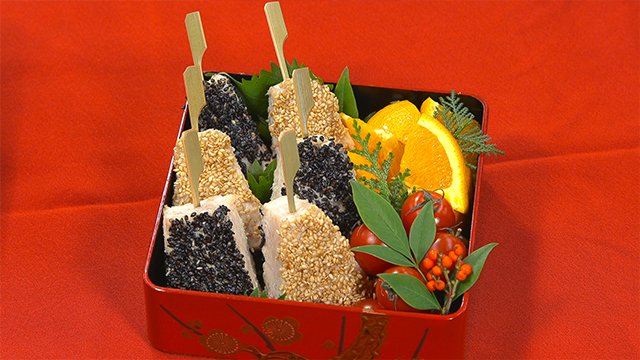
- Matsukaze-yaki
- (835 kcal)
-
 by Maki Ogawa
by Maki Ogawa
Contents:
- Matsukaze-yaki
- Orange
- Cherry tomatoes
- Shiso leaves
Ingredients:
(Yields 6)
- 250 g ground chicken breast
- 100 g silk tofu (kinugoshidofu)
- 20 g panko
- 5 g sugar
- 1 tsp salt
- 1/2 tsp grated ginger
Directions:
1. Mix all ingredients in a bowl and knead well.
2. Add the meat mixture to a heat-resistant container and flatten.
3. Cover lightly with plastic wrap and microwave for 5 minutes at 500 W.
4. Let cool slowly in the microwave.
5. Once cooled to room temperature, cut into fan shapes.
6. Coat one side of each with the remaining meat juices in the container.
7. Spread the sesame seeds in a tray and press the juice-covered side of the fans onto the sesame seeds to cover.
8. Thread the fans onto bamboo skewers and pack along with shiso leaves.
-
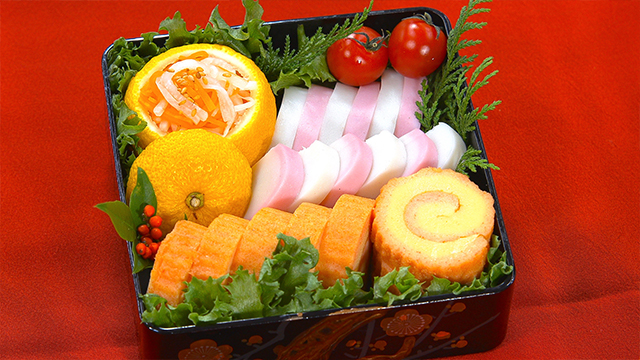
- Datemaki with Namasu
- (556 kcal)
-
 by Marc Matsumoto
by Marc Matsumoto
Contents:
- Datemaki
- Namasu
- Pink and white kamaboko
- Frill lettuce
- Cherry tomatoes
Ingredients:
For Datemaki
- 100 g crab sticks
- 5 eggs (approx. 60 g each)
- 30 g sugar
- 2 tbsp mirin
- 1 g salt
For Namasu
- 200 g daikon
- 40 g carrot
- 1/2 tsp salt
- 3 tbsp rice vinegar
- 25 g sugar
- 1/2 tsp toasted sesame seeds
Directions:
For Datemaki
1. Put the oven rack in the center of the oven, and preheat the oven to 190 degrees C. Soak a bamboo sushi mat in water. Line a 20 cm (8 inch) square baking pan with parchment paper.
2. Add the crab sticks, eggs, mirin, sugar, and salt to a blender and blend until smooth.
3. Strain the mixture through a tea strainer into the prepared baking pan.
4. Put the pan in the oven and bake until a toothpick inserted into several locations around the egg comes out clean (this should take about 12-14 minutes) and the top has browned.
5. Remove the datemaki from the oven and let it cool for one or two minutes. Remove the parchment paper and place the egg on the wet bamboo mat with the browned side facing up.
6. Roll the egg up using the mat and compress the roll so there are no gaps between the layers of egg. Wrap rubber bands around the mat to hold the round shape, then wrap the whole thing in plastic wrap. Refrigerate the datemaki overnight.
7. Unwrap the datemaki and slice it into circles to serve.
For Namasu
1. Cut the daikon into 3 mm matchsticks. Cut the carrots into 1.5 mm matchsticks.
2. Sprinkle the daikon and carrots with salt, and toss to coat evenly. Put the vegetables in a wire strainer and let them sweat for at least 15 minutes.
3. Bring the rice vinegar and sugar to a full boil (either in a pot or microwave oven) to dissolve the sugar.
4. Transfer the drained daikon and carrots to a bowl and toss with the vinegar mixture to coat. Let the vegetables pickle overnight.
5. Serve in a hollowed-out citrus fruit (such as a mandarin orange) and garnish with toasted sesame seeds.
-
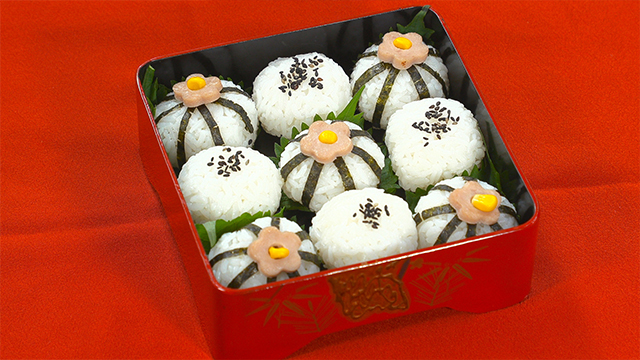
- Onigiri with plum decoration
- (752 kcal)
-
 by Maki Ogawa
by Maki Ogawa
Contents:
- Onigiri with plum decoration
- Shiso leaves
Ingredients:
(Yields 9 onigiri)
- 400 g rice
- 3 g salt
- 5 shiso leaves
- 5 corn kernels
- 1/2 sheet nori
- 1 tbsp black sesame seeds
- A dash of vegetable oil for pan-frying
- 5 slices bologna sausage
Directions:
1. Sprinkle salt over the rice and toss lightly.
2. Place about 40 g of rice on plastic wrap, then cover and shape into a ball. Remove the wrap.
3. Cut the nori into 15 strips. Use 5 strips per onigiri and make 5 nori-wrapped onigiri.
4. Pack the onigiri and shiso into the bento box.
5. Cut the bologna sausage into 5-6 mm thick slices and cut out flower shapes with a cookie cutter. Use a straw to poke a hole in the center of each flower.
6. Oil the pan and fry the sausages.
7. Place a slice of sausage on a nori-wrapped onigiri and stuff a corn kernel in the center.
8. Sprinkle black sesame seeds over the plain onigiri.
-
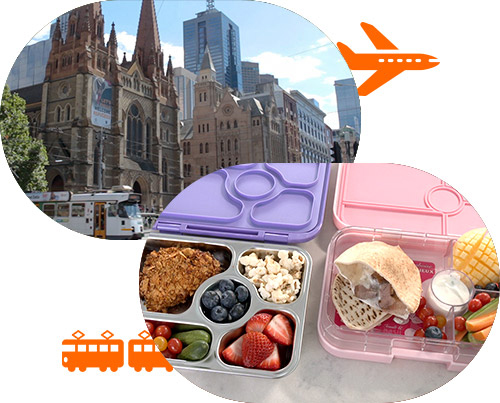
- BENTO TOPICS
- from Episode 16/ Season 8.
- Melbourne / Australia
-

Bento Topics. Today from Australia, a culturally diverse country. Melbourne, its second largest city, has a particularly cosmopolitan feeling.
-

Its iconic Queen Victoria Market has a history of more than 140 years.
The market offers Aussie beef and lamb, as well as cheeses. Visitors can also find a variety of fresh ingredients and delicacies from around the world. -

George is a local hit bento maker. He began posting the bentos he made for his daughters on social media. He now has more than 210,000 followers, and has published several bento books. The secret to his popularity lies in his unique creations that appeal to kids. Today, he'll make two bentos with his daughter Kiki.
-
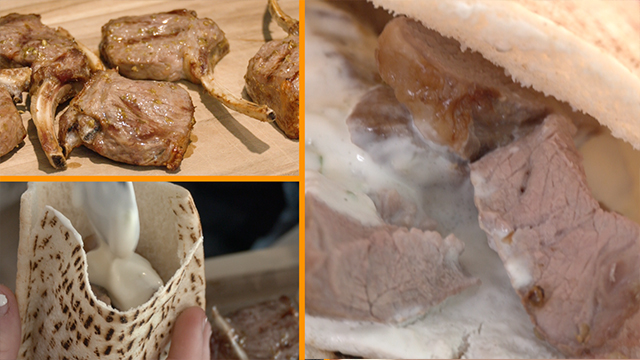
For his first dish, he uses lamb chop, a popular ingredient in Australia. He uses oregano and lemon juice to season the lamb before grilling. He stuffs the sliced lamb into pita pockets and drizzles with a Greek yogurt sauce.
-
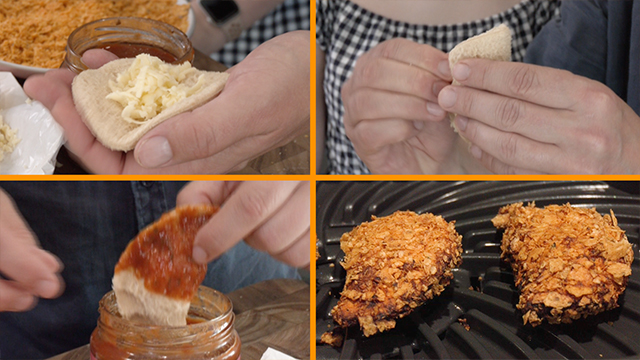
His second dish is an unexpected and fun choice! He cuts out circles from sliced bread and covers each circle with mozzarella cheese. After folding in half, he pleats the edges to form dumplings. He then dips them in a spicy Mexican salsa, coats with crumbled corn chips, and cooks in an air fryer to make fried dumplings.
-
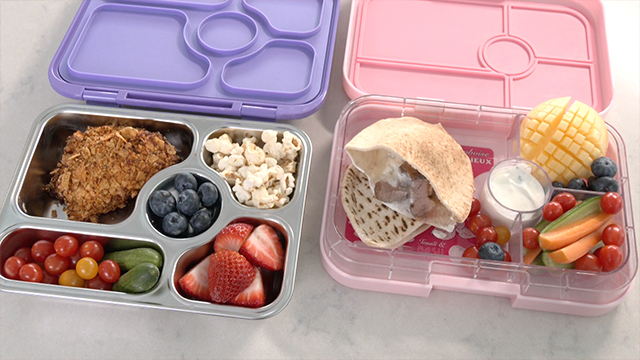
He adds a sliced mango, popcorn, and colorful fruits and vegetables to complete his creative bentos.
-
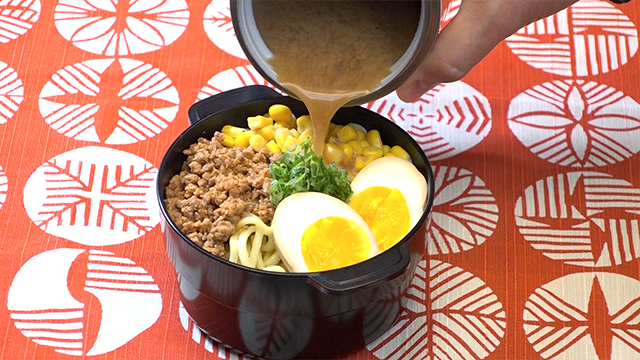
- BENTO RECIPES
- from Episode 15 / Season 8.
- Miso Ramen Bento
- (739 kcal)
-
 by Marc Matsumoto
by Marc Matsumoto
Bento contents:
- Miso soup
- Ramen noodles
- Karamiso
- Flavored boiled egg
- Canned corn
- Chopped scallions
Makes enough for 2 bentos
For Soup
- 2 tsp vegetable oil
- 10 g grated garlic
- 10 g grated ginger
- 130 g ground pork
- 45 g miso
- 700 ml low sodium vegetable broth
For Noodles
- 260 g fresh ramen noodles
- 16 g butter
For Karamiso
- 20 g miso
- 1 tbsp mirin
- 1 tsp doubanjiang
Directions:
* Preheat your vacuum flask by filling with boiling water.
1. Add the oil, garlic, and ginger to a large pan and sauté until the mixture is golden brown and no longer sizzling.
2. Add the pork and 45 grams of miso and stir-fry while crumbling the meat. Continue frying until the pork is dark brown.
3. Add the vegetable stock and bring it to a full boil. Cook for 5 minutes.
4. Preheat your soup jars by filling them with boiling water.
5. When your soup is done, drain the soup jars and then strain the soup, dividing it evenly between the jars. Close the lids tightly.
6. Return the drained pork to the pan and add the remaining 20 grams of miso, mirin, and doubanjiang. Cook over medium-high heat until the excess moisture has evaporated and the mixture is crumbly.
7. For the noodles, bring a large pot with at least 2 liters of water to a boil. Cook for the lower end of the time specified on the package.
8. Lightly drain the noodles and then toss them with the butter to coat evenly.
9. Divide the noodles between two large bento boxes and top them with the spicy pork, corn, flavored boiled egg, and scallions.
10. Before eating, shake the soup jar to emulsify the soup, then pour the soup over the noodles and toppings.
-
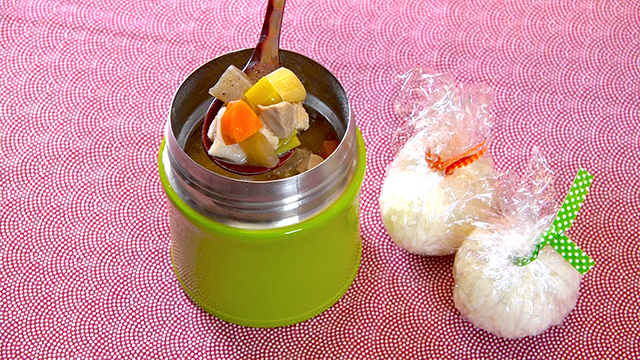
- BENTO RECIPES
- from Episode 15 / Season 8.
- Tonjiru (Pork Miso Soup) Bento
- (Soup: 172 kcal & Onigiri: 134 kcal)
-
 by Ariga Kaoru
by Ariga Kaoru
Ingredients:
Makes enough for one 300 ml soup jar
- 50 g pork loin
- 40 g (2 cm) daikon radish
- 20 g (3 cm) carrot
- 5 cm Japanese leek
- 20 g konnyaku (may substitute shirataki)
- 1 tbsp rice miso, as needed
- 180 ml water
- A dash of sesame oil
Directions:
* Preheat your vacuum flask by filling with boiling water.
1. Cut the daikon, carrot, and konnyaku into 1 cm chunks. Cut the Japanese leek into 1 cm thick slices. Cut the pork into 1 to 1.5 cm thick slices.
2. Add all ingredients to a pot of water and bring to a boil. Reduce the heat to low and simmer for 3 minutes. Dissolve and add the miso. Add a dash of sesame oil before pouring the soup into the soup jar.
-
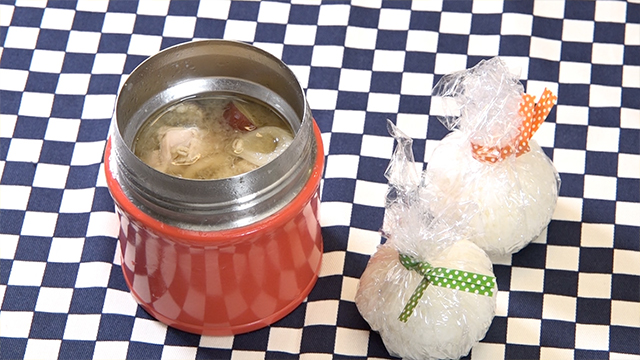
- Chicken and Sweet Potato Miso Soup
- (Soup: 289 kcal & Onigiri: 134 kcal)
-
 by Ariga Kaoru
by Ariga Kaoru
Ingredients:
Makes enough for one 300 ml soup jar
- 70 g chicken thigh
- 60 g sweet potato
- 10 cm Japanese leek
- 5-6 shimeji mushrooms or other mushrooms of choice
- 1 to 1 1/3 tbsp barley miso, as needed
- 200 ml water
Directions:
* Preheat your vacuum flask by filling with boiling water.
1. Cut the sweet potato into 1 cm thick slices. (Leave the peel on. If large, cut into half-circles.) Cut the Japanese leek diagonally into slices. Cut the chicken into 3-4 cm chunks.
2. Bring all ingredients to a boil. Then, reduce the heat to low and simmer for 3-4 minutes until the chicken is cooked through. Dissolve and add the miso. Bring to a boil before pouring the soup into the soup jar.
-
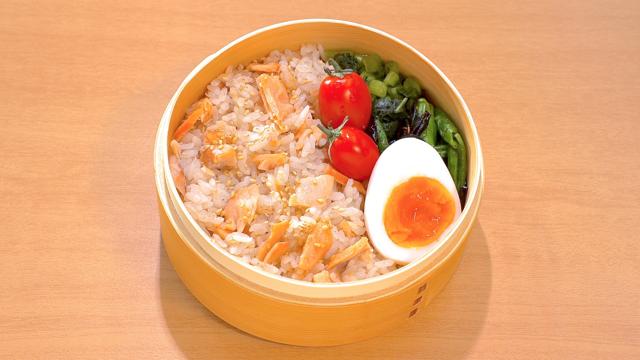
- BENTO RECIPES
- from Episode 14 / Season 8.
- Salmon Rice Bento
- (515 kcal)
-
 by Marc Matsumoto
by Marc Matsumoto
Bento contents:
- Salmon Rice
- Fried manganji peppers with shio konbu and sesame seeds
- Cherry tomatoes
- Nozawana
- Boiled egg
Makes enough to pack into 3-4 bentos
Ingredients:
- 220 g boneless salmon filets
- 1 tsp salt
- 300 g rice
- 385 ml cold water
- 1 tbsp sake
- 2.5 g dried shiitake mushroom (about 1/2 a large mushroom)
- 2 rice cooker cups Japanese short-grain rice
Directions:
1. Sprinkle the salt evenly over all sides of the salmon, then place the salmon on a paper towel-lined tray. Cover and refrigerate overnight.
2. Wash the rice until the water runs clear, then drain.
3. Add the rice to a heavy-bottomed pot such as a Dutch oven, and then add the water and sake.
4. Use a microplane to grate the caps of the dried shiitake mushrooms into the rice cooker, discarding the stem. Stir the shiitake powder into the rice. Let the rice soak for 20 minutes.
5. When the rice is done soaking, bring the pot to a boil over high heat, then turn down the heat to low. Cook the rice for 12 minutes without opening the lid.
6. When the timer goes off, have the salmon ready to go into the pot. Open the lid and add the salmon in a single layer before quickly shutting the lid. Turn off the heat and let this steam for an additional 15 minutes.
7. When the time is up, remove the salmon from the rice cooker and flake it, discarding the skin and any bones. Stir the salmon into the rice.
-
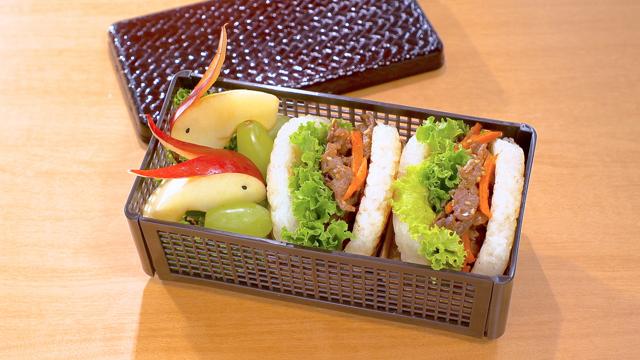
- BENTO RECIPES
- from Episode 14 / Season 8.
- Rice Burger Bento
- (613 kcal)
-
 by Maki Ogawa
by Maki Ogawa
Bento contents:
- Rice Burgers
- Lettuce
- White grapes
- Apple Bunnies
- White sesame seeds
Ingredients:
For the rice burger buns (yields 2 sets)
- 300 g cooked rice
- 2 tsp potato starch
- A pinch of salt
- 2 tsp sesame oil
- Soy sauce, as needed
For the filling
- 150 g beef flank trimmings
- 1 tsp potato starch
- 30 g carrot
- 1 tsp sesame oil
- Sauce:
- 20 g apple
- 1 1/2 tbsp soy sauce
- 1 1/2 tbsp sugar
- 1 1/2 tbsp sake
- 2 g grated ginger
- 2 g grated garlic
- 1 tsp white sesame seeds
For the Apple Bunnies
- 2 apple wedges
- 200 ml water
- 1 tbsp sugar
- 2 black sesame seeds
Directions:
For the Rice Burgers
1. Peel and grate the apple.
2. Toss the rice, salt, and potato starch.
3. Line the cutting board with plastic wrap. Wet a ring mold or round container and place on top of the wrap. Fill with 1/4 of the rice (75 g), and use a spoon to press and flatten to make a 1 cm thick bun. Repeat the process to make 4 buns.
4. Once the buns are cool and firm enough to handle, coat a frying pan with sesame oil and brown both sides of the buns.
5. Coat one side of two buns with soy sauce, turn over and brown. (Tip: If you coat both sides of each bun, they’ll break easily. So, you only want to coat the surface of the top bun.)
6. Make the sauce by combining the soy sauce, sugar, sake, white sesame seeds, grated ginger, grated garlic, and grated apple.
7. Cut the carrot into matchsticks.
8. Add potato starch to the beef and mix lightly.
9. Add sesame oil to the pan you used to fry the buns and sauté the carrots for a minute.
10. Add the beef and sauté until it changes color. Add the sauce.
11. Set aside the beef to cool. Place lettuce on the unglazed bun, then the beef, and finally, the top bun with the glazed side up to complete.
For the Apple Bunnies
1. Cut a quartered apple into 2-3 wedges.
2. Score the skin in an inverted V-shape and peel off the V-shape. Mix the sugar and water and soak the apples for 5 to 10 minutes.
3. Pat dry and add the black sesame seeds for the eyes.
4. Pack along with the white grapes.
-
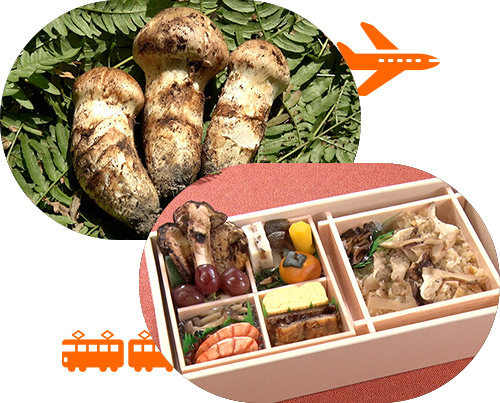
- BENTO TOPICS
- from Episode 14/ Season 8.
- Kyoto
-
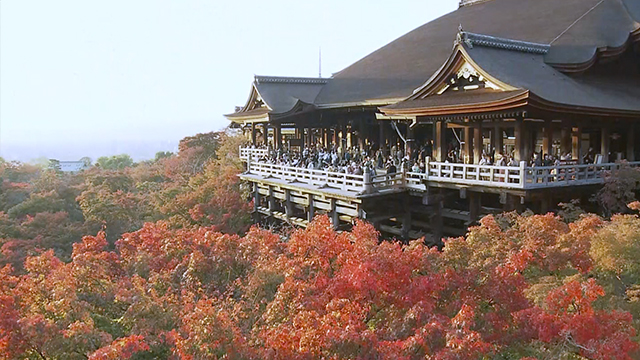
Today, from Kyoto in the fall. Many tourists visit Kyoto around this time to enjoy the spectacular autumn foliage.
-
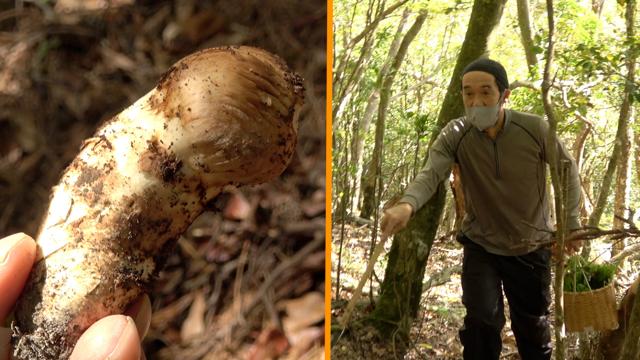
Autumn in Kyoto is the season for mushroom foraging. Matsutake are an autumn delicacy found only at the base of Japanese red pine trees. The conditions under which they grow remain a mystery, so they cannot be cultivated artificially.
-
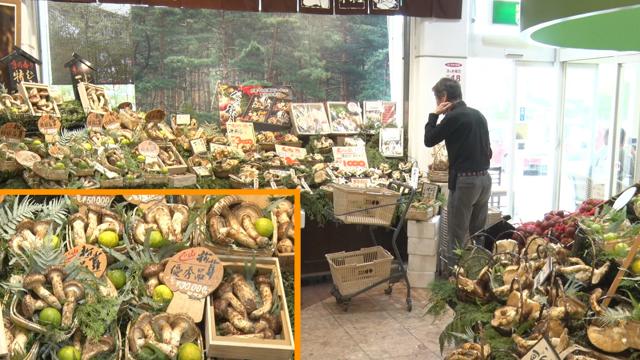
Matsutake are noted for their rich and earthy aroma and chewy texture, and are used in a variety of dishes.
A local supermarket in Kyoto is famous for their impressive displays of matsutake. During this season, customers stepping into the store are greeted with the aroma of matsutake.
-
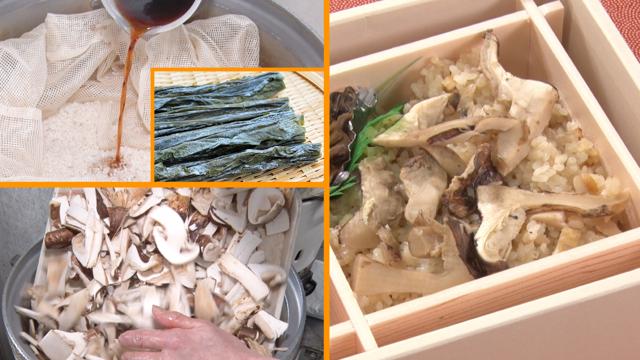
During matsutake season, the supermarket offers a specialty bento. It features matsutake rice cooked with soy sauce, konbu, abura-age, and a liberal helping of matsutake.
The simple seasoning enhances the potent aroma of the matsutake. -
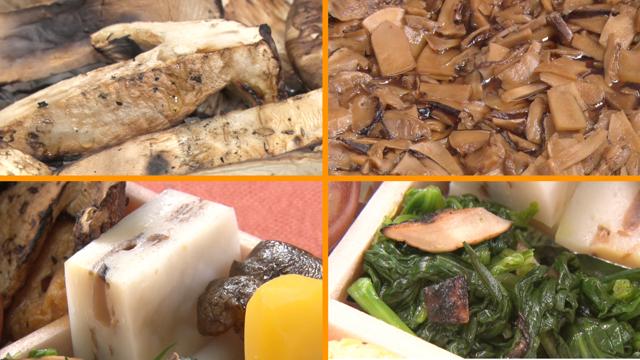
The bento includes four other dishes that each include matsutake. The main dish is matsutake grilled over charcoal. This cooking method is considered the best way to enjoy the mushroom's aroma. The next dish is matsutake simmered in soy sauce, syrup, and caramelized sugar. There are also as fish cakes containing matsutake. To finish, a salad of blanched spinach and matsutake in savory dashi.
-
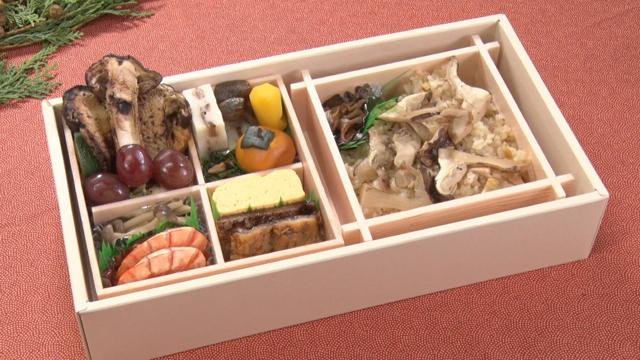
Matsutake rice, plus four different matsutake side dishes. Happiness packed in a bento, and a once-a-year-treat.
-
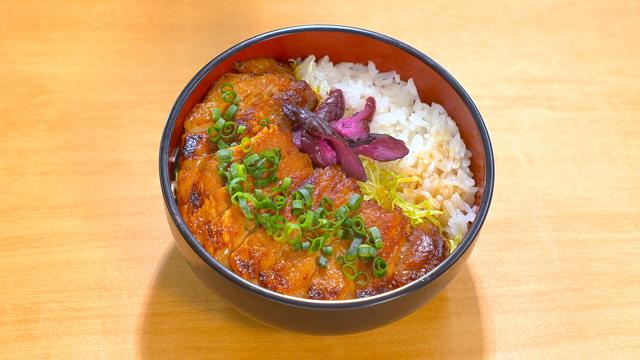
- BENTO RECIPES
- from Episode 13 / Season 8.
- Miso-glazed Pork Bento
- (764 kcal)
-
 by Marc Matsumoto
by Marc Matsumoto
Bento contents:
- Miso-glazed Pork
- Rice
- Shredded cabbage
- Shibazuke
Makes enough to pack into 2 bentos
Ingredients:
- 2 pork chops (1.5 cm or 1/2 inch thick)
- 2 tbsp miso
- 2 tbsp mirin
- 2 tsp sugar
- 5 g grated ginger
- 3 tbsp mirin
- 2 tbsp soy sauce
- 2 tsp vegetable oil
- Chopped scallions, for garnish
Directions:
1. Slice diagonal slits spaced 1/5-inch (5 mm) apart part of the way through one side of the pork. Flip it over and cut slits at the same angle on the other side.
2. Mix the miso, mirin, sugar, and ginger together until smooth, then spread evenly over all surfaces of the pork. Let this marinate overnight.
3. To make the sauce, add the soy sauce and mirin to a small pan and boil until the mixture no longer smells like alcohol and the sauce starts to thicken (this should take about 2 minutes).
4. When you're ready to cook the pork, lightly remove some excess miso and heat a frying pan over medium heat until hot.
5. Add the oil and pork chops and pan-fry on one side until lightly browned.
6. Flip the pork chop over and brown the other side. Flip it over again and turn up the heat to high. Cook until the pork is lightly charred around the edges.
7. Slice the pork chops and serve over a bed of shredded cabbage and rice. Garnish with the scallions and drizzle the sauce over the pork and rice to eat.
-
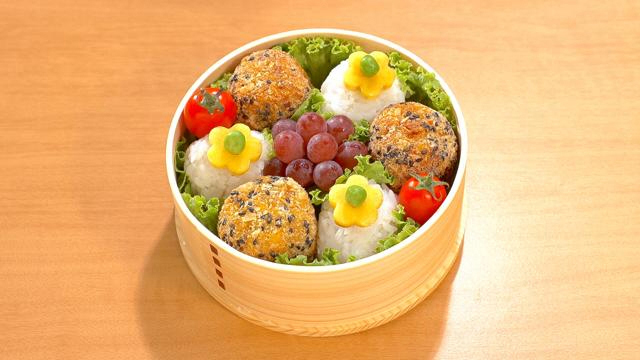
- BENTO RECIPES
- from Episode 13 / Season 8.
- Sweet Potato Korokke Bento
- (824 kcal)
-
 by Maki Ogawa
by Maki Ogawa
Bento contents:
- Sweet Potato Korokke
- Flower Onigiri
- Grapes
- Cherry tomatoes
- Lettuce
Ingredients:
For Sweet Potato Korokke (yields 8)
- 240 g sweet potato
- 80 g ground pork
- 60 g onion
- 2 tsp curry powder
- 2/3 tsp salt
- A pinch of pepper
- For the breading:
- 2 eggs
- Flour, as needed
- 50 g panko
- 4 tbsp black sesame seeds
- Vegetable oil for deep frying
For the Flower Onigiri (yields 3)
- 180 g cooked rice
- A pinch of salt
- Flower decorations
- Green peas
- Boiled sweet potato
Directions:
For Sweet Potato Korokke
1. Cut a 10 g slice from the sweet potatoes, and use a flower-shaped cookie cutter to cut out three flowers. Use a straw to cut out a hole in the center, and soak in water.
2. Cut the remaining sweet potato into 1-2 cm cubes.
3. Place the cubed sweet potatoes in a heat-resistant bowl, sprinkle 2 tbsp of water, cover with plastic wrap, and microwave at 600W for 3 minutes.
4. Mash and incorporate the excess water, if any, into the sweet potato.
5. Add the minced onion and ground pork to a different heat-resistant bowl, mix lightly with chopsticks, and cover lightly with plastic wrap. Microwave at 600W for 1 minute.
6. Add the mashed sweet potato.
7. Stir in the curry powder, salt, and pepper.
8. Divide into 8 equal parts and shape into round balls.
9. Dredge in flour, dip in beaten egg, and coat with the panko mixture. Fry in oil heated to 170 degrees C.
For the Flower Onigiri
1. Mix salt into the rice and divide into 3 equal parts.
2. Use plastic wrap to make 3 round onigiri.
3. Decorate with the flower-shaped sweet potatoes and green peas.
- Saitama Special
- from Episode 13/ Season 8.
-
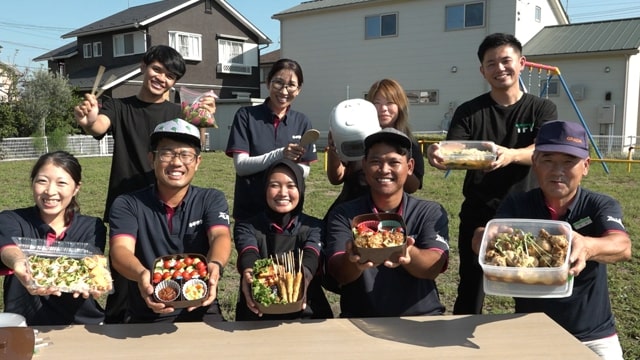
Today we visit Saitama, a prefecture next to Tokyo. It's home to around 210,000 foreign residents, some of whom are keen bento makers! They make bentos that feature Saitama’s diverse agricultural produce. The city of Fukaya is famous for Fukaya negi, a variety of Japanese leek that is sweet without a sharp bite. Apri and Ikka are from Indonesia. They're learning how to cultivate Fukaya negi. Today, they’re cooking a variety of Indonesian dishes with Fukaya negi to make a bento for their coworkers.
-
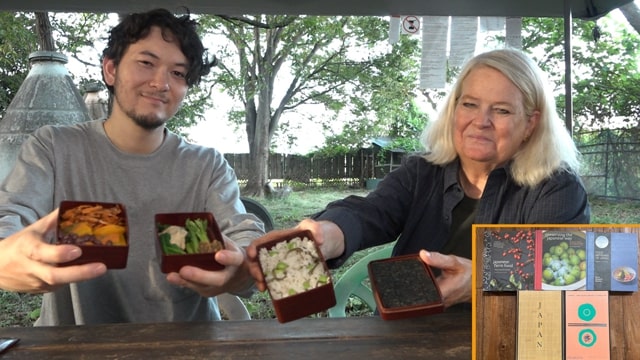
Nancy is originally from the United States. She arrived in Japan 35 years ago, and settled in her husband's hometown of Kamikawa. She’s made it her mission to share the richness of Kamikawa’s farm-style cooking with international audiences. Today, she’s making a veggie-heavy bento for her son Andrew, who recently returned from the States. She visits an organic farmer, who is a friend of the family, to pick seasonal vegetables such as komatsuna and edamame for her bento. She also gets miso and soy sauce from a 120-year-old local brewery.
-
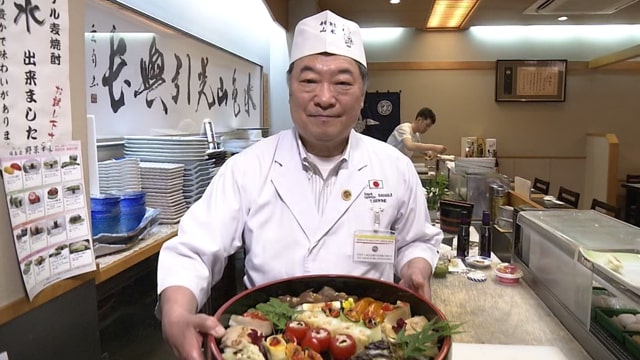
Sekine is the owner of a sushi restaurant in Saitama City. Ten years ago, he came up with the idea of making sushi that used local vegetables instead of fish. Saitama is one of the top producers of vegetables in Japan, and Sekine wants to make his Saitama-style vegetable sushi famous around the world.
-
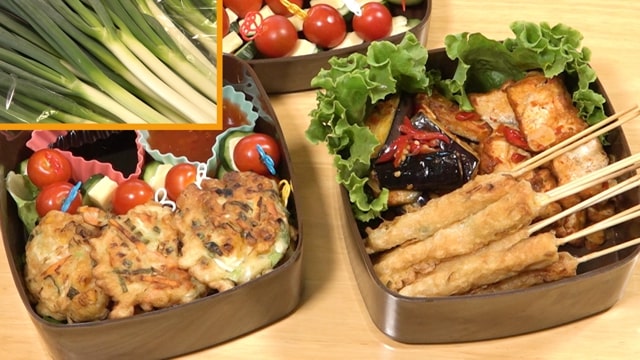
Apri is using Fukaya negi in her Bakwan Goren, which are Indonesian-style vegetable fritters.
Ikka kneads ground chicken, potato starch, and Fukaya negi together to make a Saitama version of Sempol, a famous Indonesian street food. -
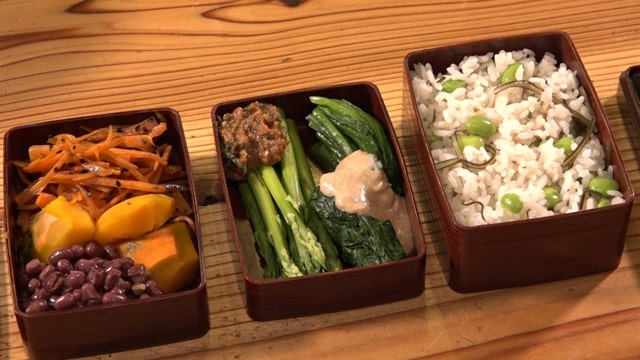
She boils the edamame in konbu dashi, and uses the edamame-flavored dashi to cook rice. She mixes miso with thinly shaved vinegared konbu as well as ume paste to make a dip for blanched asparagus. She parboils the fresh komatsuna and steeps it in konbu dashi and soy sauce before garnishing with homemade sesame sauce. She then stir-fries shredded carrots in sesame oil and soy sauce. To finish, she simmers azuki beans and kabocha squash in a sweet and savory sauce. Nancy packs her bento with dishes that make the most of the inherent flavors of Kamikawa’s local ingredients.
-
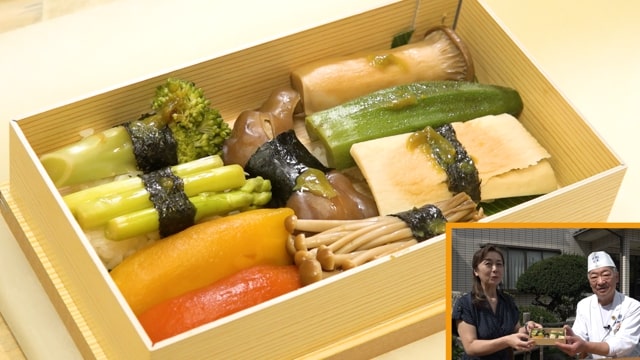
The vegetables are simmered in konbu dashi seasoned with soy sauce and sugar. He transforms red bell peppers into sushi that looks and tastes just like tuna. And he makes use of the chewy texture of kikurage mushrooms to make shellfish-like sushi. He also uses green asparagus, broccoli, okra, and yams in today's vegan bento. It's a veggie-heavy bento that people around the world are sure to enjoy! Today, he’s making a special delivery to a customer who fell in love with his sushi ten years ago.
-
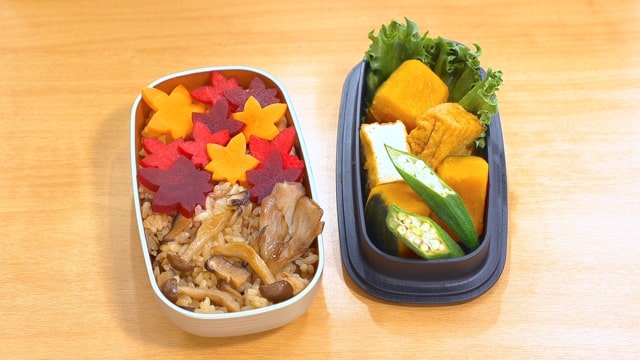
- BENTO RECIPES
- from Episode 12 / Season 8.
- Mushroom Rice Bento
- (636 kcal)
-
 by Marc Matsumoto
by Marc Matsumoto
Bento contents:
- Mushroom
- Autumn Leaves
- Kabocha pumpkin and atsuage nimono
- Okra
- Frill lettuce
Makes enough to pack into 4 bentos
Ingredients:
For Mushroom Rice
- 2 rice cooker cups Japanese short-grain rice
- 100 g chicken thigh, cut into 1 cm cubes
- 1/4 tsp salt
- 1 tbsp vegetable oil
- 50 g maitake mushrooms, cleaned and shredded by hand
- 50 g shimeji mushrooms, cleaned and trimmed
- 50 g shiitake mushrooms, cleaned, trimmed, and chopped
- 2 tbsp soy sauce
- 1 tbsp sake
- 2 tsp sugar
For Autumn Leaves
- 100 g daikon, sliced 4mm thick
- 40 g roasted beets, sliced 4mm thick
- 2 tbsp sushi vinegar
- 1/4 tsp salt
- 60 g carrots, sliced 4mm thick
For Kabocha pumpkin and atsuage nimono
- 500 g kabocha squash (cut into 1-1⁄2-inch cubes)
- 300 g atsuage (cut into 1-1⁄2-inch cubes)
- 2 cups dashi
- 1⁄4 cup sake
- 2 tbsp soy sauce
- 1 tsp sugar
- 1⁄2 tsp salt
Directions:
For Mushroom Rice
1. Measure out 2 rice cooker cups of rice and wash.
2. Add the rice to the rice cooker pot and add water until the water level is just below the 2-cup mark. Let the rice soak while you prepare the other ingredients.
3. Sprinkle the chicken with the salt and mix to distribute evenly. Let this rest for 10 minutes.
4. Heat a frying pan over medium-high heat and add the vegetable oil, maitake mushrooms, shimeji mushrooms, and shiitake mushrooms. Stir-fry until the mushrooms start to brown.
5. Add the chicken and continue stir-frying until the surface of the chicken is no longer raw.
6. Add the soy sauce, sake, and sugar and cook, stirring regularly, until there is almost no liquid left in the pan.
7. Pour the chicken and mushroom mixture over the rice but do not mix it in. Level off the top and then cook the rice in your rice cooker.
8. When the rice is done, use a rice paddle to fluff it up and mix the mushrooms into the rice.
For Autumn Leaves
1. Cut the daikon and roasted beet slices with a maple leaf cutter and place them in a small zipper bag with the sushi vinegar and salt. Press as much air out from the bag as possible and let the vegetables pickle overnight.
2. For the carrots, boil the slices in salted water until tender but not mushy. Use a maple leaf vegetable cutter to cut the carrots out.
For Kabocha pumpkin and atsuage nimono
1. Add the dashi, sake, soy sauce, sugar, and salt to a pot that will fit the kabocha and tofu in a single layer. Bring the mixture to a boil.
2. Add the cubed kabocha and atsuage. Cover the ingredients with a drop lid to keep the ingredients submerged. Lower the heat as needed to maintain a bare simmer and cook for 10-15 minutes or until the kabocha is tender enough for a toothpick to pass through.
3. Turn off the heat and let the kabocha nimono cool to room temperature. I recommend letting the kabocha and tofu soak in the liquid overnight in the fridge, but you can also reheat it and serve it the same day if you're in a rush.
-
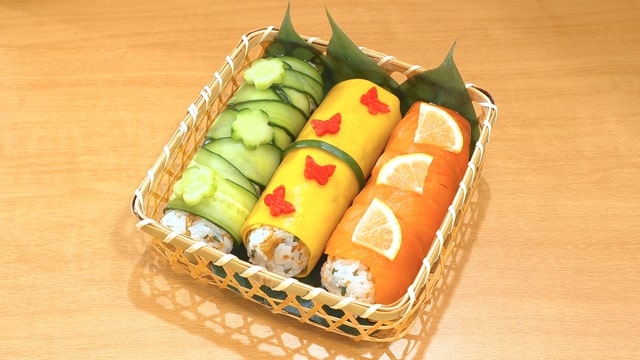
- BENTO RECIPES
- from Episode 12 / Season 8.
- Wrap and Roll Sushi Bento
- (1062 kcal)
-
 by Maki Ogawa
by Maki Ogawa
Bento contents:
- Wrap and Roll cucumber sushi
- Wrap and Roll egg omelette sushi
- Wrap and Roll smoked salmon sushi
Ingredients:
For the sushi rice
- 390 g hot rice
- 3 tbsp sushi vinegar
- 25 g walnuts
- 5 shiso leaves
For the cucumber-wrapped sushi roll
- 8 slices cucumber (cut into 14.5 cm long thin slices)
- 2 slices of cucumber (cut out using a floral-shaped cookie cutter) for decoration
For the egg-wrapped sushi roll
- 1 egg
- 1/2 tsp sugar
- 1tsp water
- 1/2 tsp potato starch
- For decoration
- 1 g cucumber peel
- 2 butterfly shapes made with red pickled daikon
For the salmon-wrapped sushi roll
- 3 slices (45 g) smoked salmon
- 2 slices lemon
Directions:
For the sushi rice
1. Place the walnuts in a plastic bag and use the palm of your hand to press down 5 or so times to crush roughly.
2. Cut the shiso leaves into threads.
3. Cook the rice, allow to cool slightly, and fold in the sushi vinegar, walnuts, white sesame seeds, and shiso.
4. Divide the sushi rice into 3 equal segments (approx.150 g each), wrap with plastic wrap (10 cm x 4 cm), and shape into rolls.
For the cucumber-wrapped sushi roll
1. Use a vegetable peeler to cut the cucumber into 8 or 9 thin slices 14.5-15 cm long.Sprinkle with a pinch of salt and set aside to draw out the excess moisture. Pat dry with paper towels.
2. Cut out two floral shapes from the remaining cucumber. Sprinkle with salt and set aside to draw out the excess moisture. Pat dry with paper towels.
3. Peel the cucumber to make a 2 mm x 15 cm strip. Sprinkle with salt and set aside to draw out the excess moisture. Pat dry with paper towels.
4. Assemble the sushi roll. Place the sushi roll on the chopping board and cover with cucumber slices, first horizontally and then diagonally (refer to video). Cover with plastic wrap to seal, then set aside for 10 minutes.
5. Uncover and decorate with cucumber flowers.
For the egg-wrapped sushi roll
1. Beat the eggs. Mix the potato starch and water. Add the sugar and potato starch slurry to the eggs and mix well. Filter through a tea strainer. Preheat the non-stick frying pan over low heat and make a thin omelette.
2. Use a butterfly-shaped cookie cutter to cut out two pieces of red daikon. Soak in 1 tbsp of sushi vinegar.
3. Cut the omelette to the length of the sushi roll. Place on top of a sheet of plastic wrap, followed by the sushi roll, and wrap and roll. Set aside for about 10 minutes.
4. Wrap the cucumber peel around the roll and decorate with red daikon butterflies.
For the salmon-wrapped sushi roll
1. Place the smoked salmon on a sheet of plastic wrap to match the length of the sushi roll. Wrap and roll. Set aside for about 10 minutes.
2. Decorate with lemon slices.
-
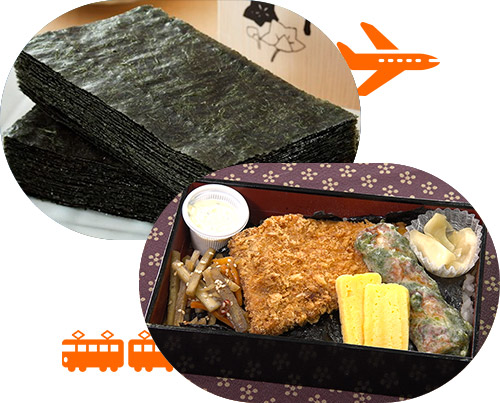
- BENTO TOPICS
- from Episode 12/ Season 8.
- Omori
-
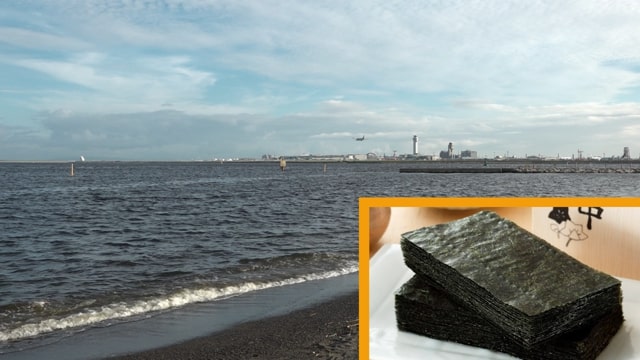
Bento Topics. Haneda Airport is nicknamed the gateway to Tokyo. Today, we visit nearby Omori. Facing the bountiful waters of Tokyo Bay, Omori was a major producer of nori back in the Edo Period. Nori, a dried edible seaweed, is indispensable for sushi rolls and other dishes.
-
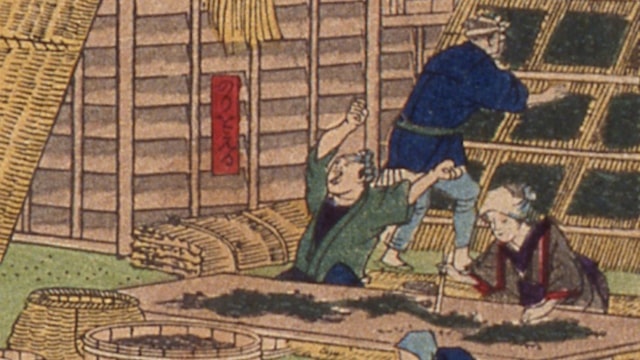
The history of nori cultivation in Omori can be traced back to the Edo Period several centuries ago. Omori’s thriving nori industry was unable to withstand the tide of urbanization and came to an end in the 1960s.
However, it's still home to many professional nori wholesalers. -
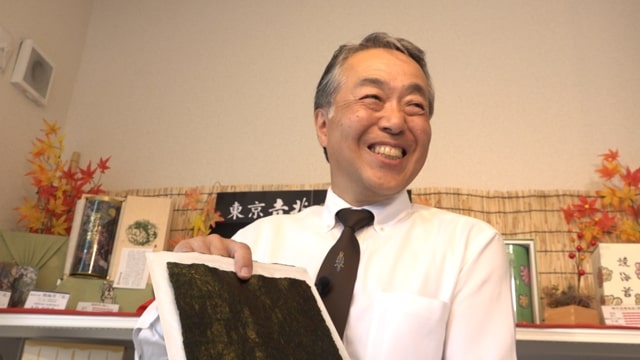
This wholesaler has been in business for 150 years and supplies the finest nori to Japan’s leading sushi shops and restaurants.
When held up to light, good nori has a pretty dark green color. One bite, and the aroma fills the palate, followed by a burst of flavor.
-
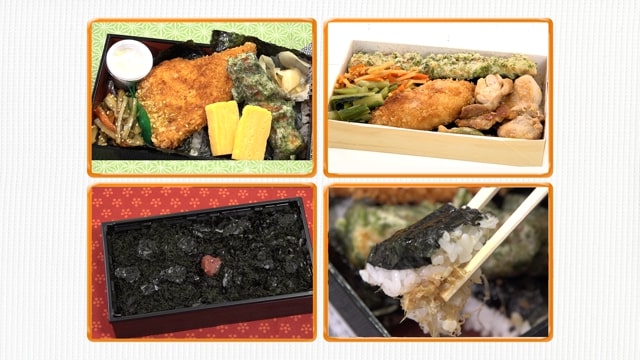
Nori-ben, short for nori bento, is a bento that features nori. Rice covered with nori is topped with main and side dishes. It’s an all-time favorite in Japan. There are special type covered just with top grade nori.
There's even a special type that's totally covered with top-grade nori. -
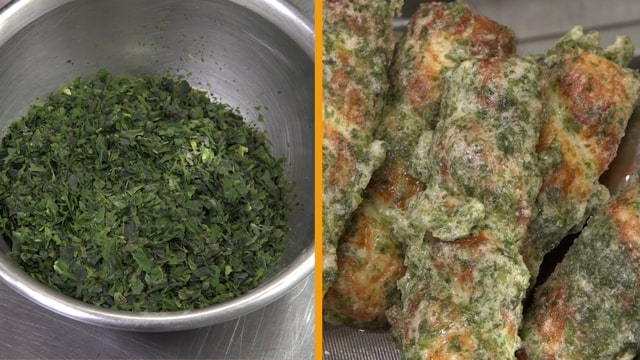
Fritters made of chikuwa fish cakes are typically served on top of the nori-covered rice. The batter contains aonori, a green nori with a distinctive aroma of the sea.
-
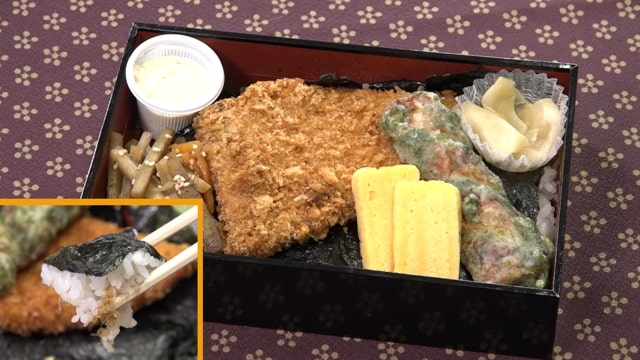
The nori-ben is packed with chikuwa fritters, fried fish, tamagoyaki, and sweet and savory simmered vegetables. The nori underneath can barely be seen!
Underneath the nori is an umami-rich layer of katsuobushi and soy sauce.
Every bite of this nori-ben is filled with the scent of the ocean.
-
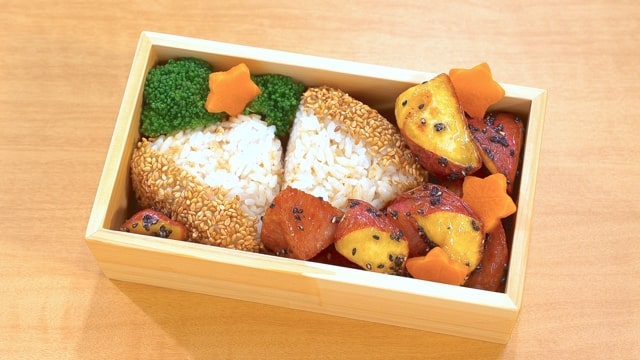
- BENTO RECIPES
- from Episode 11 / Season 8.
- Acorn Onigiri Bento
- (660 kcal)
-
 by Marc Matsumoto
by Marc Matsumoto
Bento contents:
- Acorn Onigiri
- Daigaku-imo and glazed ham
- Boiled broccoli
- Maple leaf carrot slices
Ingredients:
For Acorn Onigiri
Yields 4 Onigiri
- 380 g cooked Japanese short-grain rice
- 4 g katsuobushi (skipjack tuna flakes)
- 1 tsp soy sauce
For Daigaku-imo and glazed ham
Makes enough to pack into 2 bentos
- 200 g Japanese sweet potatoes
- 150 g luncheon meat, or ham
- Vegetable oil for frying
- 1 tbsp granulated sugar
- 1 tbsp honey
- 1 tbsp water
- 2 tsp black sesame seeds
Directions:
For Acorn Onigiri
1. Put the hot rice in a large bowl and sprinkle with the katsuobushi. Fold it into the rice until evenly mixed.
2. Drizzle the soy sauce evenly over the rice and then fold it in until the rice is uniform in color.
3. Divide the rice into 4 segments and then shape them into onigiri.
For Daigaku-imo and glazed ham
1. Cut the Japanese sweet potatoes into bite-sized pieces using an oblique cut.
2. Add the sweet potatoes to a microwave-safe bowl, and then add 1 tablespoon of water. Cover the bowl and steam the sweet potatoes in the microwave at 800 watts for 3 minutes.
3. Dry off the surface of the luncheon meat or ham using paper towels, then cut it into pieces that are about the same shape and size as the sweet potatoes using an oblique cut.
4. Heat the oil to 340 degrees F (170 degrees C).
5. Deep fry the steamed sweet potatoes until golden brown and crisp on the outside. Transfer to a bowl and set aside.
6. Deep fry the luncheon meat until golden brown. Transfer to a bowl and set aside.
7. Add the sugar, honey, and water to a frying pan and cover with a lid. Turn the heat on and let the mixture boil until the sugar dissolves.
8. Remove the lid and cook the mixture until it starts to caramelize.
9. Add the fried luncheon meat and sweet potatoes and toss to coat. Sprinkle with black sesame seeds.
-

- BENTO RECIPES
- from Episode 11 / Season 8.
- Japanese-style Baguette Sandwich Bento
- (1174 kcal)
-
 by Maki Ogawa
by Maki Ogawa
Bento contents:
- Pork Shabu-shabu Sandwich
- Japanese-style Scrambled Egg Sandwich
- Acorn Kids
- Mini tomatoes
- Lettuce
Ingredients:
For the Pork Shabu-shabu Sandwich
- 2 mini baguettes
- 120 g pork shoulder loin (thinly sliced)
- 14 g lettuce
- Sesame sauce:
- 1 tbsp ground sesame
- 2 tsp miso
- 5 g sugar
- 20 g mayonnaise
- 1 tsp rice vinegar
- 1 tsp sesame oil
- A pinch each of salt and pepper
- Mayonnaise for the bread (2 g per baguette)
- Mustard for the bread (1 g per baguette)
For the Japanese-style Scrambled Egg Sandwich
- 1 mini baguette
- 2 eggs
- 5 g sugar
- 1/2 tsp soy sauce
- 15 g mayonnaise
- A dash of oil for scrambling the eggs
- 2 g mayonnaise for the bread
- 1 g mustard for the bread
For the Acorn Kids
- 3 sausages
- 2 slices cheese
- A small piece of nori
Directions:
For the sandwiches
1. Combine the sesame sauce ingredients.
2. Bring a pot of water to a boil. Reduce the heat,add the sliced pork, and cook for about a minute. Drain and cool under running water, and pat dry.
3. If necessary, cut the pork into smaller pieces before adding to the sesame sauce.
4. Beat the eggs, sugar, and salt. Oil the pan and heat. Heat the frying pan and drizzle with oil. Pour in the egg mixture and cook the scrambled eggs.
5. Cool to room temperature, add the mayonnaise, and mix.
6. Cut the three baguettes into three equal pieces and use a toaster oven to lightly toast for 2-3 minutes. Spread with mayonnaise and mustard.
7. Sandwich the pork or scrambled egg filling along with some lettuce.
For the Acorn Kids
1. Cut the sausages into two or three pieces.
2. Make a stack of sliced cheese, and use a cookie cutter to cut out circles.
3. Top the cut-end of each sausage with cheese, and fasten with a toothpick. Use the nori for the eyes and mouth.
-
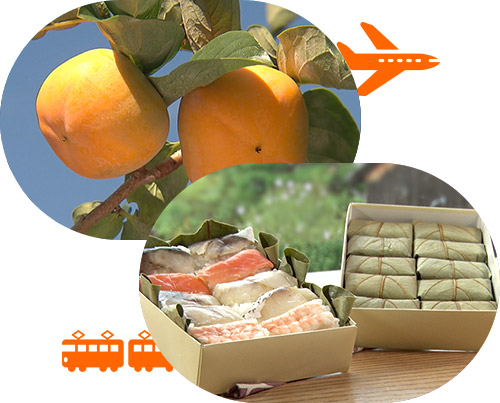
- BENTO TOPICS
- from Episode 11/ Season 8.
- Nara
-
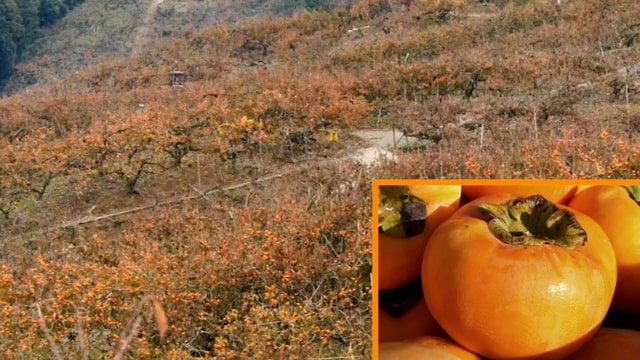
Bento Topics. Today, from the ancient capital of Japan, Nara.
Bright orange persimmons are a key part of Nara’s autumn landscape. Both the fruit and the leaves are integral to local life. -
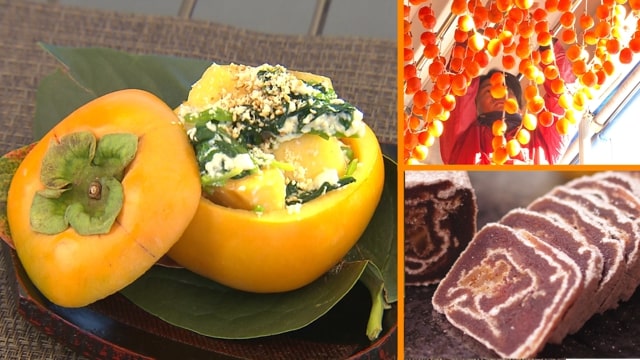
This is a local dish of sliced persimmons mixed with tofu and vegetables. Sun-dried persimmons have long been a vital source of vitamins in winter. They're also used to make traditional rolled sweets that symbolize good luck.
-
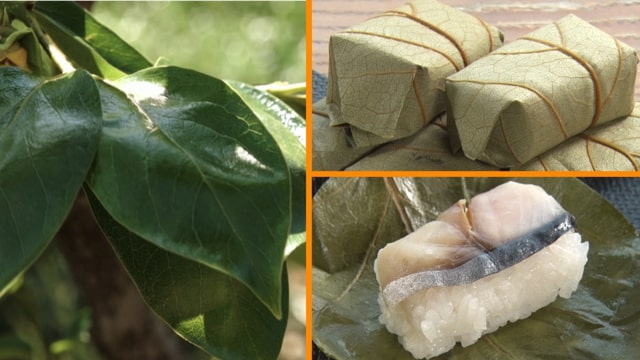
Nara is famous for its kakinoha-zushi, a local specialty of Yoshino in southern Nara. It consists of bite-size pieces of sushi rice and sliced mackerel or salmon, wrapped up in persimmon leaves.
Nara is far from the ocean. But by using the antibacterial properties of persimmon leaves, people in this area have long been able to enjoy fish. The subtle aroma of the persimmon leaf is transferred to the sushi, giving it a unique flavor.
-
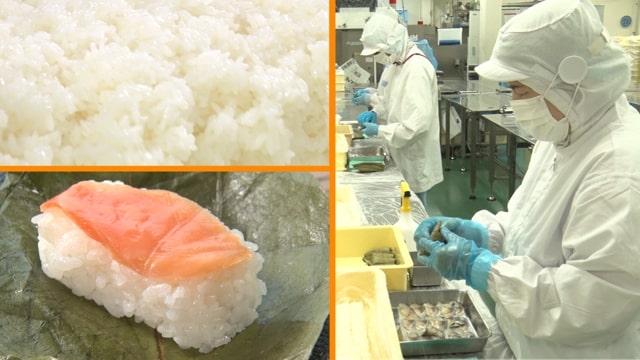
This long-established restaurant started out as a rice store in Yoshino. The rice is cooked in a secret blend of sweet vinegar and dashi that goes well with salted fish. Salt-pickled persimmon leaves are used to wrap sushi rice with fish marinated in seasoned vinegar. The wrapping is done by hand.
-
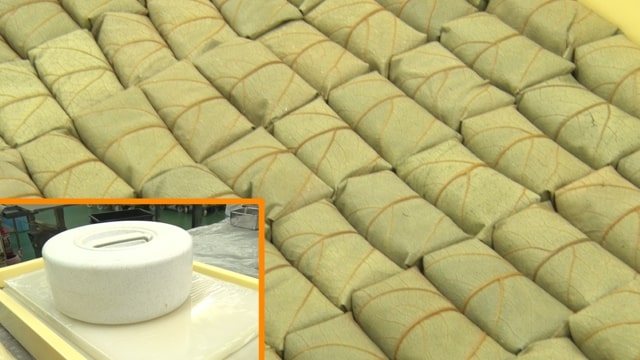
A heavy weight is placed on top to press and ferment the sushi to boost the flavor and aroma.
The sweet sushi rice, umami-rich fish, and aromatic persimmon leaf create a delicious harmony of flavors. -
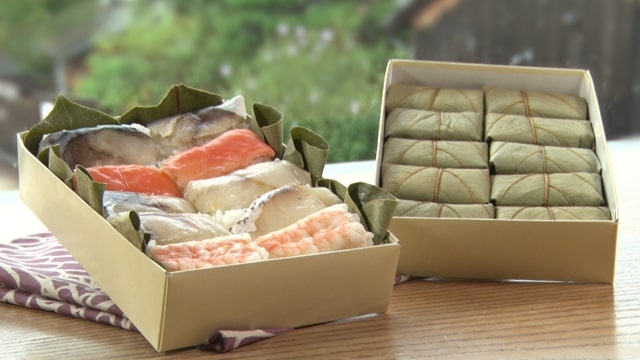
In addition to mackerel and salmon, the store’s best selling bento includes kakinoha-zushi made with sea bream, horse mackerel, and shrimp. This local specialty bento is ideal for enjoying both cherry blossoms and autumnal colors.
-
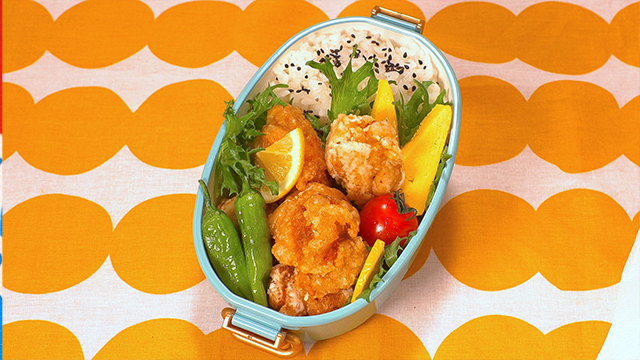
- BENTO RECIPES
- from Episode 10 / Season 8.
- Chicken Kara-age Bento
- (676 kcal)
-
 by Marc Matsumoto
by Marc Matsumoto
-
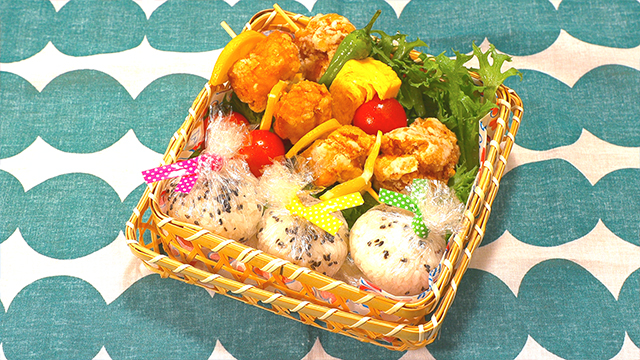
-
 by Arisa Adams
by Arisa Adams
- (571 kcal)
Bento contents:
- Rice
- Chicken kara-age
- Lemon slices
- Lettuce
- Tamagoyaki
- Black sesame seeds
- Deep-fried shishito peppers
- Cherry tomato
Ingredients:
Makes enough to pack into 3 bentos
- 450 g skin-on chicken thighs
- 2 tbsp soy sauce
- 1 tbsp sake
- 15 g fresh ginger (grated)
- 100 g potato starch
- Oil for frying
Directions:
1. Cut the chicken thigh into bite-sized pieces that are roughly the same weight.
2. Mix the soy sauce, sake, and grated ginger, then add the chicken pieces. Stir to coat evenly and refrigerate overnight.
3. When you're ready to fry the kara-age, prepare a cooling rack lined with three sheets of paper towels.
4. Preheat 4 cm of oil in a pot heated to 170 degrees C (340 degrees F).
5. Add the potato starch to a tray and roll each piece of chicken into a ball with the skin on the outside. Roll each piece around in the starch until evenly coated, and use your fingers to shape into a ball.
6. Deep fry the chicken in batches until it is golden brown and cooked through. How long this takes will depend on the size of your chicken pieces, but you can use an instant-read thermometer to check for doneness (it should read 70 degrees C).
7. Drain the kara-age on the paper towel-lined rack.
-
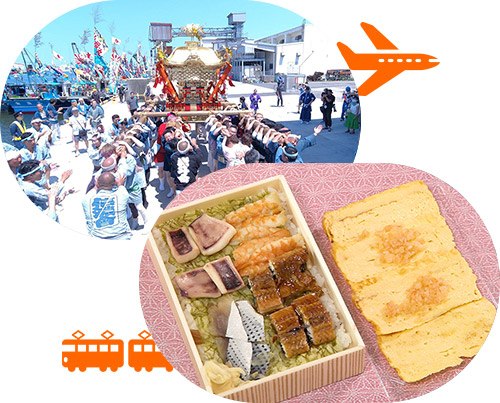
- BENTO TOPICS
- from Episode 10/ Season 8.
- Niigata
-
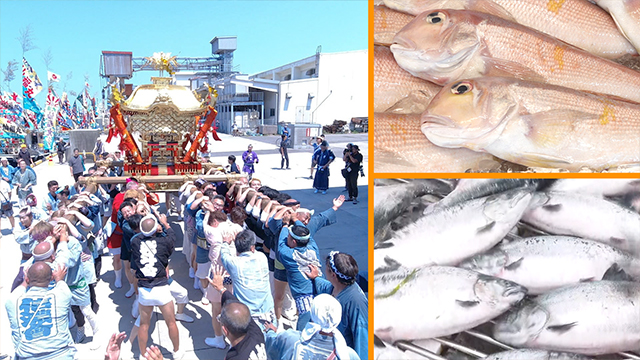
Bento Topics. Today from Niigata, a major port city facing the Sea of Japan. The Niigata Festival is a three-day event held in summer to pray for the prosperity of the port and its fisheries.
It dates back over three centuries. Niigata’s rich fishing grounds are teeming with fish all year round. -
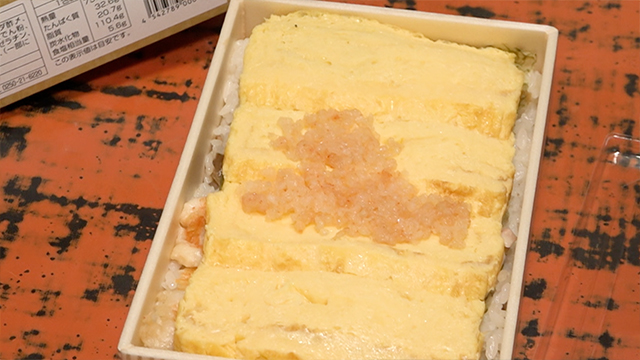
It’s no surprise that this local specialty bento features seafood. But when opened, diners are greeted by big pieces of tamagoyaki. Four kinds of seafood are hidden underneath to make a mixed sushi bento. It was devised by the playful president of a bento company who wanted to create a bento with a surprise element.
-
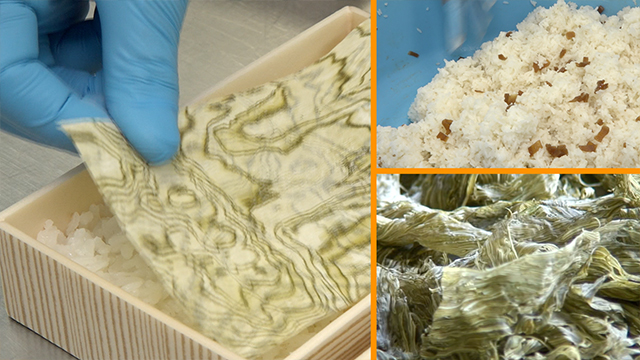
Sweetly simmered kanpyo, or dried gourd, is mixed into the sushi rice for added flavor and texture.
This is then covered with a marbled sheet of tororo konbu: shaved kelp softened in vinegar and dried.
Rich in umami, it brings out the flavor of the seafood.
-
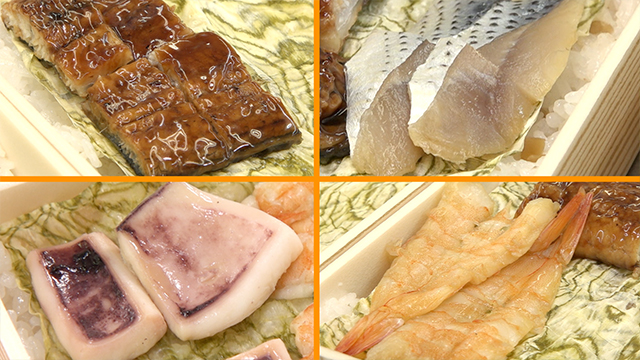
Then comes the seafood. The plump grilled eel is glazed with a sweet and savory sauce. The steamed shrimp and pickled kohada are dipped in wasabi soy sauce. The squid has been sun-dried overnight to concentrate the umami flavor. It’s a specialty of Niigata’s Sado Island.
-
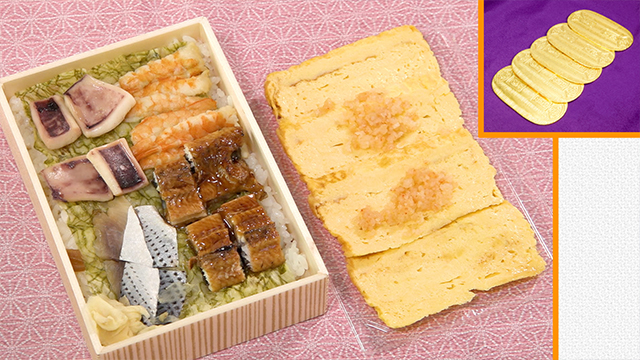
The tamagoyaki is in the shape of gold coins from the Edo Period as a sign of good fortune. And finally, some sweet and savory minced shrimp top off the bento. It’s like a treasure chest!
-
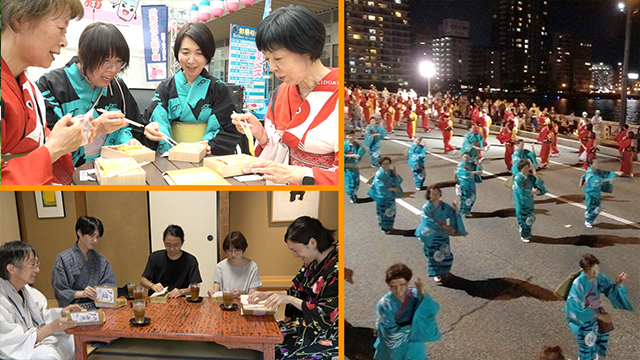
Dancers participating in the festival parade fill up on the seafood surprise bento to get ready to dance through the night. It’s show time!
-
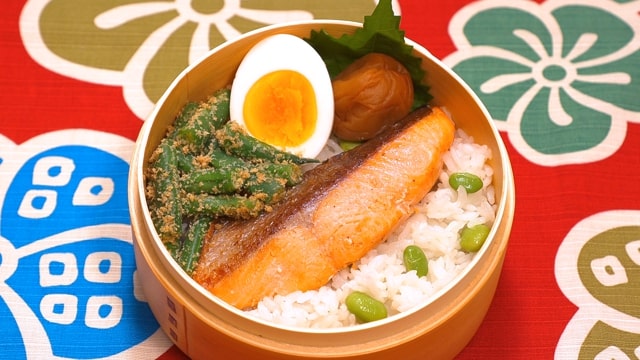
- BENTO RECIPES
- from Episode 9 / Season 8.
- Salt-cured Salmon (Shiozake) Bento
- (576 kcal)
-
 by Marc Matsumoto
by Marc Matsumoto
-
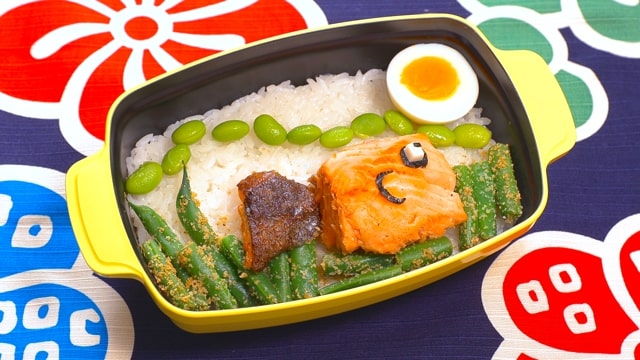
-
 by Arisa Adams
by Arisa Adams
- (397 kcal)
Bento contents:
- Edamame rice
- Salt-cured Salmon (Shiozake)
- Shiso
- Green bean goma-ae
- Boiled egg
- Umeboshi
Ingredients:
For Salt-cured Salmon (Shiozake)
Yields 2 pieces of salmon
- 240 ml water
- 1 tbsp mirin
- 1 1/4 tsp table salt
- 150 g salmon (2 small fillets)
- 1 tsp vegetable oil
- 25 ml water
For Green Bean Goma-ae
- 117 g green beans (ends trimmed off)
- 2 tsp soy sauce
- 1/4 tsp sugar
- 1 1/2 tbsp sesame seeds
Directions:
For Salt-cured Salmon (Shiozake)
1. Add 240 ml water, mirin, and table salt to a storage container or zipper bag and stir to dissolve the salt. Add the salmon and brine overnight. When you're ready to cook the salmon, remove it from the brine and pat dry with paper towels.
2. Preheat a frying pan over medium heat until hot, and add the oil and salmon skin-side down. Use a spatula to press the skin into the pan if needed.
3. Once you have some light browning on the skin side, flip the salmon over and add 25 ml water. Immediately cover with the lid and let the salmon steam until it's cooked through.
For Green Bean Goma-ae
1. Bring a pot of well-salted water to a rolling boil and add the green beans. Boil the beans until tender (3-5 minutes), but not so long that they lose their color.
2. Drain the beans and then pat them dry with paper towels. Cut the beans into bite-size pieces and add them to a bowl with the soy sauce and sugar. Mix to combine.
3. Add the ground sesame seeds and toss to coat evenly.
-
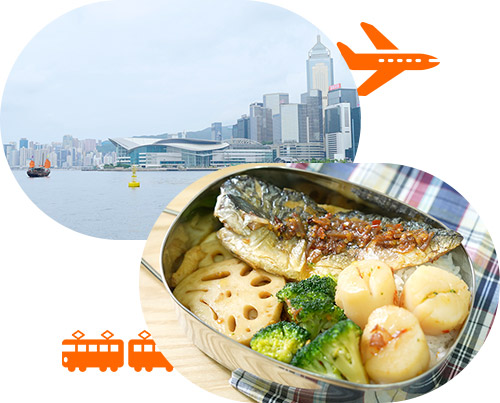
- BENTO TOPICS
- from Episode 9/ Season 8.
- Hong Kong
-
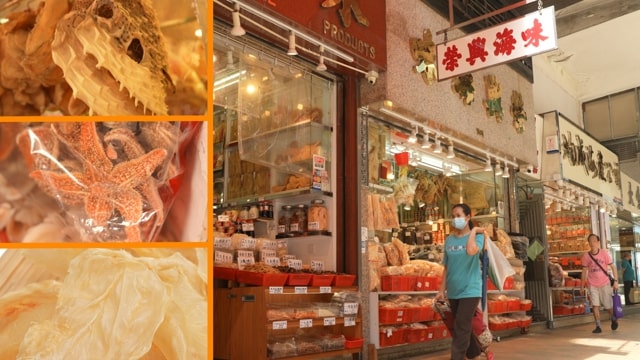
Bento Topics. Today from Hong Kong. At the foot of the skyscrapers is Dried Seafood Street, an area that retains an old-fashioned atmosphere. Customers can stock up on everything essential to Hong Kong cuisine, from typical ingredients like dried shrimp and oysters, to unusual ingredients like pufferfish skin, starfish, and swim bladders.
-
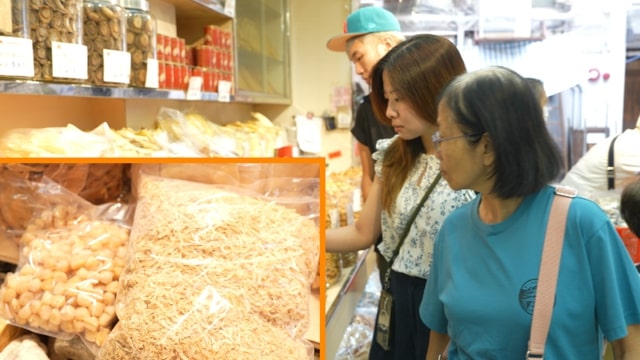
Lin and her children are regulars at Dried Seafood Street. Today, they’ve come to their favorite store to buy dried shrimp and scallops to make XO sauce from scratch.
-
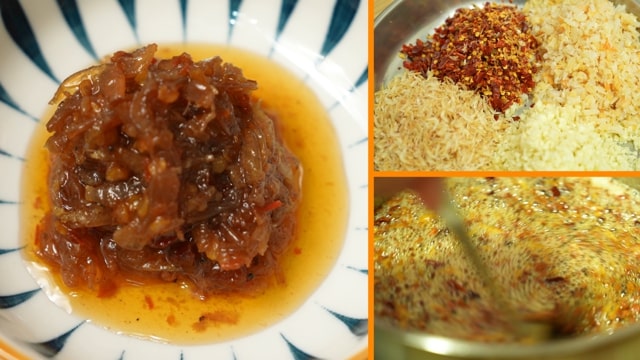
XO sauce is a spicy condiment from Hong Kong that’s full of seafood umami. Rehydrated dried scallops and shrimp are simmered in oil with garlic and chili peppers. Lin's XO sauce became famous on social media after her daughter, Mei, shared it with her friends.
-
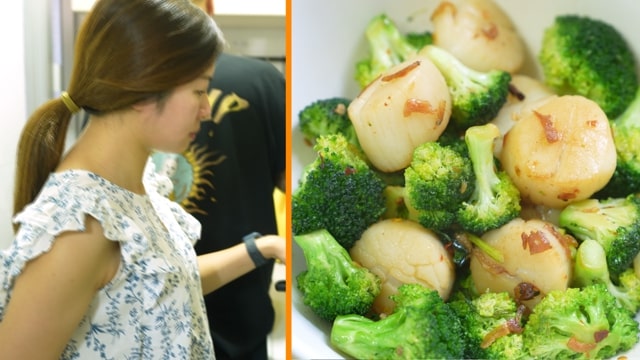
Today Mei and her brother Ki are going to use this sauce to make a bento for their mom. Mei is making the main dish of stir-fried fresh scallops and broccoli, seasoned with nothing but the flavorful and spicy XO sauce. A double scallop dish.
-
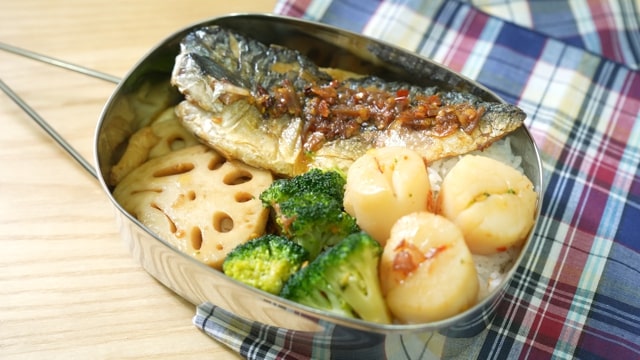
The second dish is pan-fried crispy mackerel topped with a generous amount of XO sauce. A perfect match! The XO sauce gives this seafood bento a special Hong Kong flavor.
-
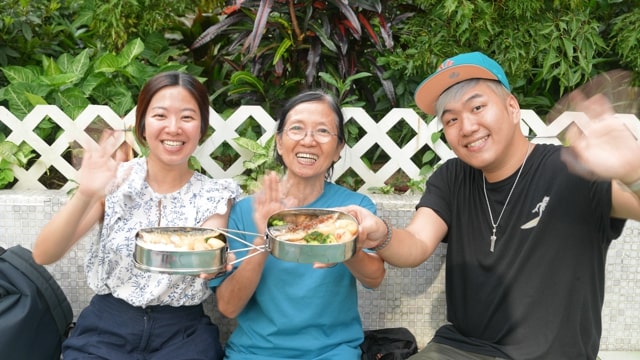
Lin is all smiles as she opens the bento her children made for her that features her original XO sauce. A Hong Kong bento packed with the taste of home.
-
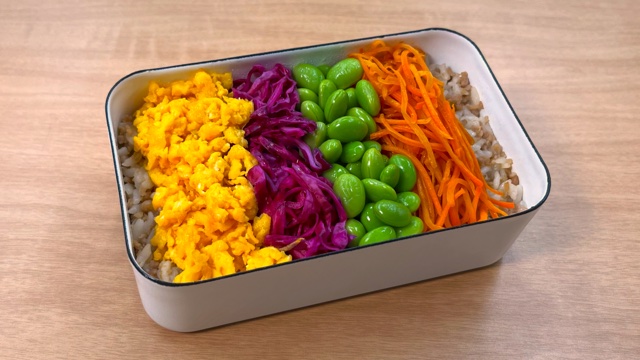
- BENTO RECIPES
- from Episode 8 / Season 8.
- Rainbow Soboro Bento
- (697 kcal)
-
 by Marc Matsumoto
by Marc Matsumoto
Bento contents:
- Chicken Soboro Rice
- Shelled edamame
- Kinpira carrots
- Red cabbage quick pickles
- Egg soboro
Ingredients:
Makes enough to pack into 2 bentos
For Chicken Soboro Rice
- 200 g ground chicken thighs
- 1 tbsp soy sauce
- 1 tbsp 3S sauce (equal parts soy sauce, sake, sugar)
- 3 g ginger, grated
- 1/2 tsp vegetable oil
- 1 rice cooker cup rice, cooked
For kinpira carrots
- 1/2 tsp vegetable oil
- 50 g carrots, shredded with a mandoline
- 2 tsp 3S sauce (equal parts soy sauce, sake, sugar)
For quick-pickled red cabbage
- 50 g cabbage, thinly shredded
- 1 tbsp seasoned sushi vinegar
For egg soboro
- 1/2 tsp vegetable oil
- 1 egg
- 1 pinch sugar
- 1 pinch salt
Directions:
1. Mix the cabbage with the seasoned sushi vinegar and let the mixture quick-pickle for at least 1 hour.
2. Mix the ground chicken thighs with the soy sauce, 3S sauce, and grated ginger until well combined.
3. Beat the egg with a pinch of sugar and salt until uniform in color.
4. Heat a small non-stick frying pan over medium heat. Add 1/2 teaspoon of oil along with the egg. Rapidly stir with chopsticks to form small crumbs of egg. Transfer to a plate.
5. Wipe the pan with paper towels and add another 1/2 teaspoon of oil, along with the shredded carrots. Stir-fry until the carrots begin to go limp.
6. Add 2 teaspoons of 3S sauce and stir-fry until no liquid is left in the pan. Transfer to a plate to cool.
7. Wipe the pan with paper towels and add another 1/2 teaspoon of oil and the ground chicken mixture.
8. Stir-fry while breaking up any clumps with the side of a spatula until the chicken is fully cooked and no liquid is left in the pan.
9. Add the chicken soboro into the cooked rice and fold it in to the rice.
10. Pack the bentos by dividing the soboro chicken rice between two bento boxes and topping with the pickled cabbage, edamame, egg soboro, and kinpira carrots.
-
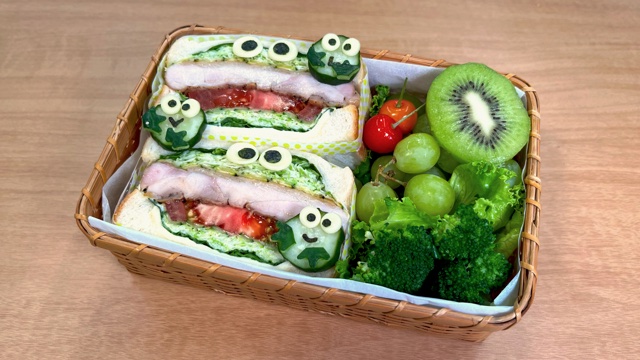
- BENTO RECIPES
- from Episode 8 / Season 8.
- Green Veggies and Chicken Sandwich Bento
- (912 kcal)
-
 by Maki Ogawa
by Maki Ogawa
Bento contents:
- Green Veggies and Chicken Sandwich
- Kiwi
- Green grapes
- Cherries
- Broccoli
- Lettuce
- Shiso leaves
Ingredients:
For Green Veggies and Chicken Sandwich
- 2 slices white bread
- 1 1/4 slices cheese
- 10 g or more mayonnaise (preferably Japanese)
- 95 g chicken thigh
- 30 g lettuce
- 40 g cabbage
- 25 g cucumber (preferably long and thin)
- 6 shiso leaves
- A pinch each of salt and pepper
- 30 g zucchini
- 1/3 tsp olive oil
For the frog decoration
- 15 g cucumber
- A sliver of cucumber peel
- A piece of sliced cheese
- A piece of nori
Directions:
For Green Veggies and Chicken Sandwich
- Tear the lettuce to match the size of the bread.
- Use a vegetable peeler to shred the cabbage.
- Cut the tomato into thin slices and pat dry with a paper towel.
- Use a vegetable peeler to cut the cucumber (25 g) into thin slices to match the size of the bread. Save a sliver of peel for the frog decoration. Sprinkle with a pinch of salt and set aside for five minutes. Squeeze out the excess moisture.
- Use a peeler to cut the zucchini into thin slices. Season with olive oil, salt, and pepper.
- Remove the excess fat and sinews from the chicken. Score the skinless side at 1 cm intervals to allow the chicken to cook through evenly. Sprinkle a generous amount of salt and pepper on both sides.
3. Place one slice of bread on a sheet of plastic wrap and spread with mayonnaise. Add one slice of cheese, half the amount of lettuce, shredded cabbage, shiso leaves, tomatoes, and chicken in layers. Then, add the remaining cabbage and lettuce, also in layers. Stagger the cucumbers and stack. Add extra mayonnaise or salt and pepper in between the layers, to taste.
4. Spread the other slice of bread with mayonnaise and finish assembling the sandwich.
5. Bring the plastic wrap around the sandwich to seal.
6. Wrap masking tape around the center to mark where to cut, and set aside for 5 minutes.
7. Cut in half.
For the frog decoration
1. Cut three 5 mm thick slices from the cucumber.
2. Use a straw to cut out the whites of the frog’s eyes from cheese, and the pupils from nori. Use a snow-flake shaped cookie cutter to cut out the hands from a sliver of cucumber peel.
-
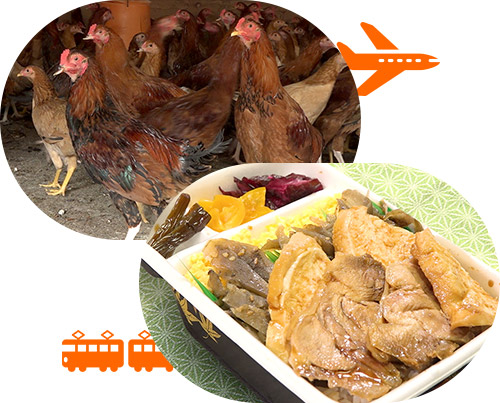
- BENTO TOPICS
- from Episode 8/ Season 8.
- Daigo, Ibaraki
-

Bento Topics, today from the town of Daigo in Ibaraki Prefecture. Surrounded by mountains, it’s a nature wonderland just a couple of hours by train from Tokyo.
-
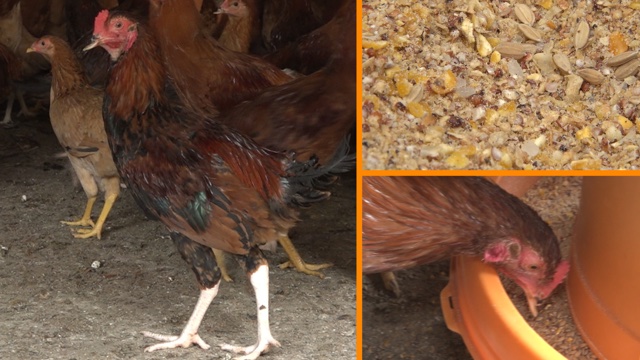
Daigo is famous for its cage-free pedigree chickens called Okukuji shamo. They’re raised over a period of time that’s three times longer than that of a typical chicken. They’re also given a special mineral-rich feed of vegetables and locally farmed rice. The meat is dense and full of umami, with flavor steeped into the chewy meat.
-
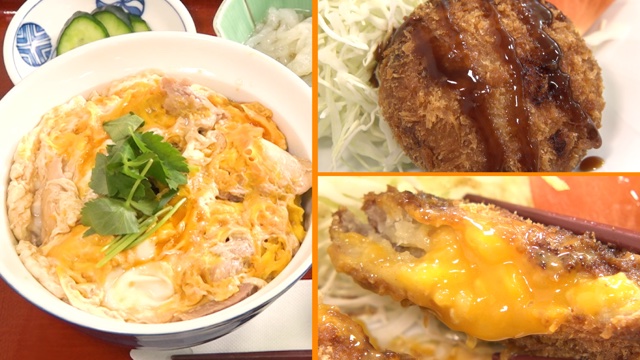
These chickens have become a Daigo specialty, with nearly 60 restaurants serving Okukuji shamo. Oyakodon, a dish of rice topped with chicken and eggs simmered in a sweet and savory sauce, is a favorite. Shamo croquettes filled with meat and creamy eggs are also very popular. But there’s more to come.
-
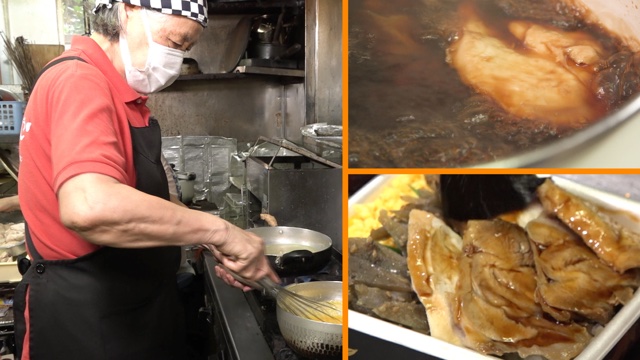
One ryokan offers a specialty bento packed with shamo simmered in a sweet and savory sauce. The sauce was developed by the sister of the current proprietress about 40 years ago.
-
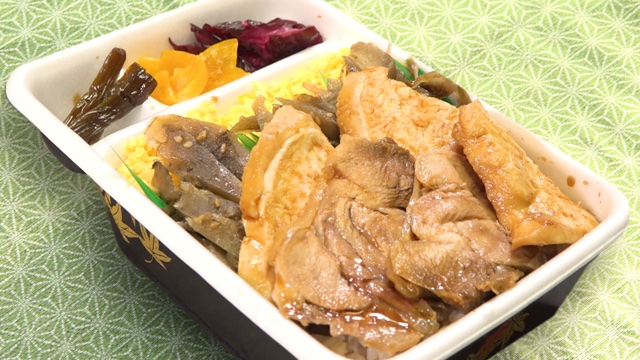
Thick slices of simmered shamo are topped with more of the sauce used for simmering. The bento also features scrambled shamo eggs, as well as sweet and savory burdock root on rice. The combination of flavorful shamo, scrambled eggs, and rice steeped with the secret sauce can't be beat.
-
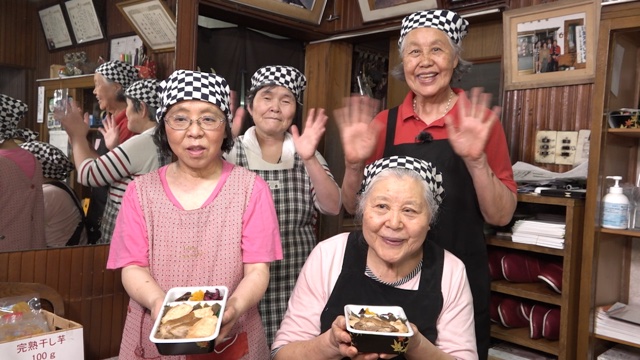
The proprietress and the people closest to her have continued to make the bento the same way for 40 years. They're determined to pass on the tradition using her sister’s secret sauce that brings out the shamo’s distinct flavor.
-
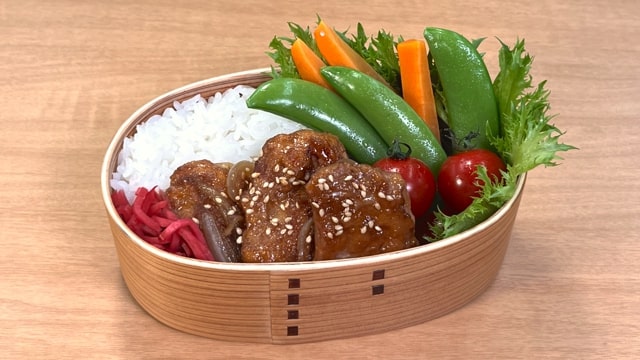
- BENTO RECIPES
- from Episode 7 / Season 8.
- Vegan Shogayaki Bento
- (510 kcal)
-
 by Marc Matsumoto
by Marc Matsumoto
Bento contents:
- Rice
- Vegan Shogayaki
- Frill lettuce
- Snap peas
- Cherry tomatoes
- Carrot sticks
- Benishoga
Ingredients:
Makes enough to pack into 2 bentos
- 1 1/2 tbsp soy sauce
- 1 tbsp 3S sauce (equal parts soy sauce, sake, sugar)
- 10 g ginger (grated)
- 40 g soy meat cutlets
- 1 tbsp potato starch
- 1 tbsp vegetable oil
- 60 g onions
- 1/2 tsp toasted sesame seeds
Directions:
1. Make the shogayaki sauce by mixing the soy sauce, 3S sauce, and grated ginger in a bowl.
2. Rehydrate the soy meat according to the package directions, then rinse it while squeezing out the water repeatedly until the water runs clear.
3. Squeeze out any excess water from the soy meat.
4. Dust the soy meat with the potato starch.
5. Heat a frying pan over medium-high heat and add the oil and soy meat in a single layer. Pan-fry until the meat is browned on one side.
6. Flip the soy meat over and add the onions in between the meat.
7. When the soy meat is browned on both sides, stir-fry it with the onions until cooked through.
8. Drizzle the shogayaki sauce over everything and toss together to coat evenly.
-
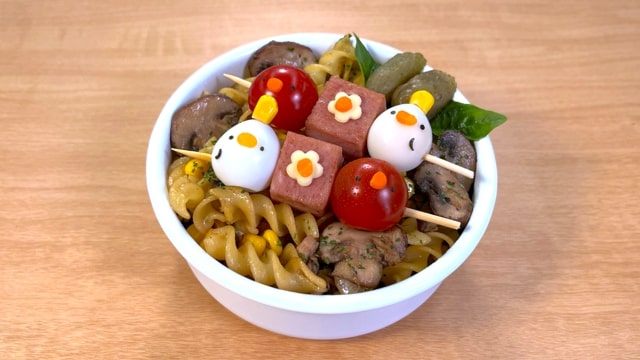
- BENTO RECIPES
- from Episode 7 / Season 8.
- Japanese-style Tuna Pasta Bento
- (699 kcal)
-
 by Maki Ogawa
by Maki Ogawa
Bento contents:
- Japanese-style Tuna Pasta
- Baby Chick Mini Skewers
- Pickles
- Basil leaves
Ingredients:
Makes enough to pack into 1 bentos
For Japanese-style Tuna Pasta
- 90 g fusilli pasta
- 50 g canned corn
- 80 g mushrooms
- 2 tbsp olive oil
- 1 clove garlic
- 70 g canned tuna in water (55 g drained)
- 1 tbsp vegetable oil
- 2 tsp soy sauce
- A pinch of black pepper
- 12 g salt
- A pinch of dried parsley
For the Baby Chick Mini Skewers (makes 2 skewers)
- 2 cherry tomatoes
- 2 quail eggs
- 2 slices luncheon meat (pan fried)
- 2 corn kernels
- A slice of carrot
- A slice of cheese
- A piece of nori
- Uncooked pasta
Directions:
For Japanese-style Tuna Pasta
1. Cut the mushrooms into thin slices, place in a food storage bag, and freeze.
2. Add 12 g of salt to 1 liter of boiling water, add the pasta, and boil for 2 minutes less than specified. Add the sliced carrot to the pot towards the end and boil for 2 minutes.
3. Drain the tuna.
4. Slice the garlic and add to the pan along with the olive oil and frozen mushrooms. Sauté over low heat until the mushrooms are tender. Then, add the tuna and sprinkle with black pepper. Add the soy sauce and simmer briefly to incorporate. Then, turn off the heat.
5. Drain the pasta and add to the pan along with the corn, and mix.
6. Set aside to cool before packing into the bento box. Sprinkle with dried parsley.
7. Thread the tomatoes, luncheon meat, and quail eggs onto bamboo skewers to make the baby chick mini skewers. (See below for details)
8. Garnish with basil and pickles.
For the Baby Chick Mini Skewers
1. Thread the ingredients onto bamboo skewers in the order of quail egg, luncheon meat, and cherry tomato.
2. Use an uncooked piece of pasta to attach the corn kernel to the egg.
3. Use a thin straw to cut out six pieces of carrot. Use four of the pieces on the eggs and tomatoes to form the beaks.
4. Use a cookie cutter to cut out floral shapes from the sliced cheese and place on top of the luncheon meat. Place the remaining carrot in the center of each flower.
-
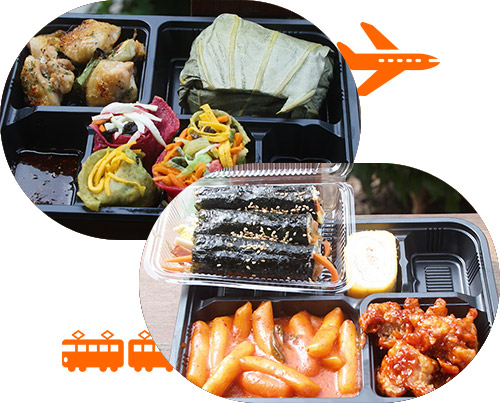
- BENTO TOPICS
- from Episode 7/ Season 8.
- Korea
-
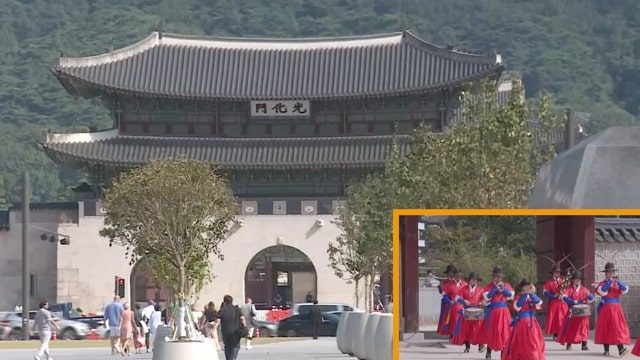
Bento Topics, today from Seoul, the capital of South Korea.
Seochon is a historic area west of the 600-year-old Gyeongbokgung Palace.
It attracts many tourists. -
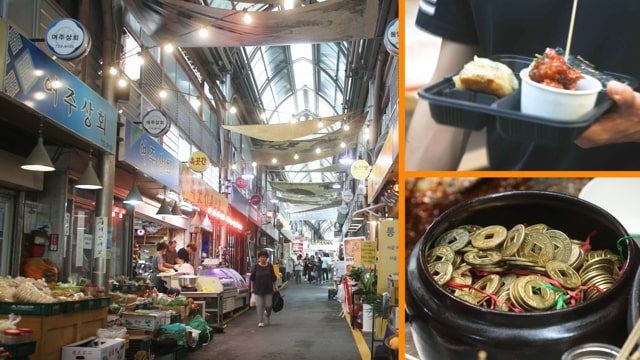
Another major attraction is Tongin Market. It has set up a unique system called the Lunchbox Café that enables visitors to sample a variety of foods.
Shoppers buy a set of tokens made to look like old coins, and pick up an empty bento box. The coins can be exchanged for single portions of food around the market, so the entire market becomes like a huge cafeteria. -
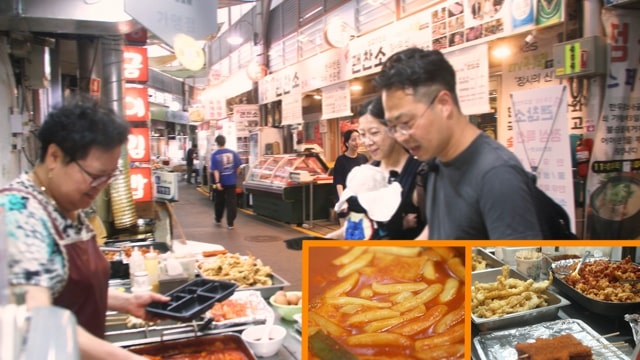
Saerom and Jaeyong run a shared office in Seoul. They’re regulars at the Lunchbox Café.
Jaeyong fills his bento with Korean comfort food such as tteokbokki, thin rice cakes, stir-fried in a sweet and spicy chili sauce. He also chooses sweet and spicy Korean-style fried chicken.
-
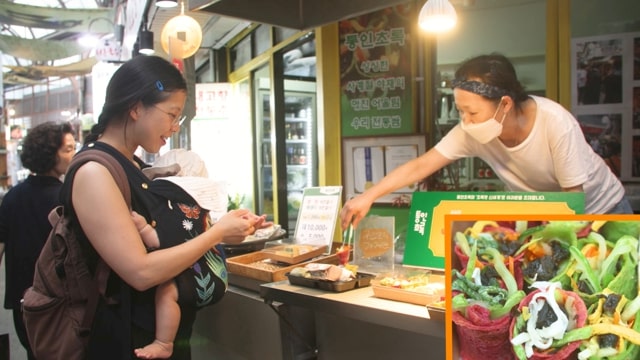
Health-conscious Saerom selects gujeolpan, a traditional royal court dish of various ingredients folded in a thin wrap. This shop uses beetroot and spinach to make colorful wraps, which are served with honey mustard. A fusion of tradition and modern tastes.
-
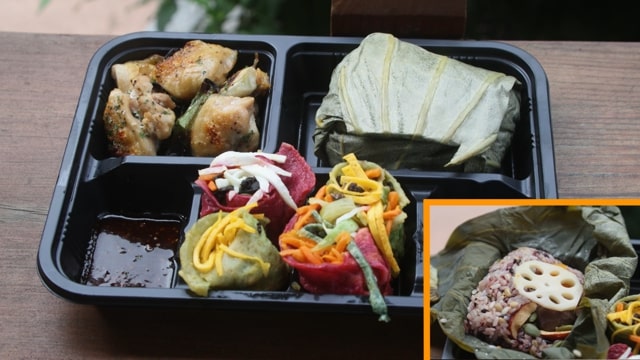
She also buys yeunipbap, steamed rice wrapped in lotus leaves. It also contains nearly 10 different grains and nuts, including chestnuts. It’s a nutritious vegetarian dish.
-
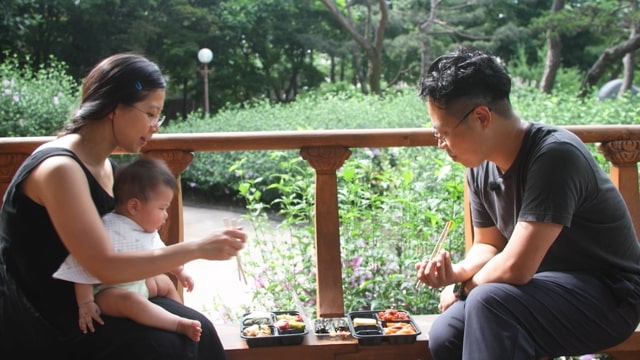
They go to a nearby park to eat.
Sweet and spicy comfort food versus healthy traditional court cuisine. Their bentos are so different! Only possible by shopping at Tongin Market’s Lunchbox Café.
-
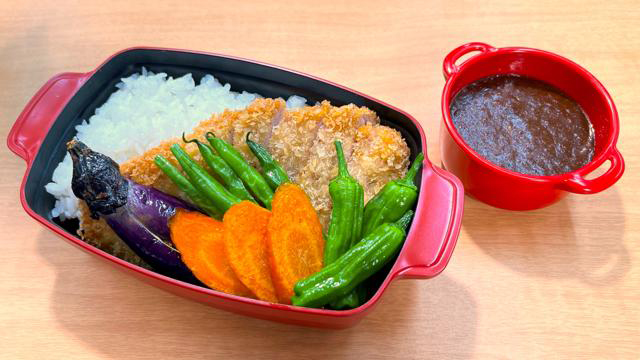
- BENTO RECIPES
- from Episode 6 / Season 8.
- Katsu Curry Bento
- (812 kcal)
-
 by Marc Matsumoto
by Marc Matsumoto
Bento contents:
- Rice
- Katsu
- Vegetables (eggplant, carrots, green beans, shishito)
- Curry sauce
Ingredients:
Makes enough to pack into 2 bentos
For curry sauce
- 1 tsp potato starch
- 1/2 tsp cocoa powder
- 175 ml low sodium chicken stock (3/4 US cup)
- 2 tbsp soy sauce
- 1 tbsp honey
- 50 g onion (~1 medium onion)
- 5 g garlic (~3 large cloves)
- 5 g ginger (peeled)
- 1 tbsp vegetable oil
- 1 tbsp Japanese curry powder
For katsu
- 2 pork boneless pork rib chops, about 1 cm thick
- Salt, to taste
- Pepper, to taste
- 3 tbsp flour
- 1 large egg, beaten in a tray
- 70 g panko, in a tray
- 1 small Japanese eggplant, cut in half lengthwise
- 1 small carrot, peeled and sliced into 5 mm thick slices
- 6 shishito peppers, poked with a knife
- 4 green beans, trimmed and cut in half
- Vegetable oil for frying
Directions:
1. Add the potato starch, cocoa powder, chicken stock, soy sauce, and honey to a bowl. Whisk to combine.
2. Heat a frying pan over medium heat. Add the grated onion, garlic, and ginger. Boil the mixture until all of the liquid evaporates and the mixture starts to brown.
3. Add the oil and sauté until the onion mixture is golden brown and caramelized.
4. Add the curry powder and quickly mix it into the onion paste until the curry powder is fragrant.
5. Give the chicken stock mixture a stir to redistribute the starch, and pour it into the pan. Turn the heat to high, and stir the mixture continuously until it thickens.
6. For the tonkatsu, salt and pepper both sides of the pork chops, then dust them with an even flour coating.
7. Dip the pork in the egg mixture with one hand to coat evenly.
8. Transfer the pork chop to the tray with the panko and cover it with an even layer of panko.
9. Heat 1 inch of vegetable oil in a deep, heavy-bottomed pot to 170 degrees C (340 degrees F).
10. Deep fry the tonkatsu until it's golden brown, flipping it over once, halfway through. Drain on a paper towel-lined rack.
11. Fry the vegetables in the oil until cooked through but still vibrant in color. For the eggplant, fry the side with skin first to set the color. Drain on a paper towel-lined rack.
-
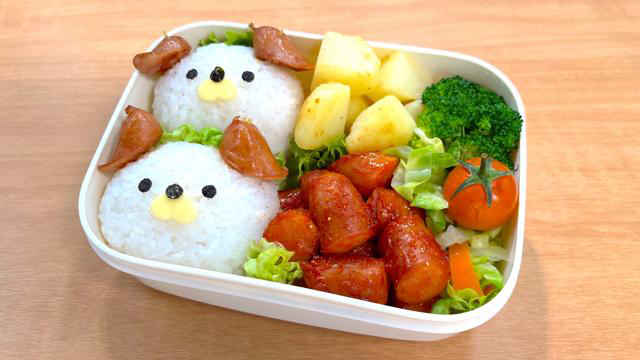
- BENTO RECIPES
- from Episode 6 / Season 8.
- Currywurst Bento
- (804 kcal)
-
 by Maki Ogawa
by Maki Ogawa
Bento contents:
- Rice
- Currywurst
- Shichimi seven spice
- Sautéed potatoes
- Parsley
- Lettuce
- Cherry tomatoes
- Boiled vegetables (Broccoli, cabbage, carrot)
- Puppy dog decoration
Ingredients:
Makes enough to pack into 2 bentos
For the Currywurst
- 6 coarse-ground sausages (135 g)
- 1/2 tsp (1-2 g) curry powder
- 60 g potato
- 1.5 tbsp ketchup
- A little parsley
- 1 tbsp sake
- A dash of vegetable oil
- A pinch of shichimi seven spice
For the puppy dog decoration
- Coarse-ground sausage
- Sliced cheese
- Nori
Directions:
For the Currywurst
1. Peel the potato and cut into 2 cm cubes. Boil for about 4 minutes, then drain and toss in the colander to create a powdery look on the surface.
2. Coat the frying pan with vegetable oil. Sauté the potatoes to a golden brown, then remove.
3. Cut the sausages diagonally into easy-to-eat pieces. Sauté the sausages until brown. Set aside 4 pieces for use as decoration.
4. Combine the ketchup, curry powder, and sake, then add to the pan to coat the sausages.
5. Pack in the bento and sprinkle the sausages with shichimi seven spice.
For the puppy dog decoration
1. Sprinkle salt over the rice and make two round onigiri rice balls.
2. Use a heart-shaped cookie cutter to cut out the muzzle from a slice of cheese.
3. Use nori for the eyes and nose.
4. For the ears, pin the sausages (set aside earlier) onto the onigiri with uncooked pasta.
-
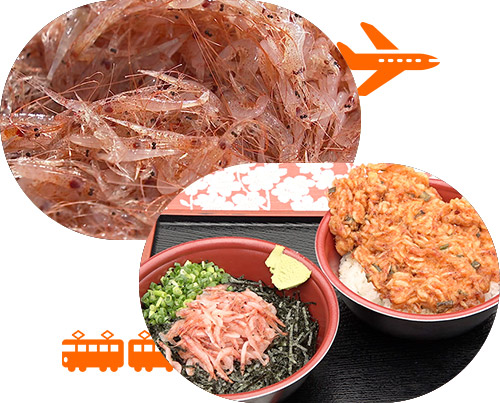
- BENTO TOPICS
- from Episode 6/ Season 8.
- Yui, Shizuoka
-

Bento Topics.
Today from Yui, a picturesque town on Suruga Bay. Fed by groundwater from Mt. Fuji, Suruga Bay is the deepest in all of Japan. It's a rich fishing ground. -
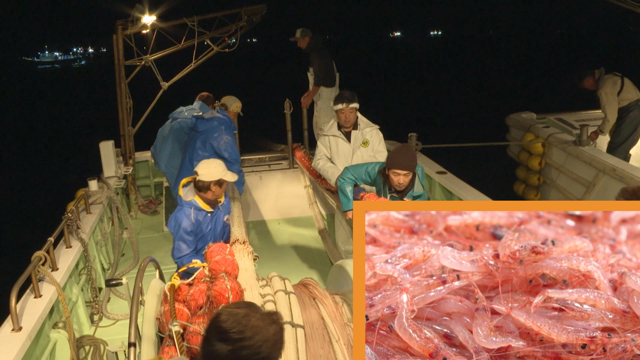
Yui is the main port for a delicacy that can only be landed in Suruga Bay: sakura ebi, or cherry blossom shrimp.
Spring and summer are the fishing seasons for these pink shrimp, which typically measure around four centimeters in length. The glimmering pink shrimp are nicknamed "the jewels of Suruga Bay." -
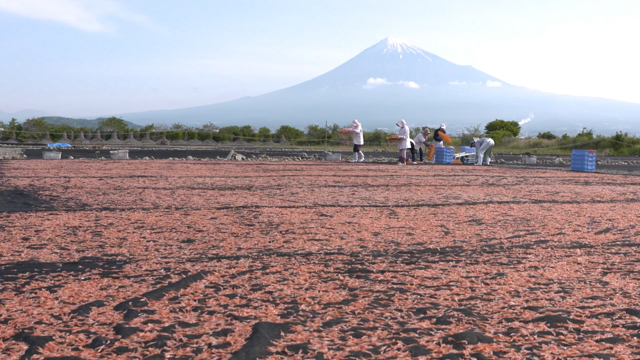
During the limited fishing seasons, the shrimp are spread out to dry under the sun. Silhouetted by Mt. Fuji, the shrimp form a red carpet. It’s a picturesque sight that can only be seen here.
The sea breeze also helps to concentrate the umami flavor.
-
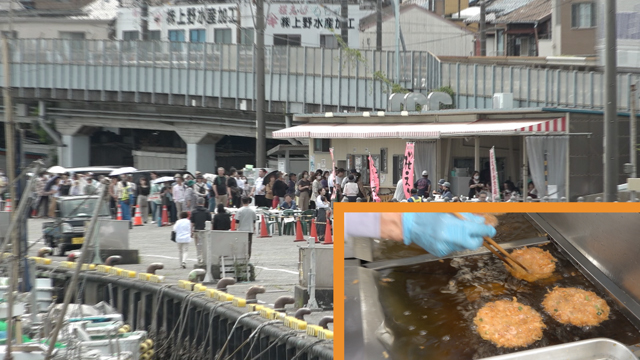
Visitors from all over flock to the restaurant run by the Yui Fishery Association for their specialty bentos packed with sakura ebi. Some visitors come from hundreds of kilometers away and are willing to stand in line for hours!
-
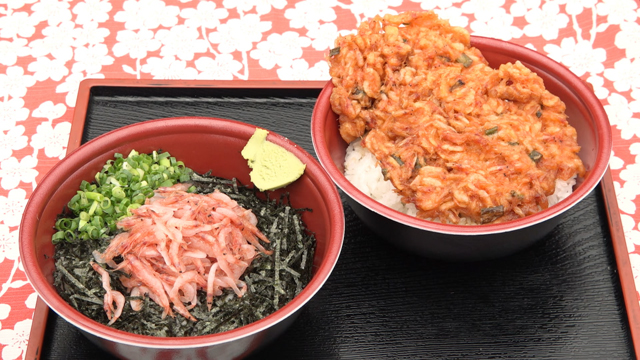
One of the specialty bentos is a bowl of rice topped with nori and a huge serving of freshly caught cherry shrimp, which are sweet and full of flavor.
The other signature bento features fritters made with sakura ebi. The fritters are dipped in a sweet and savory sauce and placed over rice to make a crisp and fragrant bento. -
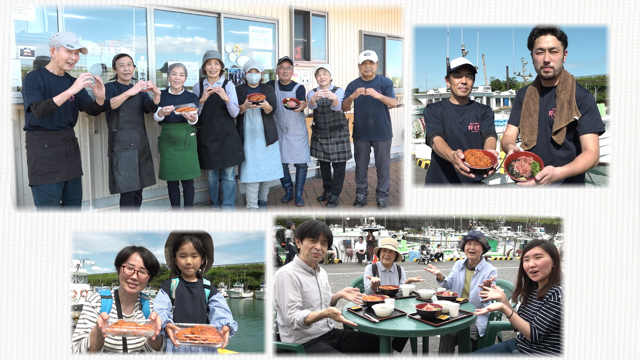
These specialty bentos can only be savored here in Yui.
The faces of visitors tucking into their bentos are all smiles!
-
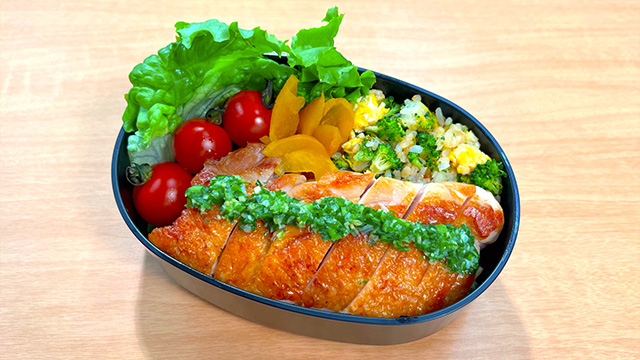
- BENTO RECIPES
- from Episode 5 / Season 8.
- Scallion Oil Chicken Bento
- (851 kcal)
-
 by Marc Matsumoto
by Marc Matsumoto
Bento contents:
- Scallion Oil Chicken
- Broccoli Fried Rice
- Cherry tomatoes
- Frill lettuce
- Yellow Tsubozuke
Ingredients:
Makes enough to pack into 2 bentos
For Scallion Oil Chicken
- 400 g skin-on boneless chicken thigh
- 1 tbsp sake
- 1/4 tsp salt
- 20 g scallions, minced
- 5 g ginger, minced
- 1/4 tsp salt
- 2 tbsp vegetable oil
For Broccoli Fried Rice
- 100 g broccoli, minced
- 200 g cooked short-grain rice, crumbled
- 1 tsp soy sauce
- 1 large egg
Directions:
For Scallion Oil Chicken
1. Drizzle the sake over the chicken, then sprinkle on the salt. Rub the salt in to distribute it evenly. Let this marinate for at least 10 minutes while the chicken warms to room temperature.
2. Add the minced scallions, ginger, and salt to a heat-proof bowl and stir to combine.
3. Heat the oil in a pan until it is hot and shimmering.
4. Pour the oil into the bowl with the scallions and stir to combine.
5. Place the chicken in the frying pan skin-side down. Turn the heat to medium-low.
6. Fry the chicken on the skin side until the skin is golden brown. Flip and brown the other side. Return to the skin side and fry until the chicken is cooked through.
7. Transfer the chicken to a plate and let cool completely.
For Broccoli Fried Rice
1. In the pan used to fry the chicken, add the minced broccoli and rice. Stir-fry until the rice is reheated and starting to brown.
2. Drizzle the soy sauce around the rim of the pan and toss together with the rice to distribute evenly.
3. Push the rice to the sides of the pan, and break the egg into the clearing in the center of the pan. Vigorously scramble it until crumbly. Stir it into the rice, then transfer the broccoli fried rice to a plate to cool.
-
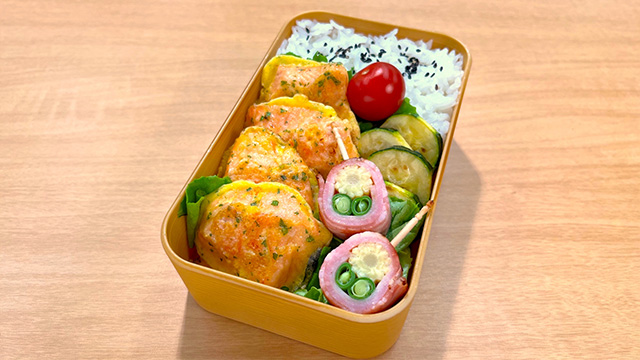
- BENTO RECIPES
- from Episode 5 / Season 8.
- Salmon Piccata Bento
- (761 kcal)
-
 by Maki Ogawa
by Maki Ogawa
Bento contents:
- Rice
- Salmon Piccata
- Bacon Roll Blossoms
- Sautéed zucchini
- Lettuce
- Cherry tomatoes
- Black sesame seeds
Ingredients:
Makes enough to pack into 2 bentos
For the Salmon Piccata
- 2 fillets coho salmon
- 1 tbsp flour
- 1 egg
- 1-1.5 tbsp vegetable oil
- 1/2 tbsp (10 g) mayonnaise (preferably Japanese)
- A little parsley
- A pinch of salt and pepper
- Ketchup, as needed
- 1 tbsp (7 g) powdered cheese
For the Bacon Roll Blossoms
- 1 slice bacon
- 1 baby corn
- 1 green bean
Directions:
For the Salmon Piccata
1. Debone the salmon and cut into bite-size pieces. Pat dry with paper towels.
2. Season with salt and pepper and dust both sides with flour.
3. Beat the egg in a small bowl. Add the mayonnaise, powdered cheese, and chopped parsley and mix well.
4. Dip the salmon in the egg mixture.
5. Heat the frying pan and fry both sides of the salmon over low to medium heat for about 5-6 minutes until golden brown. Pack into the bento along with some ketchup.
For the Bacon Roll Blossoms
1. Boil and cut the green bean in half. Place the green bean pieces and baby corn on top of a slice of bacon.
2. Roll up and secure the end with a toothpick.
3. Fry the rolls in the pan used to fry the piccata and zucchini.
4 .Cut in half and pack into the bento.
-
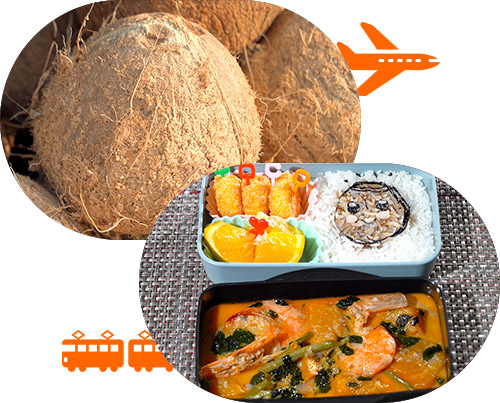
- BENTO TOPICS
- from Episode 5/ Season 8.
- The Philippines
-
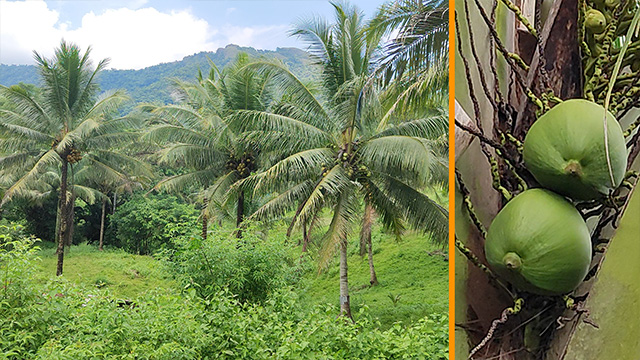
Bento Topics. Today, from the tropical nation of the Phillipines in Southeast Asia. It’s one of the world’s largest producers of coconuts, which are an essential part of the local diet.
-
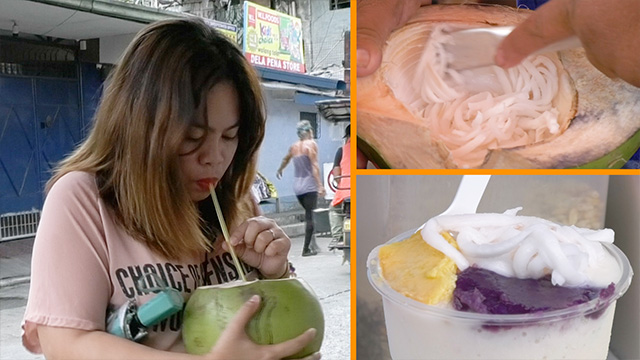
Coconut drink stalls can be found just about everywhere. Buko, or green young coconut, hold water which is packed with minerals. It’s a popular natural "sports drink." The sweet white flesh is used as a topping for the national dessert, halo-halo.
-
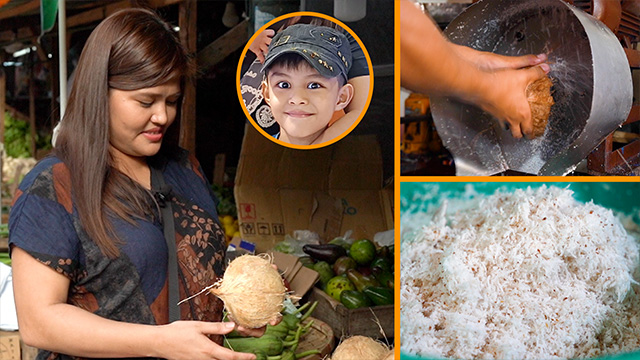
Ripe coconuts, distinguished by their brown and hairy surface, are widely used in cooking.
Charie began making cute bentos to encourage her son Braven to eat vegetables. Today, she’s making a coconut bento with loads of shredded coconut and vegetables.
-
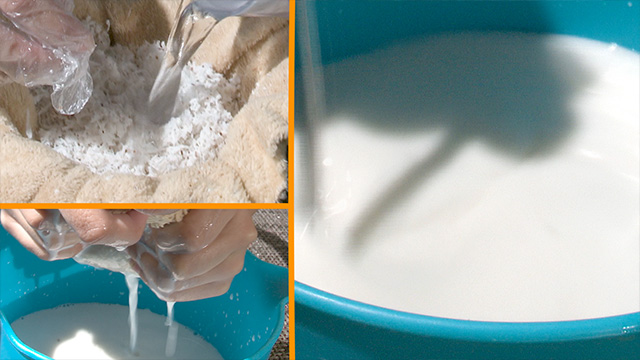
She’s going to make coconut milk stew using a recipe that’s been handed down in her family. She starts off by straining a mixture of grated coconut and warm water to make coconut milk from scratch.
-
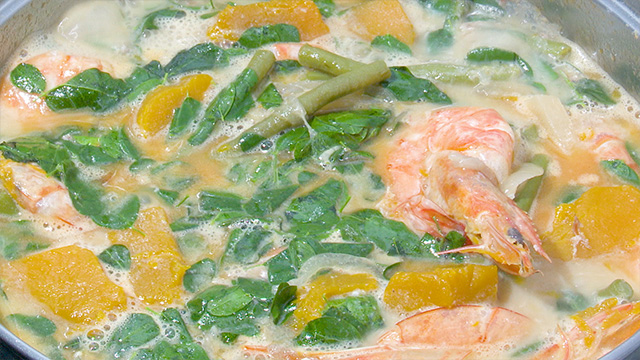
She simmers kabocha squash and green beans in the milk. They’re infused with the aroma of coconut! She then adds shrimp and moringa, a protein-rich herb. It's an essential ingredient in her family’s stew.
-
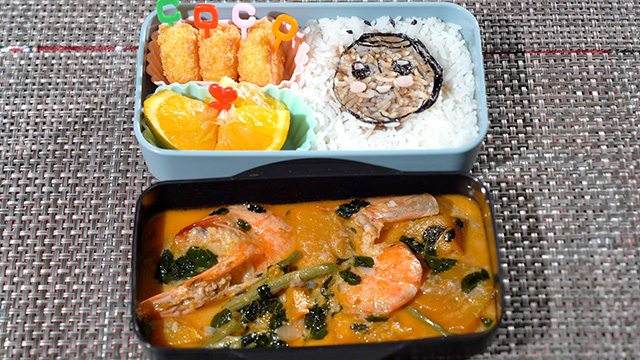
For dessert, she packs coconut macaroons made with shredded coconut and condensed milk. And last but not least, she makes a cute coconut face on rice using nori and soy sauce. This adorable bento helped her son to enjoy eating vegetables!
-
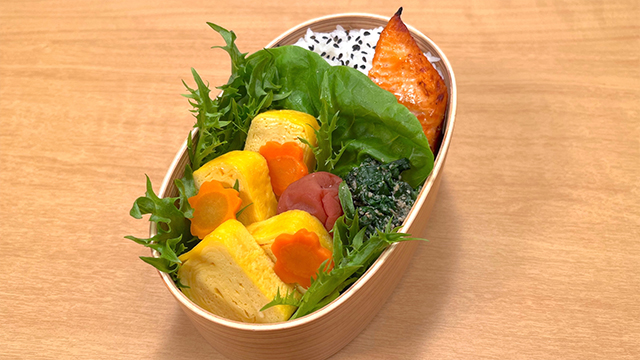
- BENTO RECIPES
- from Episode 4 / Season 8.
- Tamagoyaki Bento
- (487 kcal)
-
 by Marc Matsumoto
by Marc Matsumoto
-
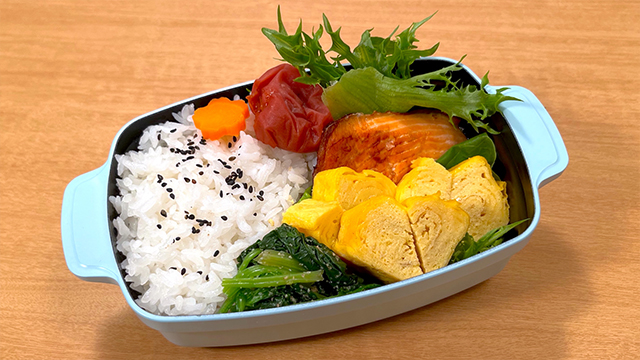
-
 by Arisa Adams
by Arisa Adams
- (447 kcal)
Bento contents:
- Tamagoyaki
- Umeboshi with red shiso
- Flower-shaped carrots
- Black sesame seeds
- Spinach goma-ae
- Butter lettuce
- Frill lettuce
Ingredients:
Makes enough to pack into 2 bentos
- 2 tsp sugar
- 1 tsp potato starch
- 2 tbsp water
- 1 tsp usukuchi soy sauce
- 4 large eggs (about 60 grams each)
- 1 tsp vegetable oil
Directions:
1. Add the sugar, potato starch, water, and soy sauce to a bowl with a spout and whisk together until the liquid is free of lumps.
2. Break the eggs into the bowl with the seasonings, then beat them with chopsticks until uniform in color.
3. Heat a tamagoyaki pan over medium-low heat until hot. Add the oil, then use a paper towel to wipe the oil around the pan, removing any excess beads of oil.
4. Pour enough of the egg mixture into the pan to cover most of the bottom of the pan. Swirl it around if necessary to cover the pan evenly.
5. When the egg is mostly set, use a spatula to start rolling the egg to one side of the pan. Once it's rolled up, give it a few presses on top and on the sides to give it a nice shape.
6. Move the roll to the other side of the pan and repeat the last two steps until you run out of the egg mixture.
7. Remove the tamagoyaki from the pan and let it cool to room temperature.
-
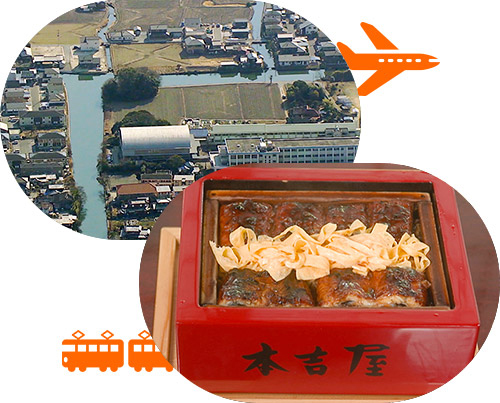
- BENTO TOPICS
- from Episode 4/ Season 8.
- Yanagawa
-
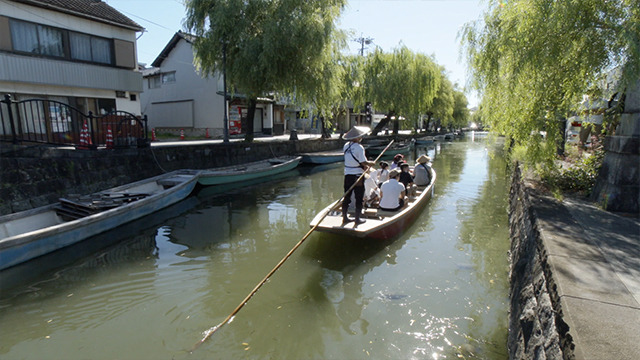
Bento Topics. Today, from Yanagawa in Fukuoka. It's a beautiful castle town famous for its network of canals totalling 930 kilometers in length.
River cruises are a great way to enjoy the area's scenic views. -
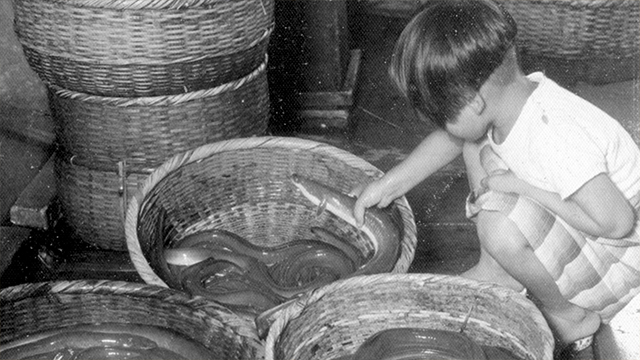
The canals used to be teeming with eels, which is why Yanagawa became famous for its eel cuisine. Today, there are still nearly 30 restaurants specializing in eel.
-
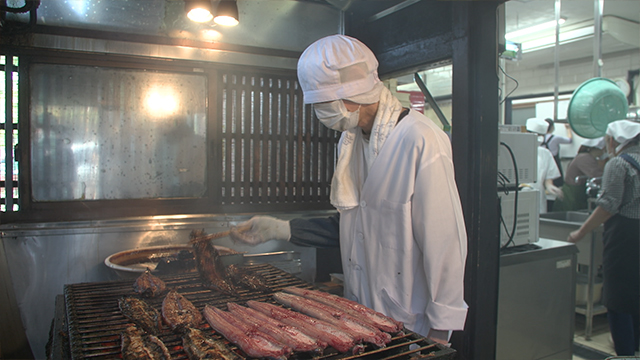
Seiro-mushi is a cooking method that involves steaming. Here, a steamed bento of grilled eel over rice is a favorite for special occasions.
First, the filleted eels are grilled over charcoal.
-
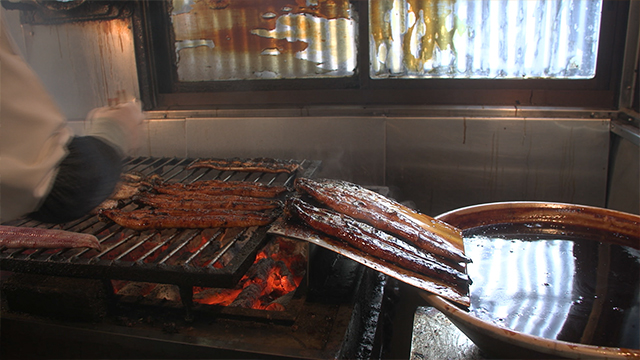
While grilling, the eel is dipped several times in a sweet and savory sauce made with a soy sauce unique to this region. Multiple basting is key to cooking the eel so that it’s bursting with flavor. The original sauce has been replenished for generations.
-
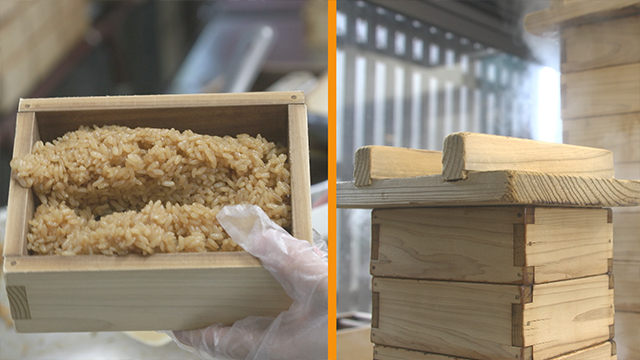
The sauce is also used to season the rice, which is then steamed to seal in the flavor. The rice is then topped with grilled eel and thinly shredded egg omelet before being steamed again. The second steaming allows the rice to absorb the umami-rich sauce.
-
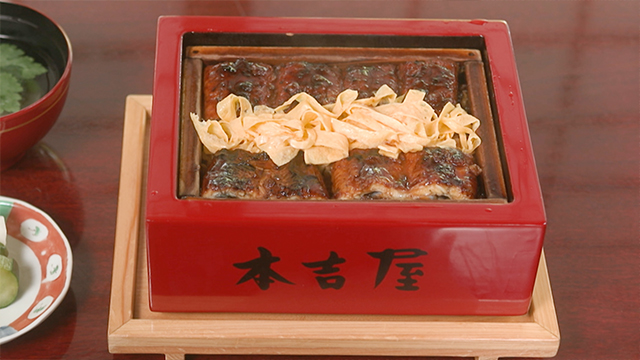
This seiro-mushi bento that incorporates the flavors of the eel, sauce, and rice into every mouthful. No wonder that it’s eaten on special occasions.
-
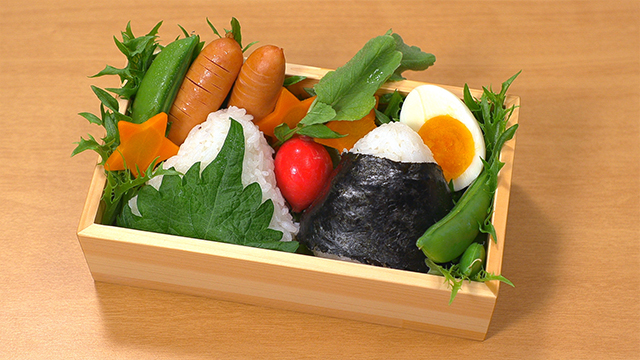
- BENTO RECIPES
- from Episode 3 / Season 8.
- Onigiri Bento
- (594 kcal)
-
 by Marc Matsumoto
by Marc Matsumoto
-
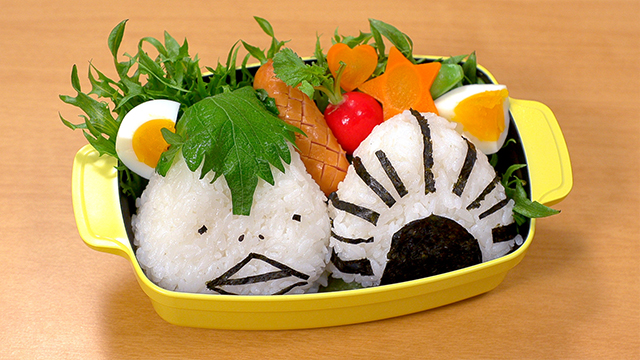
-
 by Arisa Adams
by Arisa Adams
- (744 kcal)
Bento contents:
- Onigiri
- Boiled egg
- Sausage
- Snap peas
- Radish
- Carrot
- Frill lettuce
Ingredients:
Yields 3-4 onigiri
For rice:
- 1 rice cooker cup of rice
- Sea salt
For filling (examples)
- Tuna Mayo
- 1 tbsp mayonnaise
- 1 tsp miso
- 70 g can of tuna
- 1 tsp toasted sesame seeds
- Umeboshi
- Salted salmon flakes
- Shio konbu
- Katsuobushi with soy sauce
For wrapper (examples)
- Nori
- Leaves (such as shiso or pickled mustard greens)
Directions:
For Onigiri
1. Spread a piece of plastic wrap on a work surface and then sprinkle a pinch of salt onto the plastic. Scoop 40 grams of rice into the center of the wrap and then add your chosen filling into the center of the rice.
2. Top with another 40 grams of rice, then gather the edges of the plastic wrap around the rice.
3. Pick the wrap up with your hands, then cup one hand into a U shape and the other into a V shape and gently press the onigiri into a triangle shape.
4. Unwrap the onigiri, then wrap it with nori or a leaf to finish.
For Tuna Mayo
1. Mix the mayonnaise and miso in a small bowl until evenly mixed.
2. Drain the tuna in a strainer and press on it to squeeze out as much liquid as possible.
3. Add the drained tuna to the bowl with the sauce and the toasted sesame seeds, and then stir until combined.
-

- BENTO TOPICS
- from Episode 3/ Season 8.
- Misaki
-

Today, from Misaki in Kanagawa, a port town that has long prospered as a base for deep-sea fishing. It’s famous for its tuna.
-
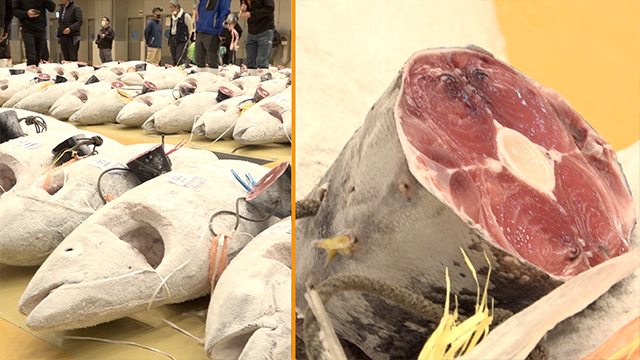
The tuna are frozen at sea to maintain quality. They're icy-white in appearance. At the auction, wholesalers check the tail section of each fish for quality before making their selections. Tuna is sweet and full of umami, making it a popular fish worldwide.
-
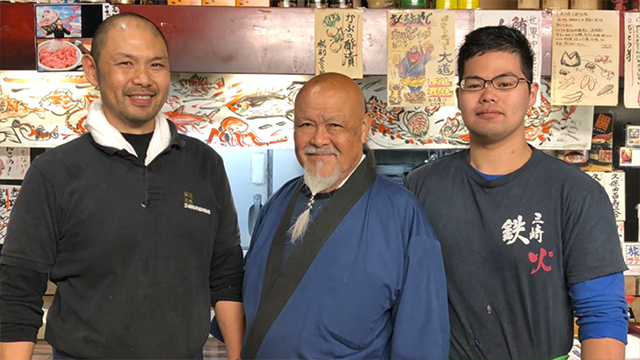
Misaki is home to one popular restaurant that serves a variety of tuna dishes. Yamada Yoshio was born into a family of fishers. He and his family opened this restaurant 52 years ago. His son and grandson also work at the restaurant, following in his footsteps.
-
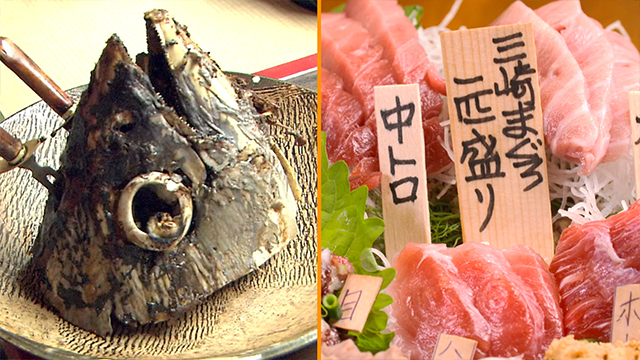
The restaurant’s menu includes over 200 dishes. But they don't just serve the typical toro, or fatty belly. They also offer tuna roe and offal, which rarely make their way to market. The restaurant’s specialty is a dish of roasted tuna head.
-
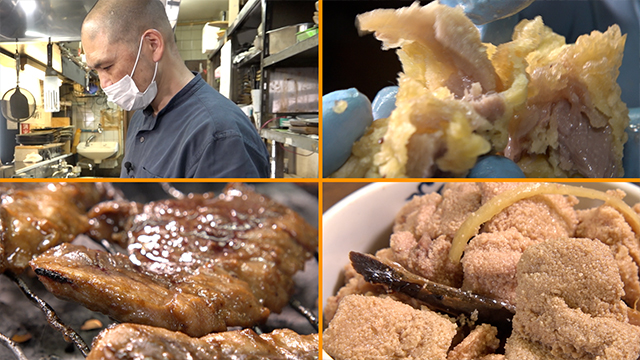
Their specialty bento is packed with various dishes made with rare tuna parts. One highly nutritious and chewy section is marinated in a special miso sauce and grilled. The fatty part of the tail section is deep-fried. Tuna roe, a favorite of fishers, is simmered with ginger and other seasonings in dashi.
-
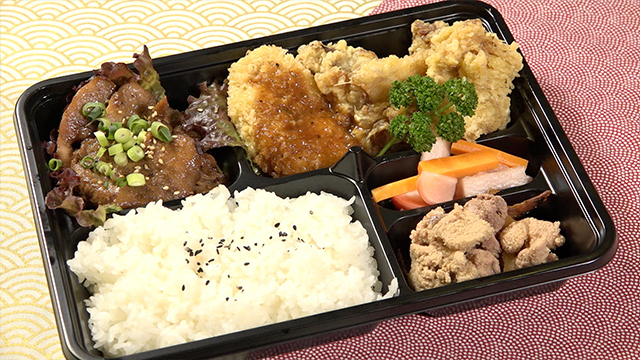
Ingenuity and tradition are packed into this tuna bento that showcases the potential of the fish to the fullest.
-
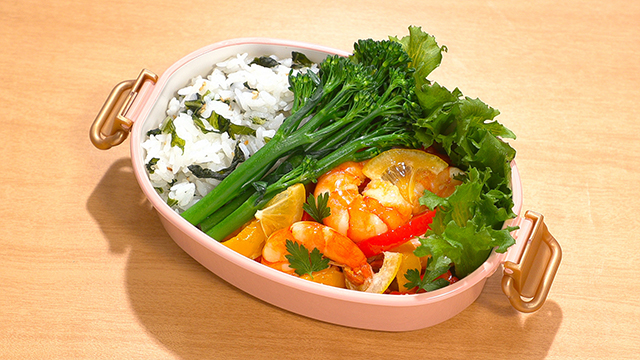
- BENTO RECIPES
- from Episode 2 / Season 8.
- Lemon-marinated Shrimp Bento
- (415 kcal)
-
 by Marc Matsumoto
by Marc Matsumoto
Bento contents:
- Lemon-marinated Shrimp
- Pickled Mustard Green Rice (Using Hiroshima-na pickles)
- Stick broccoli
- Frill lettuce
- Small flat-leaf parsley
Ingredients:
Makes enough to pack into 2 bentos
For Lemon-marinated Shrimp
- 1 tbsp lemon juice
- 1/4 lemon, sliced thinly
- 1/2 tsp salt
- 1/4 cup (about 60 ml) olive oil
- 10 g garlic, thinly sliced
- 160 g bell peppers
- 190 g peeled shrimp (21/25 size)
For Pickled Mustard Green Rice
- 345 g cooked short-grain rice
- 40 g pickled mustard greens, finely chopped
- 2 tsp toasted sesame seeds
Directions:
For Lemon-marinated Shrimp
1. Add the lemon juice, sliced lemon, and salt to a bowl. Stir to combine.
2. Add the olive oil, garlic and bell peppers to a frying pan and fry over medium-low heat until the peppers are soft and the garlic has browned.
3. Add the shrimp and fry until the shrimp are cooked through.
4. Pour everything into the bowl with the lemon and toss to combine. Let the mixture marinate overnight.
For Pickled Mustard Green Rice
1. Add the chopped pickled mustard greens and toasted sesame seeds to the hot cooked rice and fold them into the rice until evenly mixed.
-
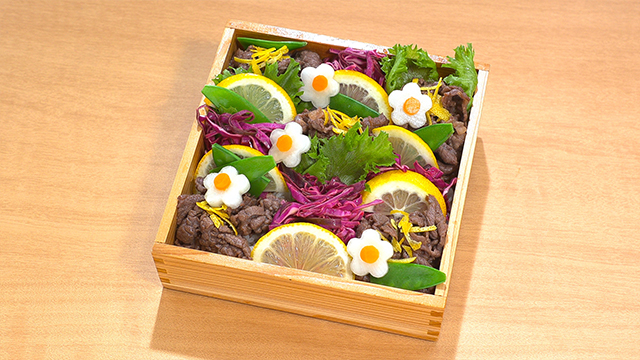
- BENTO RECIPES
- from Episode 2 / Season 8.
- Lemon Chirashi-zushi Bento
- (Total 1146 kcal)
For 1 adult and 1 kid to share -
 by Maki Ogawa
by Maki Ogawa
Ingredients:
For Chirashi-zushi rice
- 250 g rice
- 1 tbsp white sesame seeds
- 3.5 g shredded lemon zest
- 1.5 tbsp lemon sushi vinegar for rice
- 2 tbsp lemon juice
- 1 tbsp sugar
- A pinch of salt
(Dissolve the sugar and salt in the juice)
For the Chirashi-zushi ingredients
- Lemon sushi vinegar for marinate
- 2 lemons
- 2 tsp sugar
- 5 snow peas (or 20 g)
- 35 g red cabbage
- A little bit of lettuce
- 20 g daikon radish
- A little bit of carrot
- 5 g lemon zest
- 120 g thinly sliced beef
- 2 tsp each of sugar, sake, and soy sauce
Directions:
1. Toss the freshly cooked rice with 1 tbsp sesame seeds, 3.5 g lemon zest and 1.5 tbsp lemon sushi vinegar to make the sushi rice.
2. Cut the lemon into thin slices.
3. Parboil the snow peas for about a minute and cut in half.
4. Cut the daikon and carrot into thin slices. Use a flower-shaped cookie cutter to cut out daikon flowers. Marinate the carrot and daikon in lemon sushi vinegar (1.5 tablespoon lemon juice and 2 teaspoon sugar) for about 20 minutes.
5. Shred the cabbage, then marinate for about 20 minutes.
6. Mix the sugar, sake, and soy sauce in a frying pan and bring to a boil. Add the beef and simmer over medium to low heat until there is almost no liquid.
7. Lay the beef over the sushi rice.
8. Place the pickled cabbage in between the beef.
9. Top with lemon slices, snow peas, and lettuce.
10. Use a straw to cut out rounds from the quick-pickled carrot. Place in the center of the daikon flowers and decorate the rice.
11. Sprinkle shredded lemon zest over the beef.
- Hiroshima Special
- from Episode 2/ Season 8.
-

Today, we travel to Hiroshima Prefecture in western Japan. It's home to about 55,000 foreign residents. We take a look at some of their bentos!
Fatoumata, from Côte d'Ivoire, is a student at Eikei University of Hiroshima. She makes a bento full of foods from home to share with her classmates and teacher. -
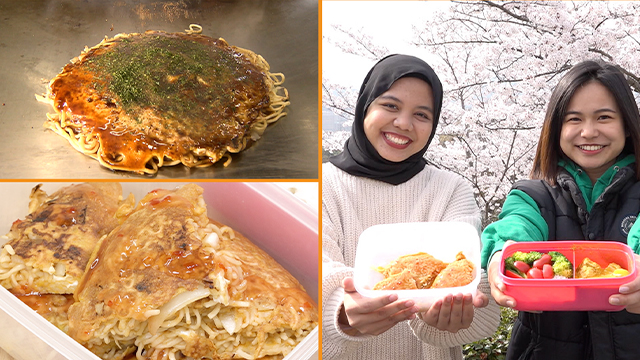
Fadhlina and Chong are students at Hiroshima City University. Together, they make a bento to help ease their feelings of homesickness. They make an all-time favorite: spicy turmeric chicken curry. They also make a savory pancake called murtabak maggie, made with instant noodles, egg, onion, and curry powder. It bears a striking resemblance to Hiroshima okonomiyaki!
-
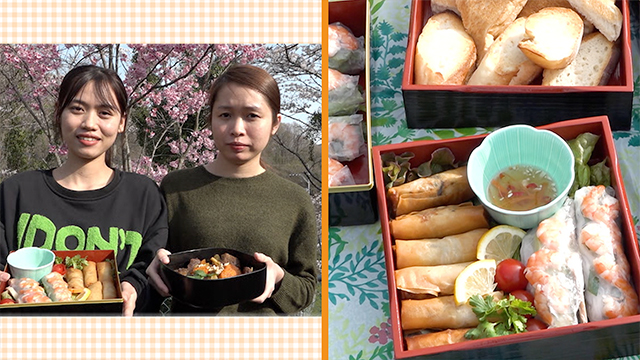
Fukuyama City has a thriving shipbuilding industry. Tram and Zao, from Vietnam, work at a nursing home here. They make a bento for a staff picnic under the cherry blossoms.
-
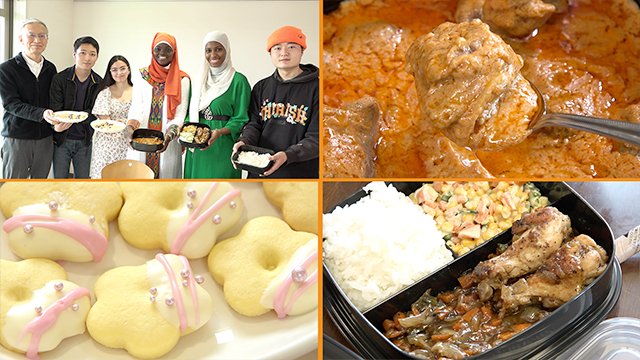
Fatoumata uses peanut sauce in her bento. Peanut sauce is a staple of the food culture in West Africa. Not only is it cheap, it's also nutritious and tasty. The peanut sauce is added to a stew made with beef and tomato sauce. It's the taste of home!
-
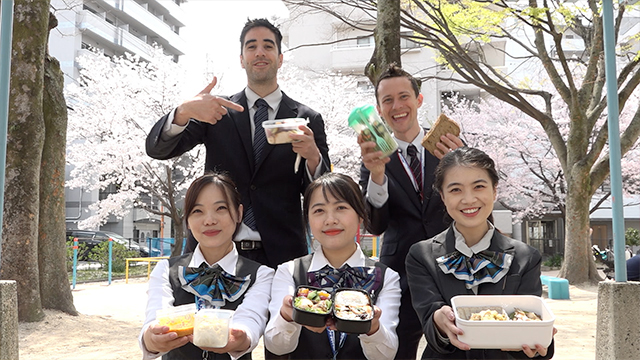
This group of bento makers works at a real estate firm in Hiroshima City, helping foreign residents to find homes. Each of their bentos contains different specialties from home, from Vietnamese fried spring rolls, to Chinese tomato and egg, to Nepalese dumplings, to an American peanut butter and banana sandwich. They enjoy their bentos on a picnic under the cherry blossoms.
-
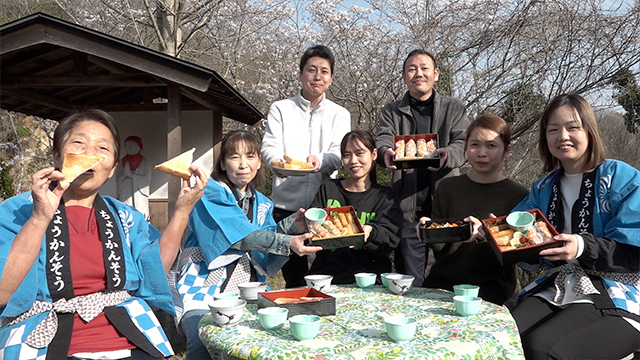
Spring rolls made with clear rice paper show off the fillings, like shrimp and veggies. Their stew features lots of tasty herbs and spices.
The group of close-knit coworkers enjoys a hanami picnic together!
-
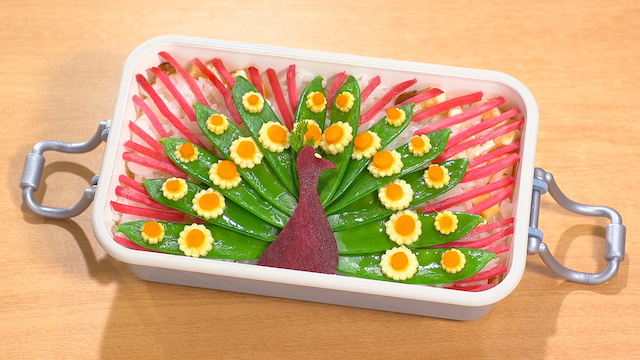
- BENTO RECIPES
- from Episode 1 / Season 8.
- Chirashi-zushi Peacock Bento
- (494 kcal)
-
 by Marc Matsumoto
by Marc Matsumoto
Ingredients:
For Chirashi-zushi rice
Makes enough to pack into 3-4 bentos
- Sushi vinegar
- 4 tbsp rice vinegar
- 3 tbsp sugar
- 1 tsp salt
- 6 g dried shiitake mushrooms
- 310 g short-grain rice (2 rice cooker cups)
- 120 ml water
- 80 g abura-age, cut into 1/4-inch squares
- 65 g cooked bamboo shoots, cut into a small dice
- 4 tbsp shiitake soaking liquid
- 2 tbsp sake
- 1 tsp sugar
- 1/2 tsp salt
For topping
- 1 purple carrot
- 2 pieces boiled baby corn
- 50 g small snow peas, trimmed (7-8 cm)
- 2 yamagobo pickles (pickled burdock)
- 3 sesame seeds
- 1 sprig chervil
- Benishoga (red pickled ginger)
Directions:
For Chirashi-zushi rice
1. Add the dried shiitake mushrooms to a bowl and cover with boiling water. Soak until the mushrooms have rehydrated. Once the mushrooms have rehydrated, squeeze out excess water and reserve the soaking liquid. Trim the stems off and discard, then chop up the caps.
2. Wash and cook the rice using 3 tablespoons less water than you would normally use in a rice cooker. Alternatively, you can cook the rice on the stovetop in 1.5 cups (355 milliliters) of water using the boil/simmer/steam method.
3. While the rice is cooking, make the sushi vinegar by mixing the rice vinegar, sugar, and salt until everything is dissolved.
4. Add the chopped shiitake mushrooms, abura-age, bamboo shoots, 4 tablespoons soaking liquid from the shiitake, sake, sugar, and salt to a pan. Cook the ingredients together until there is no liquid left in the pan. Turn off the heat and set this aside until the rice is done.
5. When the rice is steamed, transfer it to a large bowl and drizzle the sushi vinegar mixture over the rice. Fold the mixture together while fanning it to evaporate any excess liquid.
6. Once the rice is no longer hot, add the shiitake and fried tofu mixture to the rice and fold it in.
Assemble the Bento
1. To make the body for the peacock, cut about 3 inches off the top of the carrot (the thick end). Peel the carrot, trim the top off, then slice one side off the carrot to make a flat edge. Then use a mandoline to slice a few thin sheets of carrot.
2. Bring a pot of water to a boil and boil the baby corn until cooked.
3. Use the same water to blanch the snow peas, then chill them rapidly in ice water.
4. Finally, boil the carrot slices until they are no longer raw, but are still firm (about 30 seconds).
5. Cut thin slices from both the thick and thin ends of the baby corn to make the base for the spots on the feathers.
6. Cut thin slices from both the thick and thin ends of the yamagobo pickles to make the center of the spots for the feathers. You can cut rounds from thinly sliced boiled orange carrots using 2 different sizes of straws.
7. Stack the large slices of yamagobo onto the large slices of baby corn and the small slices of yamagobo onto the small slices of baby corn.
8. To make the peacock's body, use kitchen scissors or a sharp paring knife to cut the slices of purple carrot into an oblong shape with a beak.
9. Brush the slice of carrot with oil to keep it from drying out.
10. To assemble the bento, spread a layer of chirashi-zushi in a bento box and flatten the top.
11. Fan out the snow peas starting from the left and right sides on the bottom and working your way towards the center of the top.
12. Top each snow pea with 1 large baby corn stack and 1 small one.
13. Place the peacock's body at the base of the fan of snap peas.
14. Add a sesame seed for an eye, then top the head with a tuft of chervil to make the crest.
15. Fill in the space around the peacock with benishoga.
-
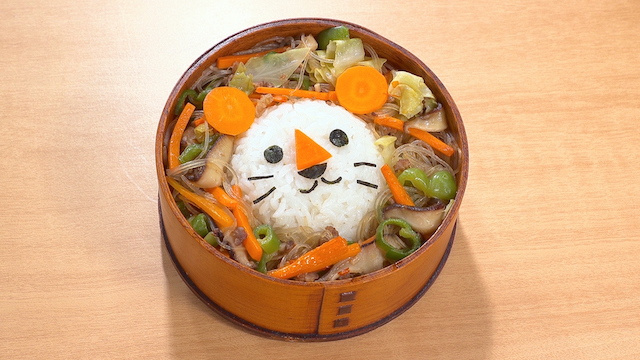
- BENTO RECIPES
- from Episode 1 / Season 8.
- Glass Noodle Lion Bento
- (693 kcal)
-
 by Maki Ogawa
by Maki Ogawa
Bento contents:
- Rice
- Glass noodles stir-fried with pork and vegetables
Ingredients:
For the Glass noodles stir-fried with pork and vegetables
- 35 g mung bean glass noodles
- 80 g coarse ground pork
- 35 g carrot
- 1 shiitake mushroom (or 10 g)
- 1 green bell pepper (or 25 g)
- 25 g cabbage
- 1 clove garlic
- A pinch of minced ginger
- 1/2 tsp doubanjiang
- 150 ml water
- 1 tsp granulated chicken soup
- 1 tsp soy sauce
- 1 tsp sugar
- 1 1/2 tsp oyster sauce
- 1 tbsp sake
For the lion face
- Carrot
- Nori
Directions:
1. Mince the garlic and ginger. Cut the carrot, bell pepper, shiitake, and cabbage into thin strips.
2. Oil the pan and stir-fry the carrot, bell pepper, and cabbage until tender. Transfer to a tray.
3. Add more oil to the pan and stir-fry the garlic, ginger, and doubanjiang until fragrant. Add the ground pork and shiitake and continue to stir fry until the color of the pork has changed. Add the water, granulated chicken soup, soy sauce, sugar, oyster sauce, sake, and glass noodles. Simmer over medium heat for 2 and 1/2 minutes until the noodles are cooked through. Add the fried vegetables and simmer for 30 more seconds.
4. Set aside to cool, allowing the noodles to soak up the soup.
5. Use a spoon to twirl the noodles into bite-size pieces and place around the rice to form the lion’s mane.
6. Make the lion’s face with carrot and nori.
-
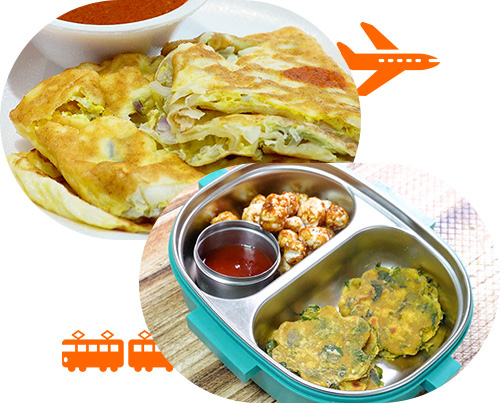
- BENTO TOPICS
- from Episode 1/ Season 8.
- Singapore
-

Today, we visit the diverse nation of Singapore. Indians make up the third largest ethnic group in Singapore. Many of them live in Little India, an area that's home to a century-old Hindu temple embellished with beautiful carvings and a bustling market.
-
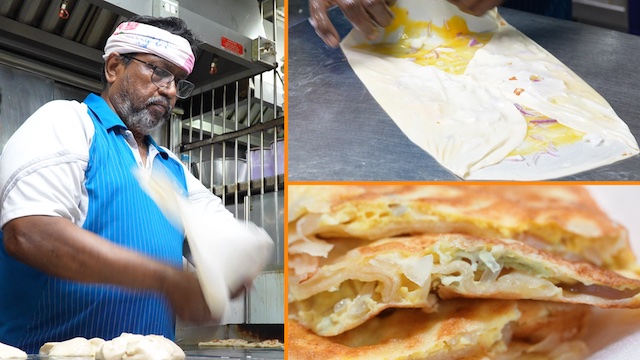
At the market, many hawkers serve Indian dishes. One of the most popular is paratha, a fried flatbread. The thin, flour-based dough is topped with eggs and onions or other vegetables, then folded and cooked. The outside is crispy, and the inside is soft and fluffy. It's a classic Indian favorite.
-
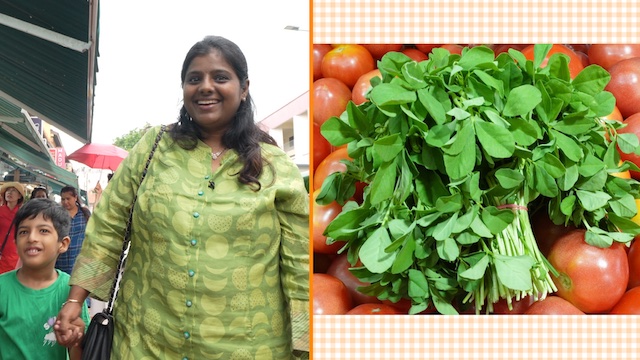
Bento maker Anuradha hopes to remind her son Aarav of his Indian heritage by making him healthy Indian bentos. She began posting her recipes online two years ago, and now has more than 60,000 followers. Today, Anuradha and Aarav use methi (fenugreek) to make their paratha.
-
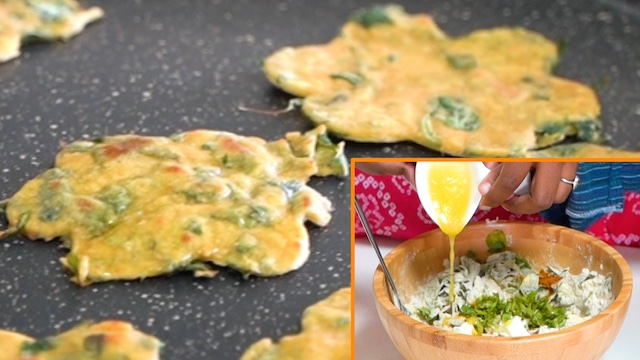
Anuradha uses a family recipe to make her paratha. She mixes the methi into the dough along with spices to bring out the bitter flavor of the methi. She also mixes in ghee, a clarified butter. They cut the dough into the shape of a flower before frying each side to a golden brown.
-
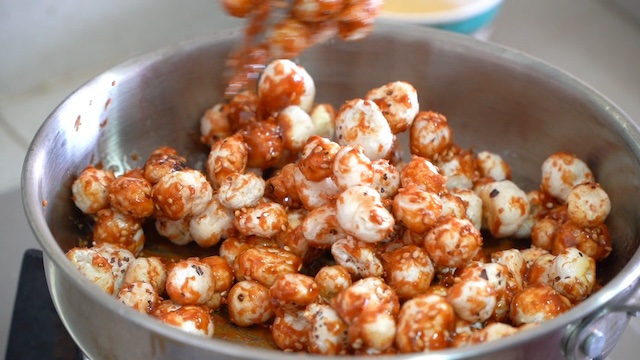
Next, they prepare a healthy snack of fox nuts caramelized in unrefined cane sugar. It looks just like caramel popcorn!
-
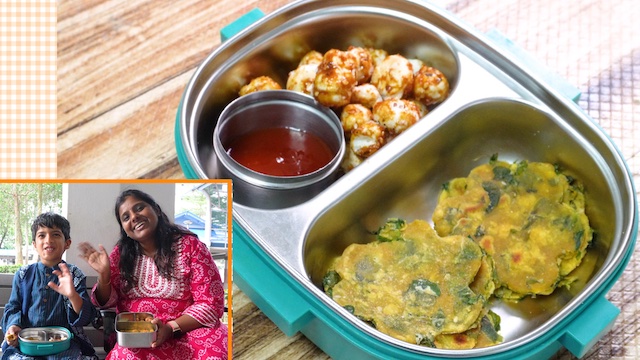
Aarav likes to eat his methi paratha with ketchup. Their healthy Indian bento is complete. Enjoy!



